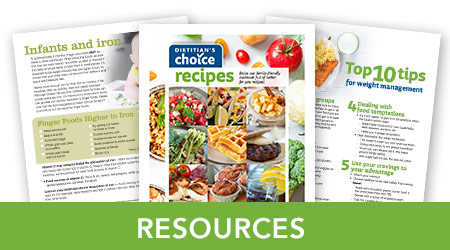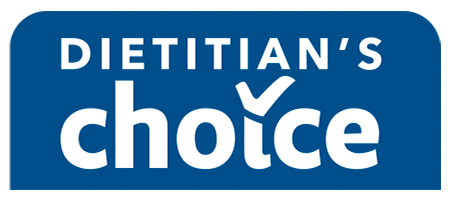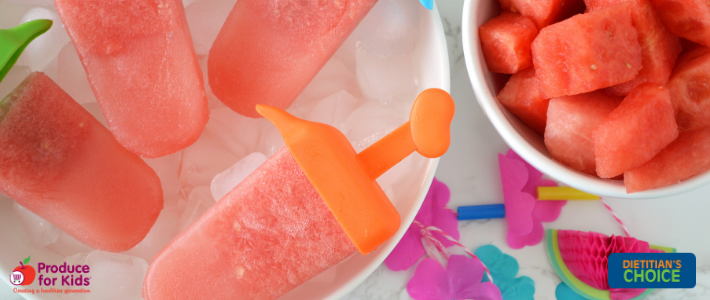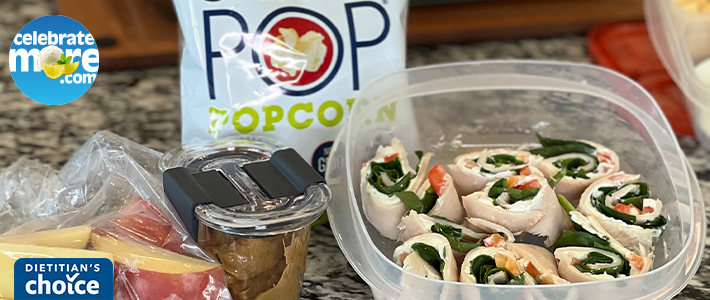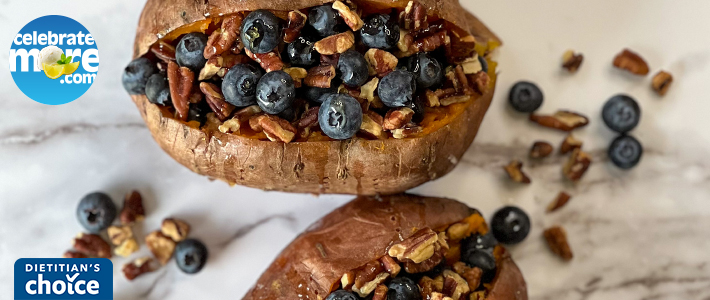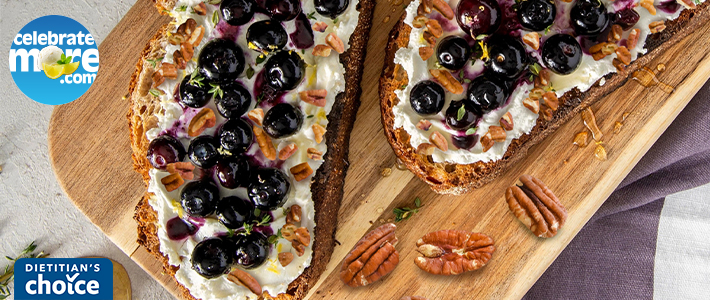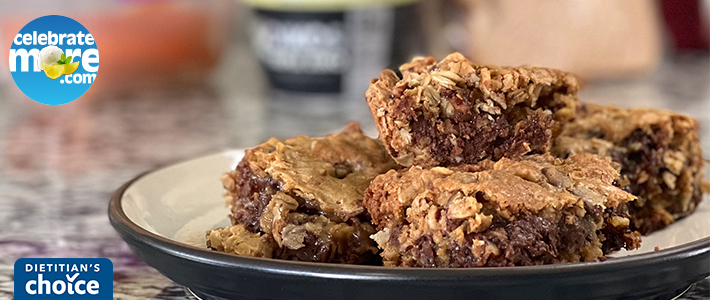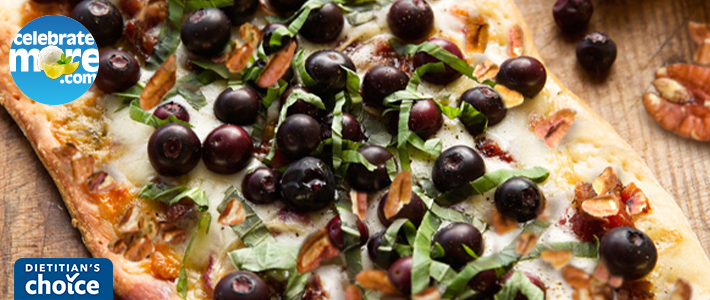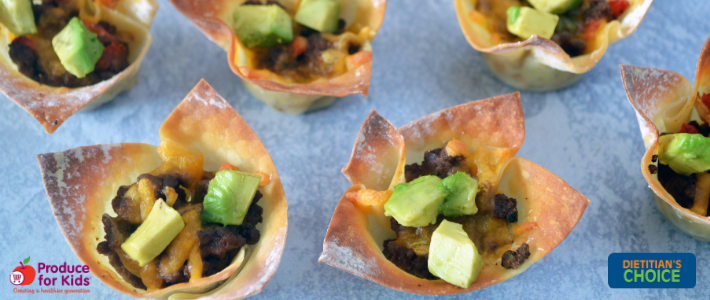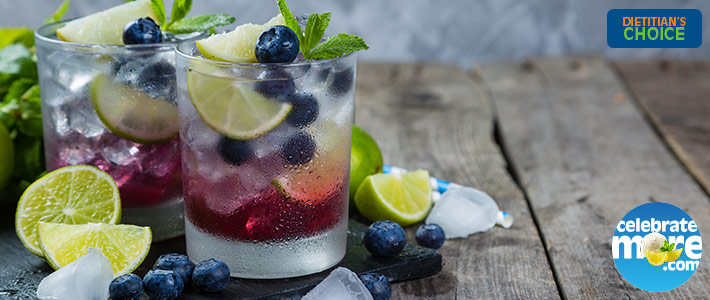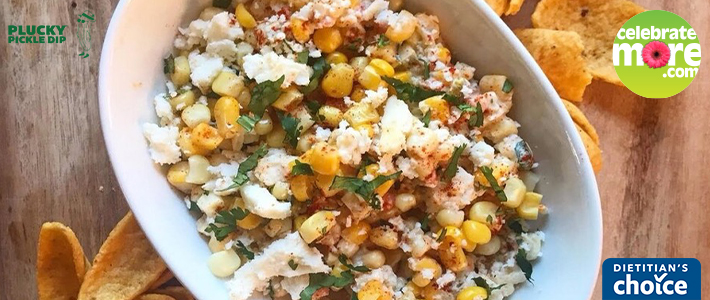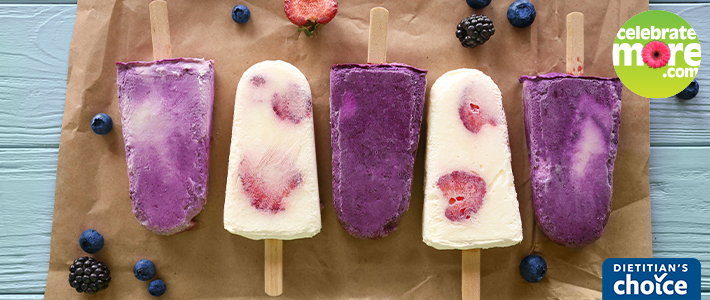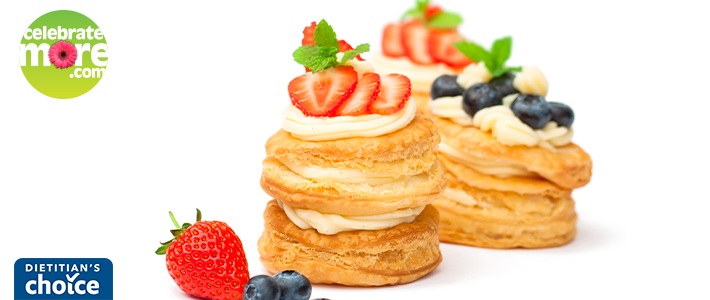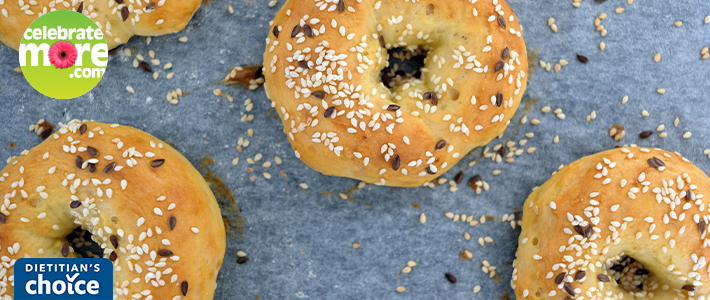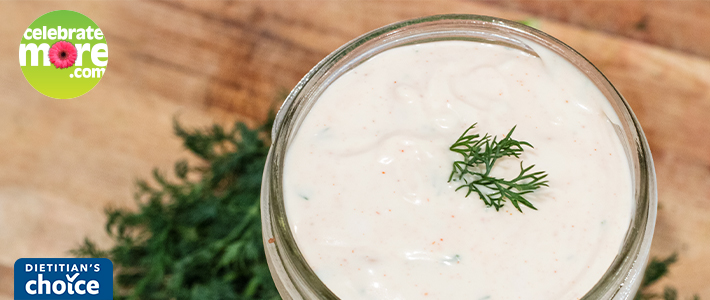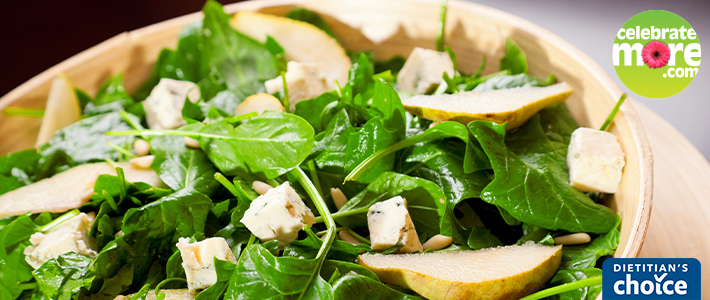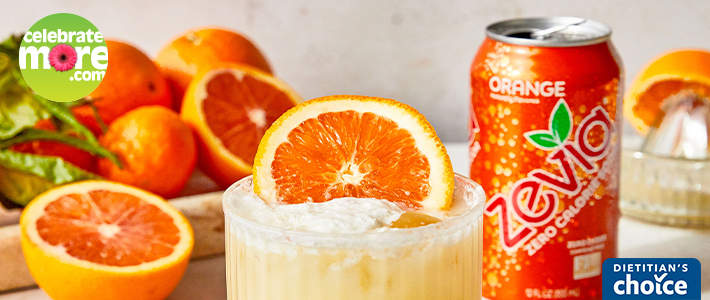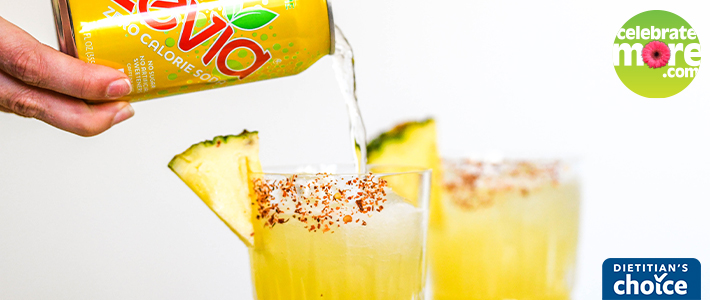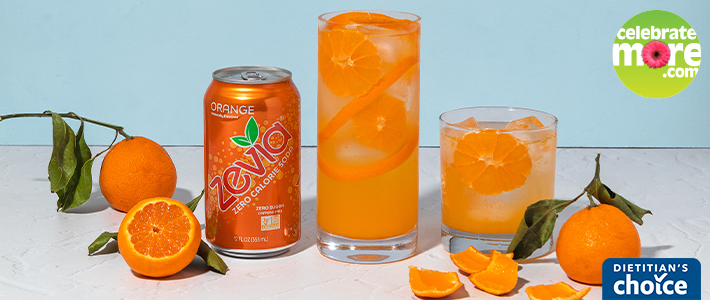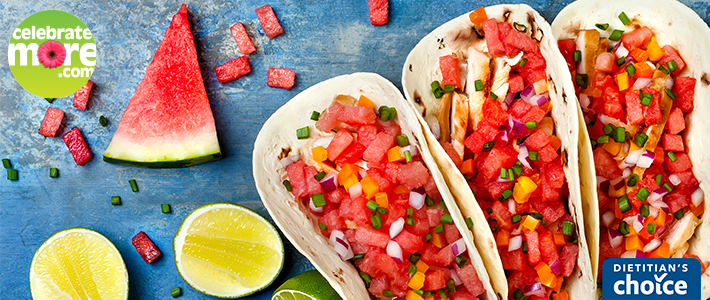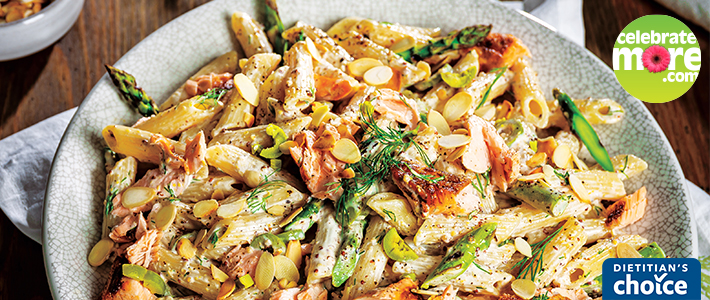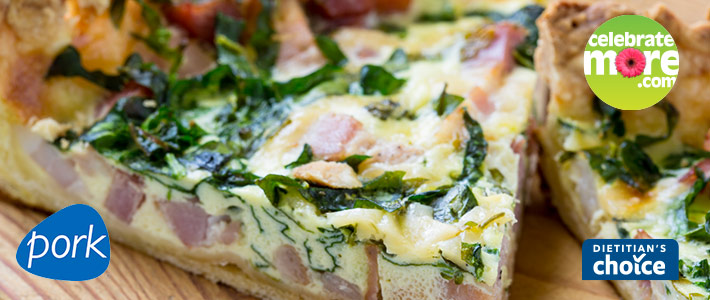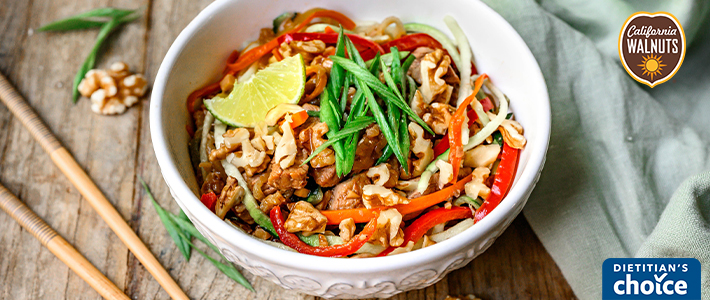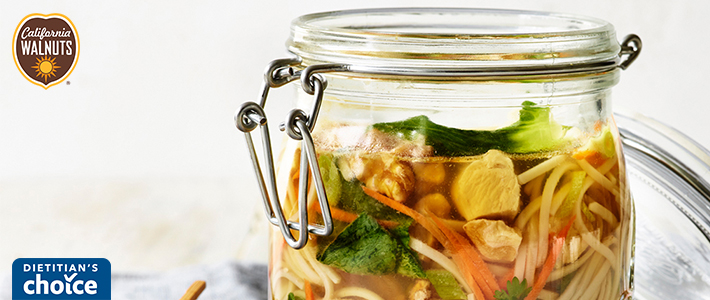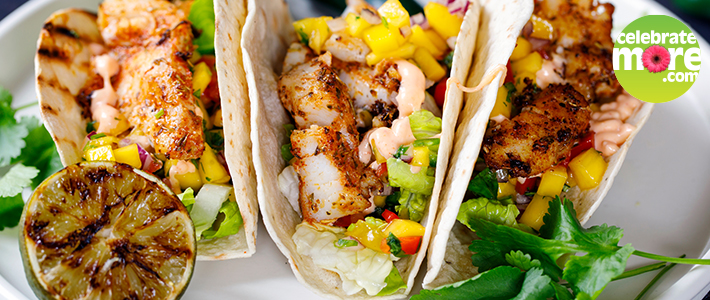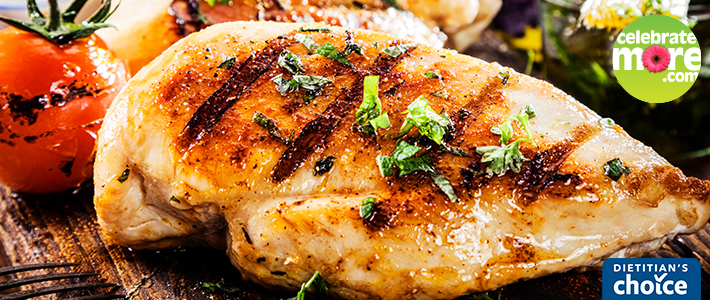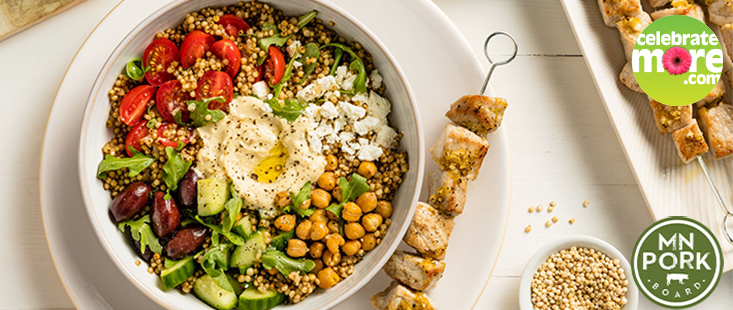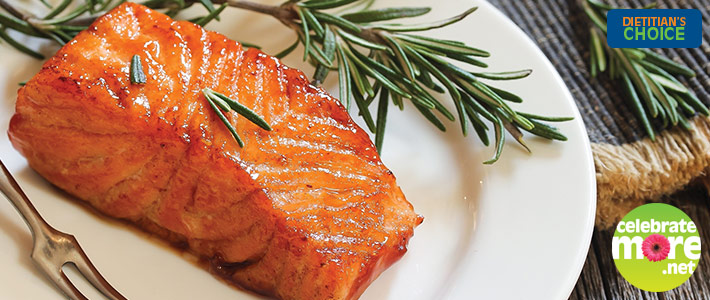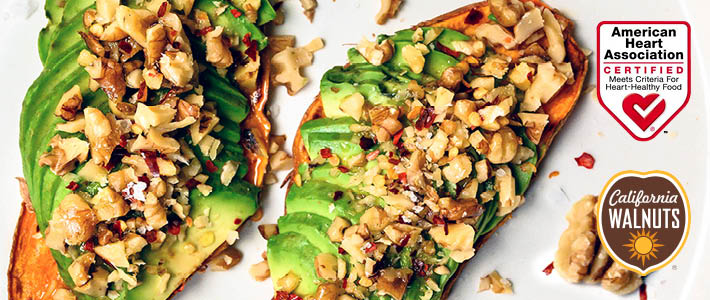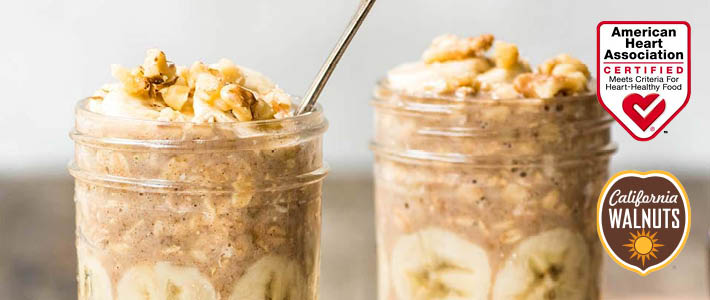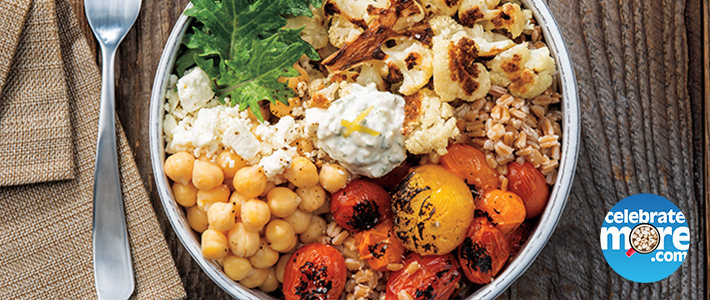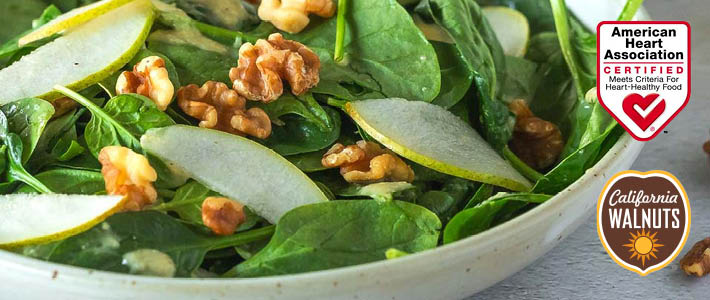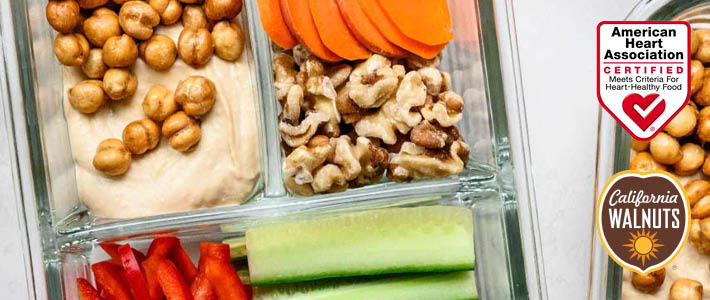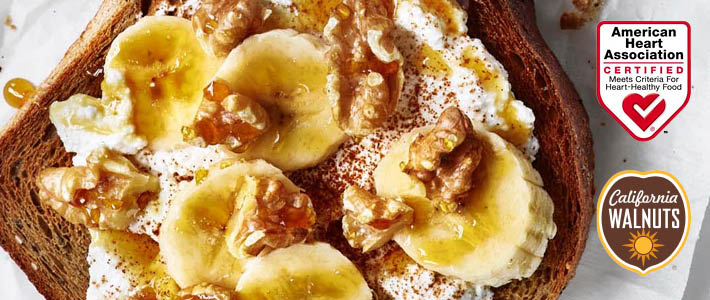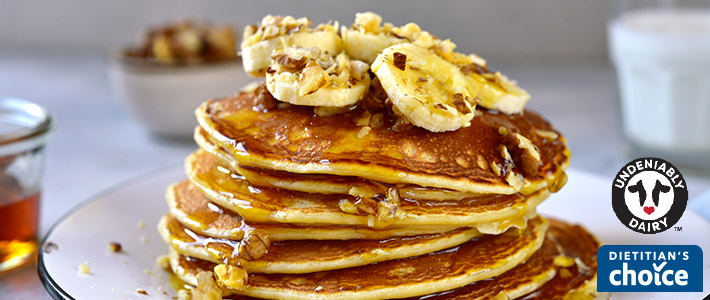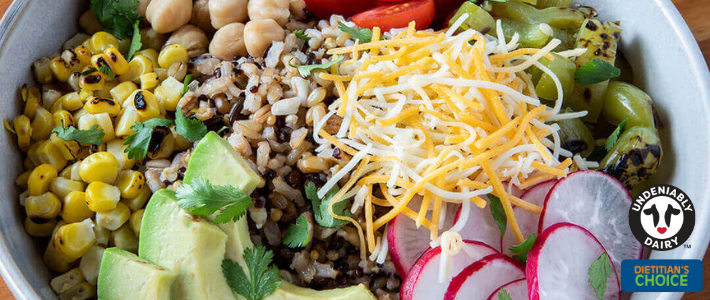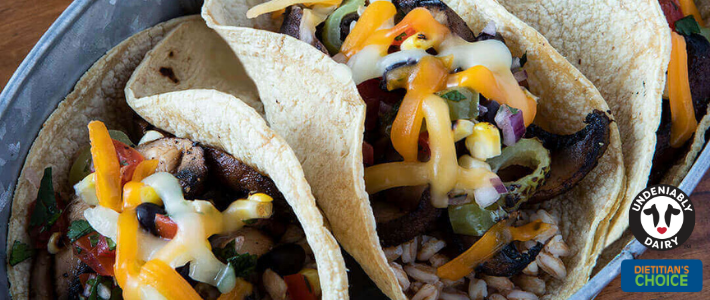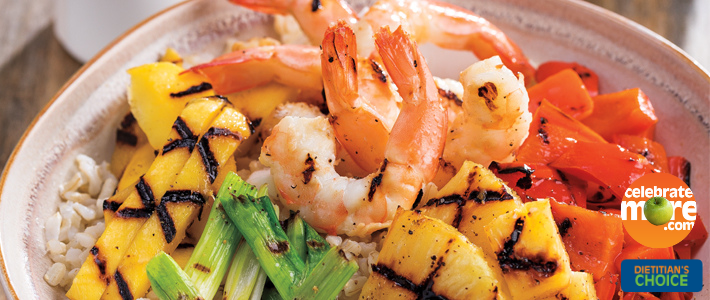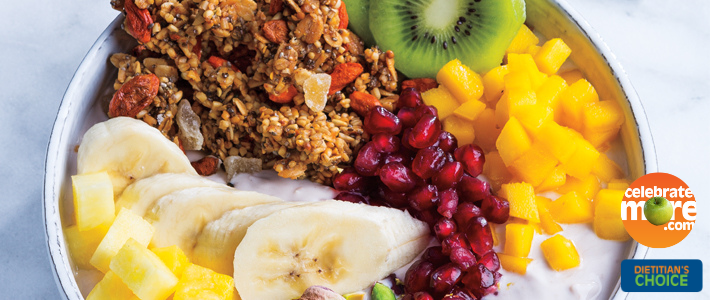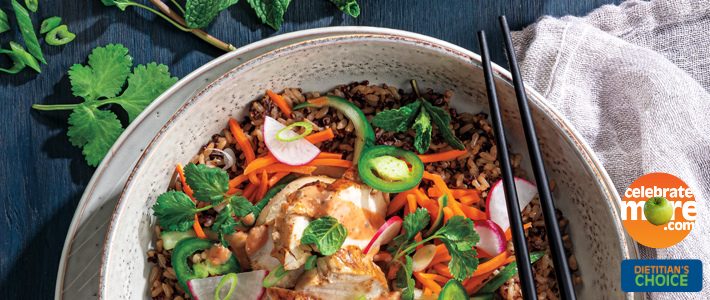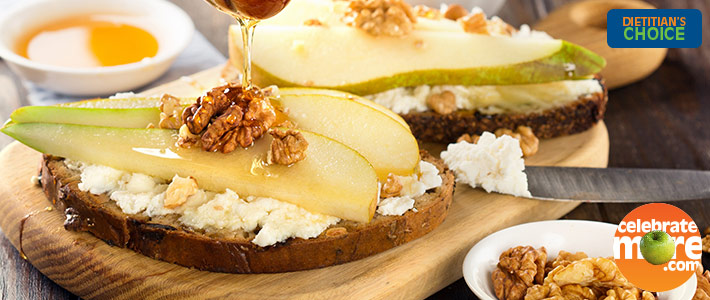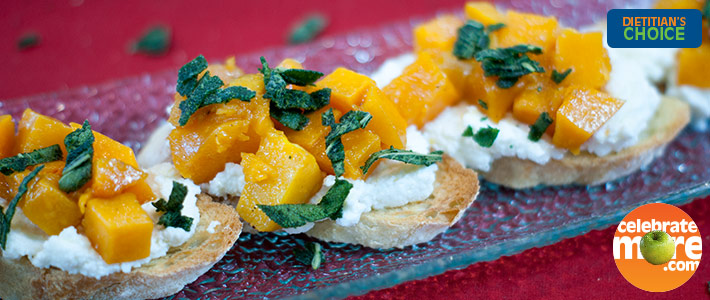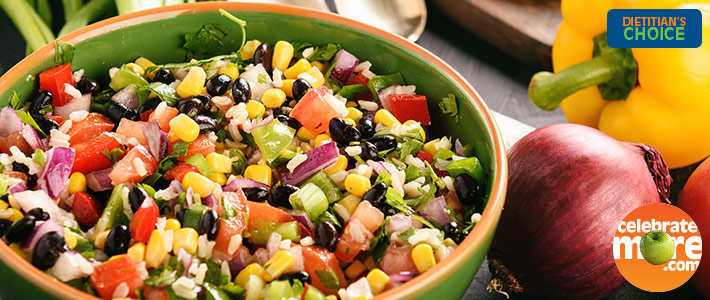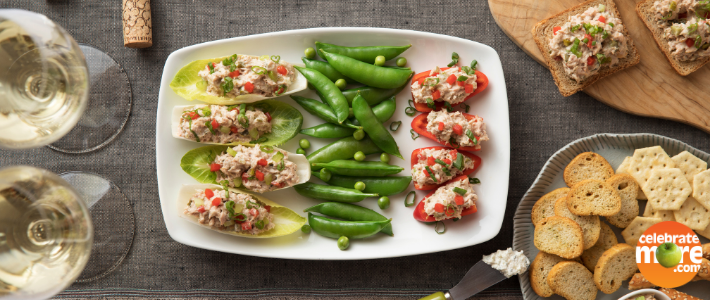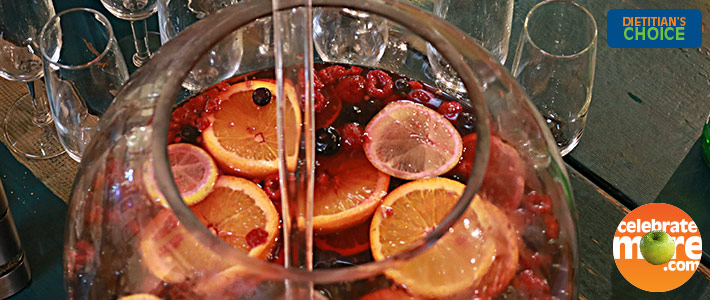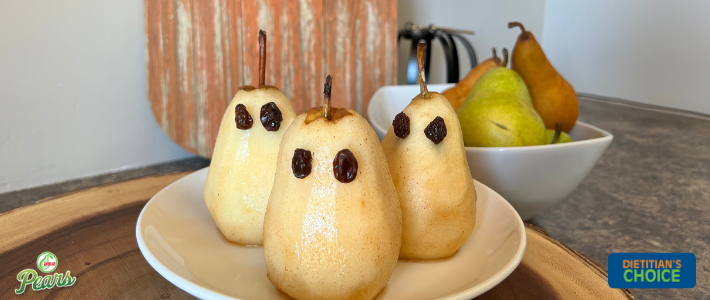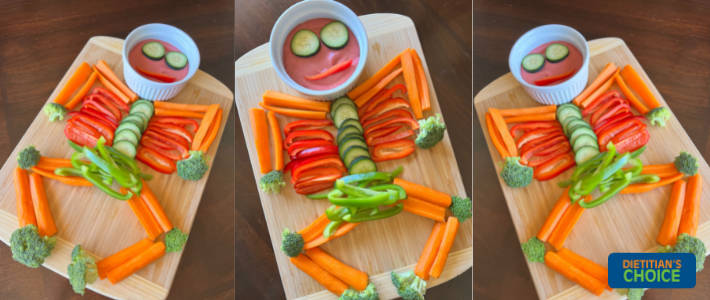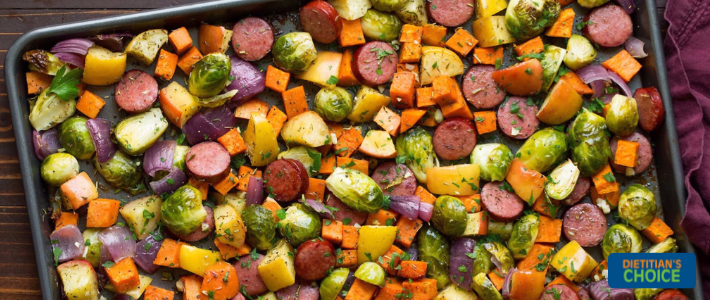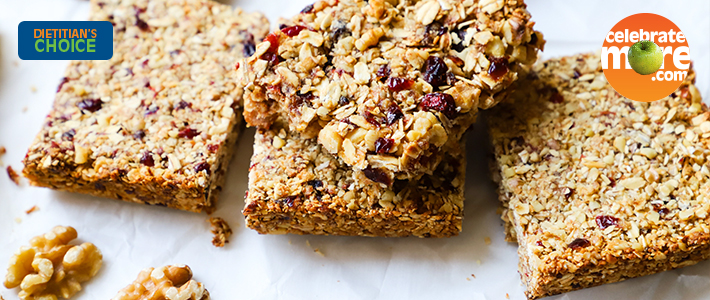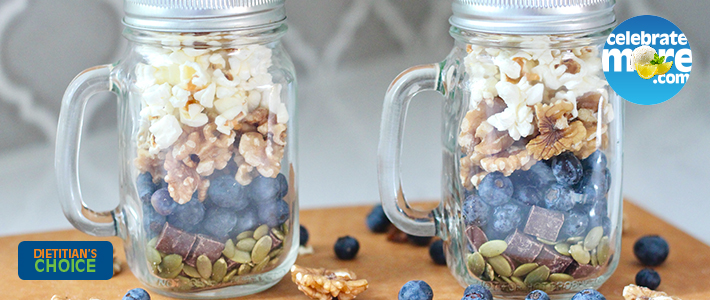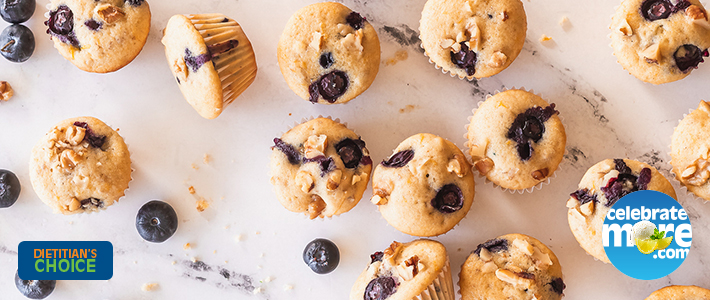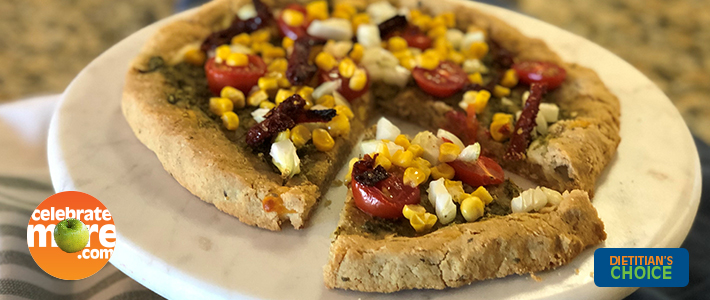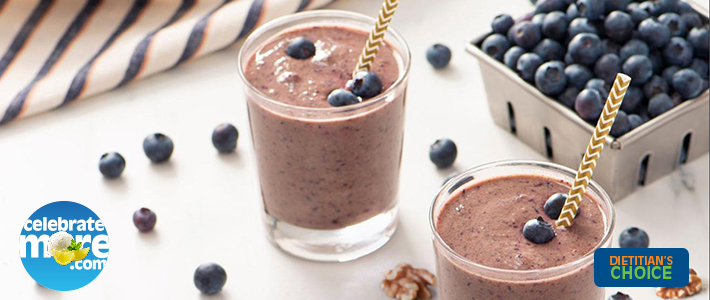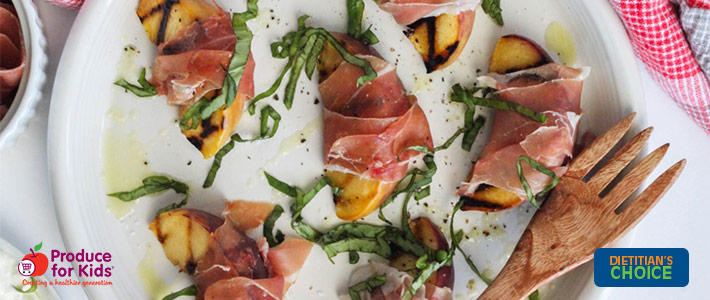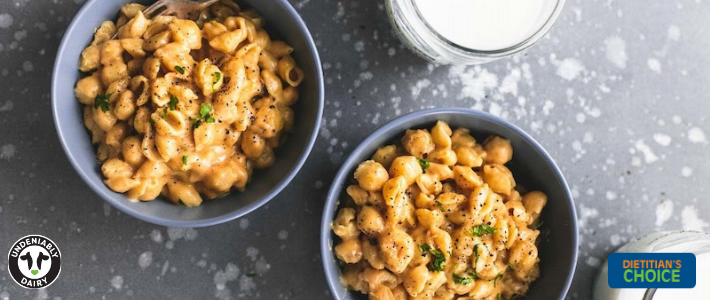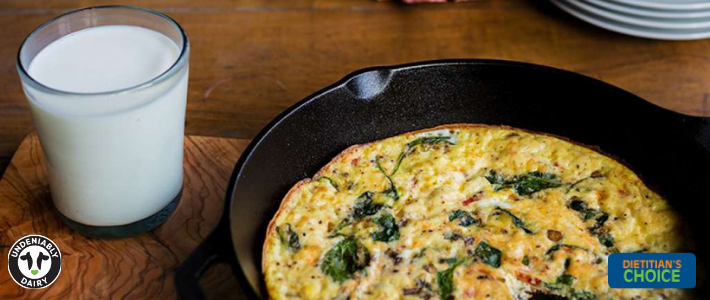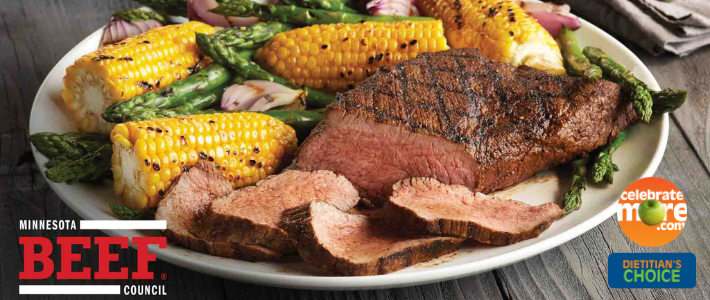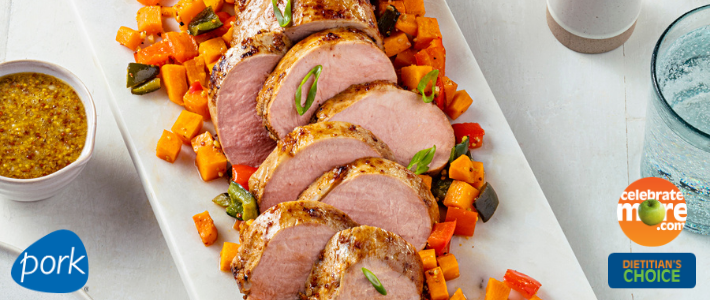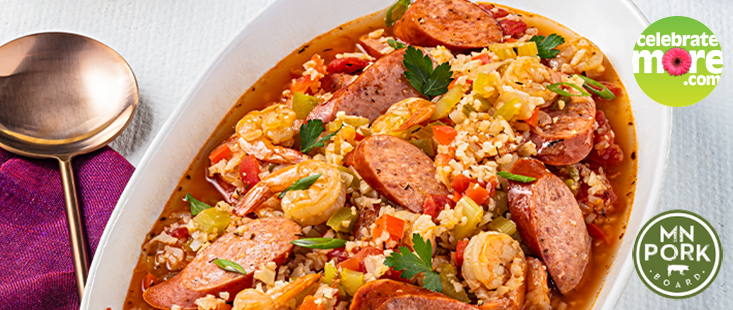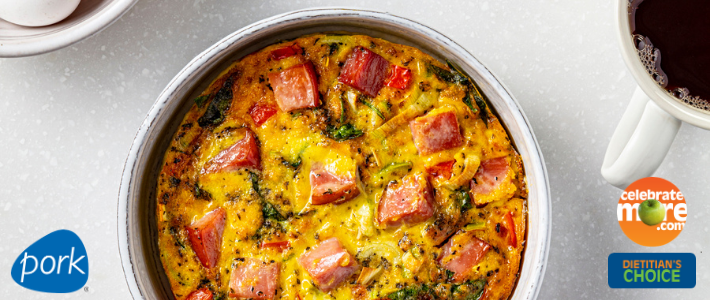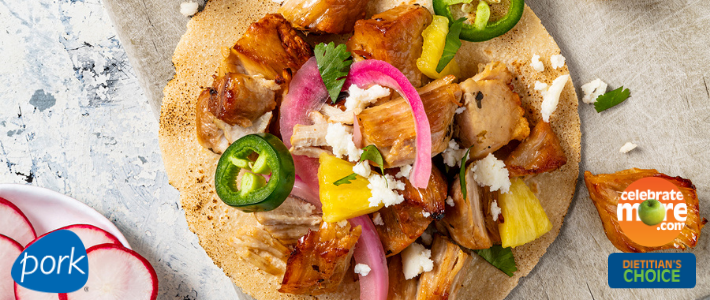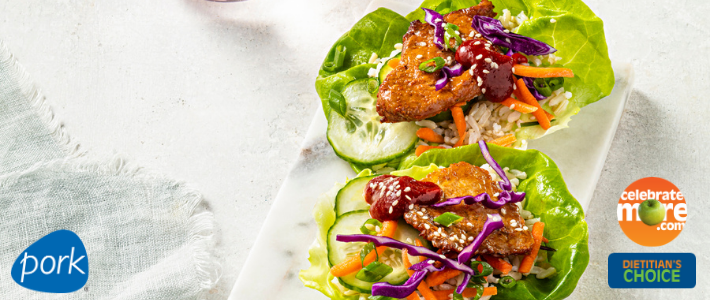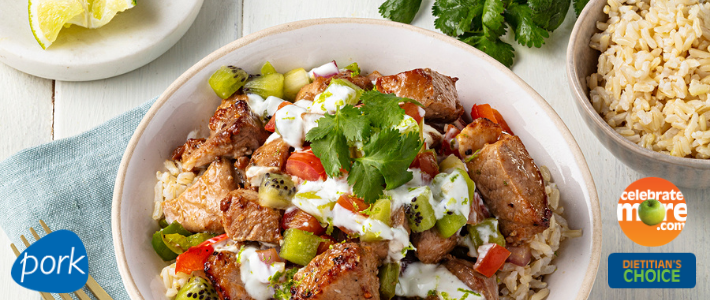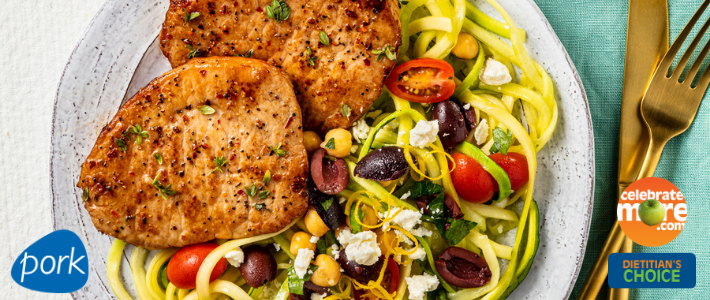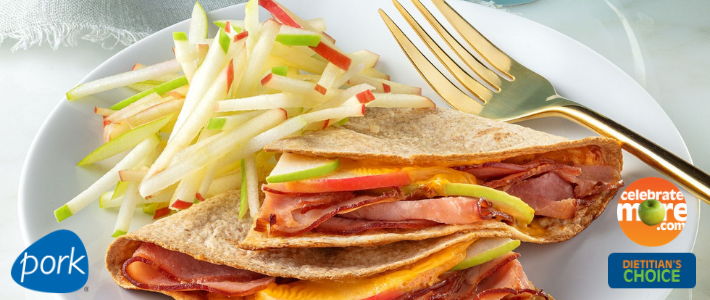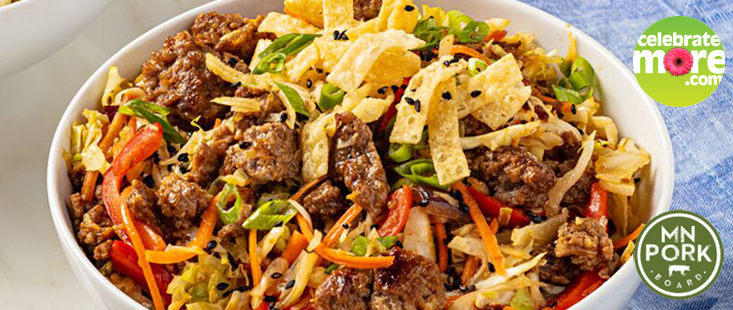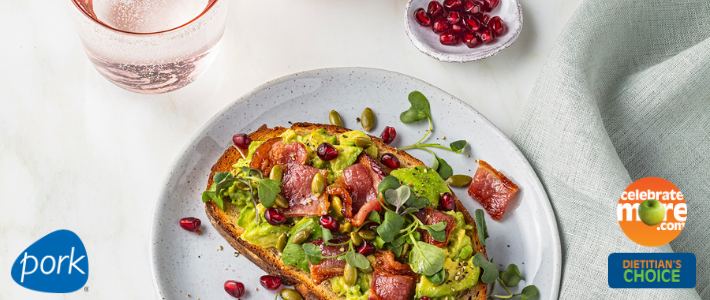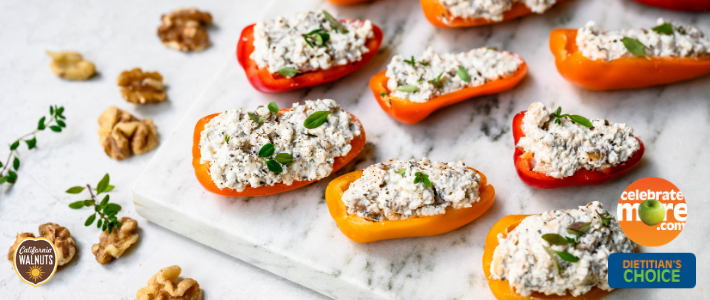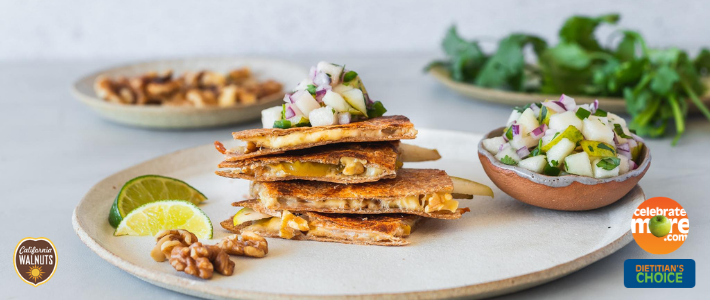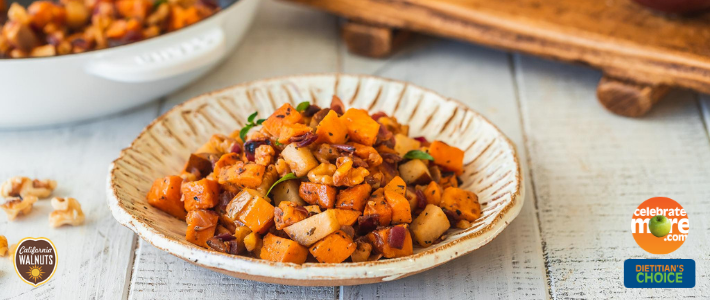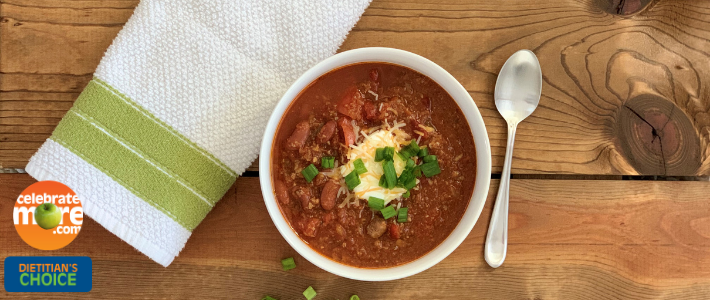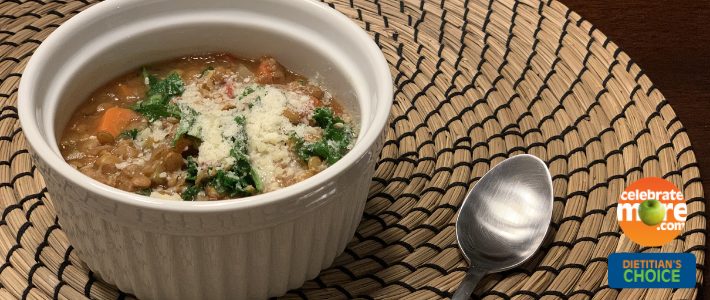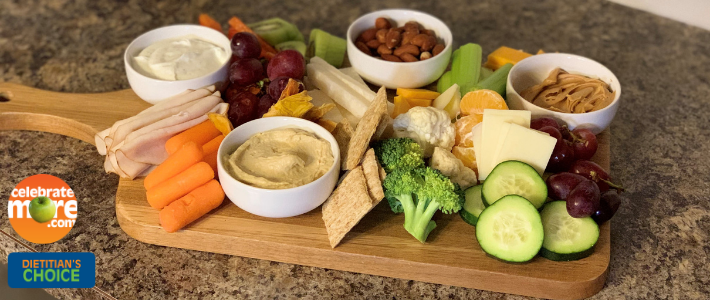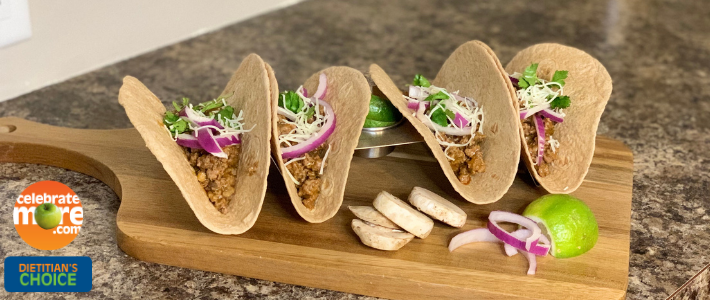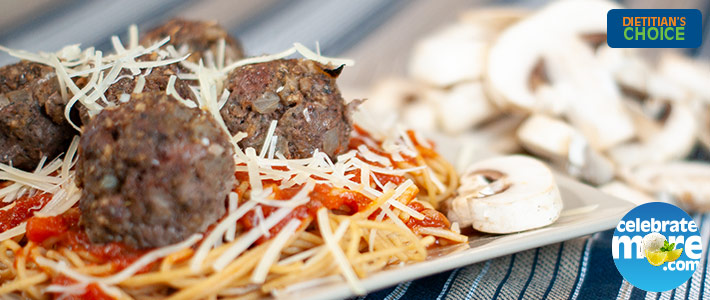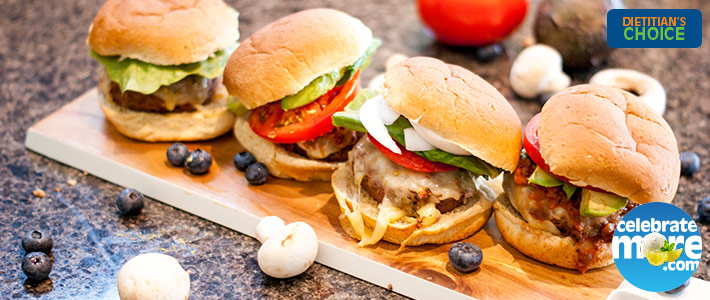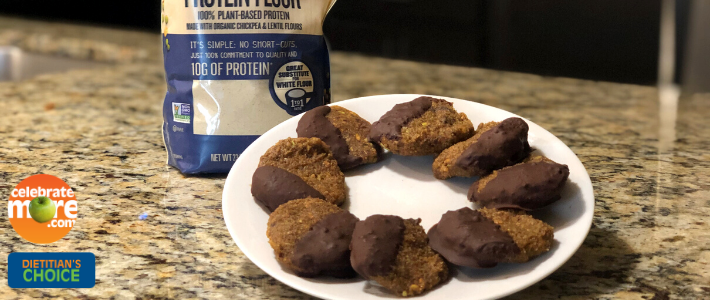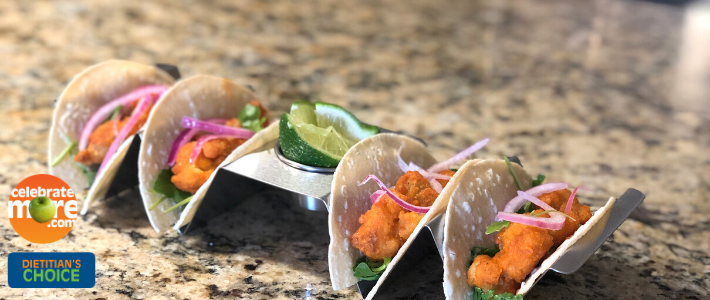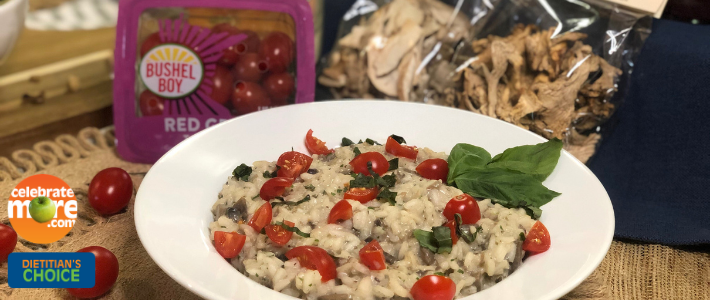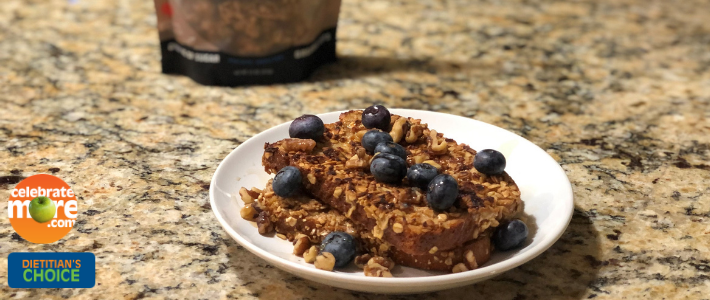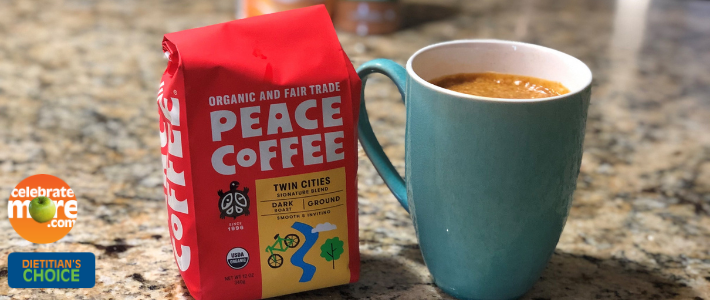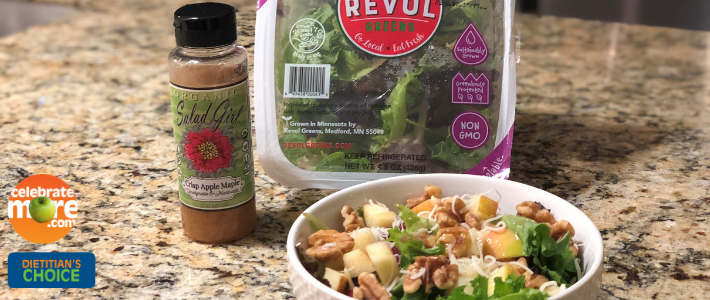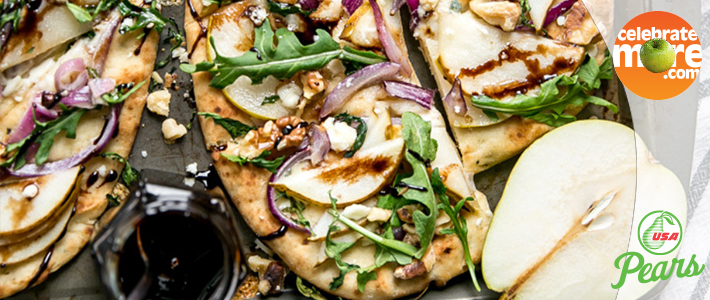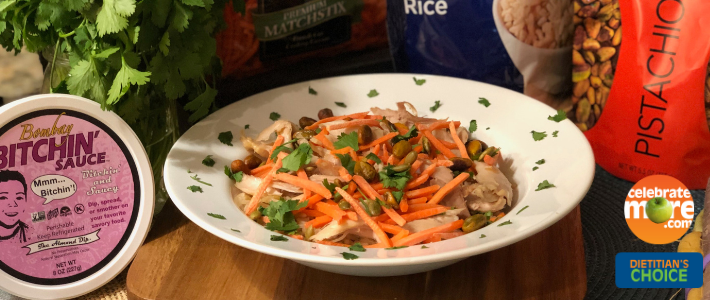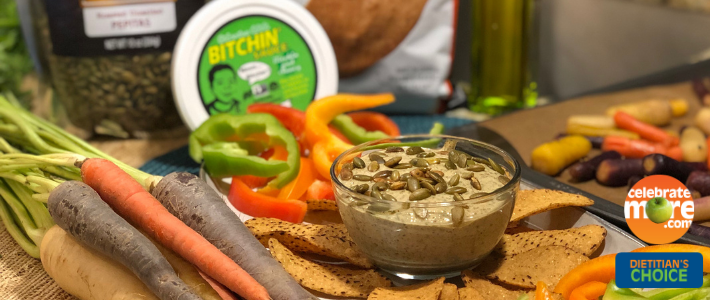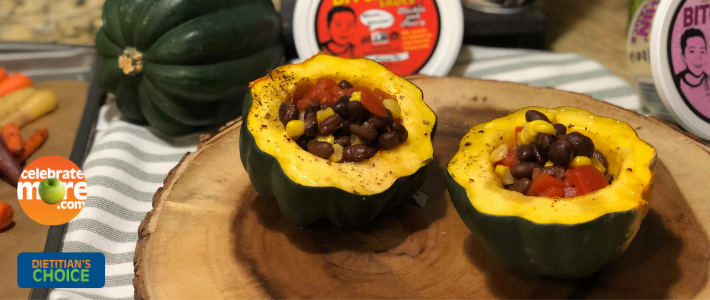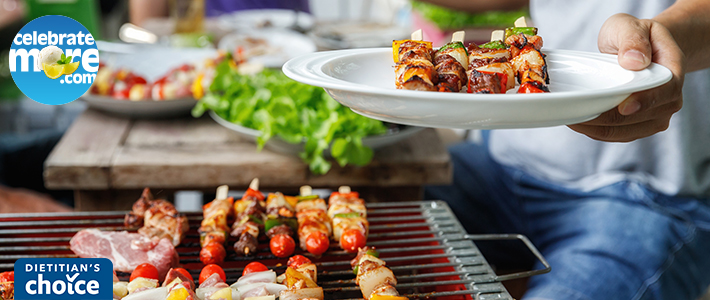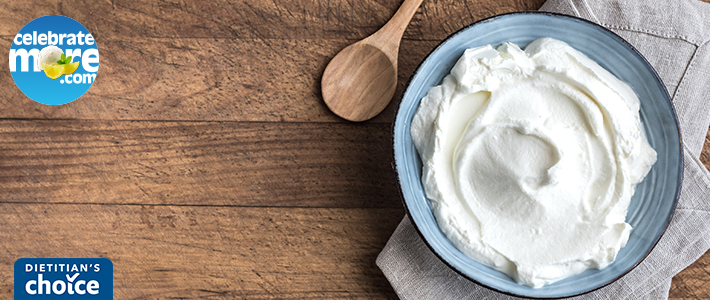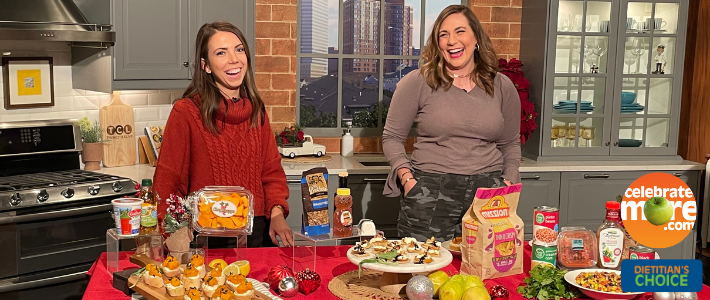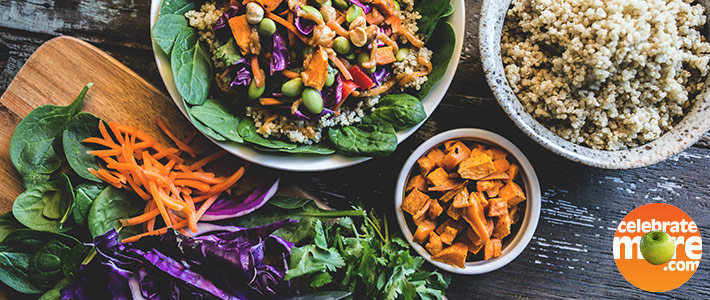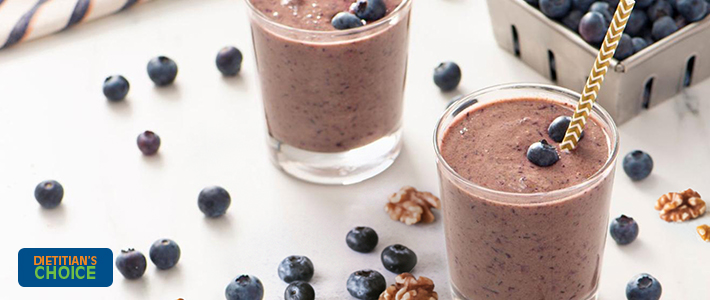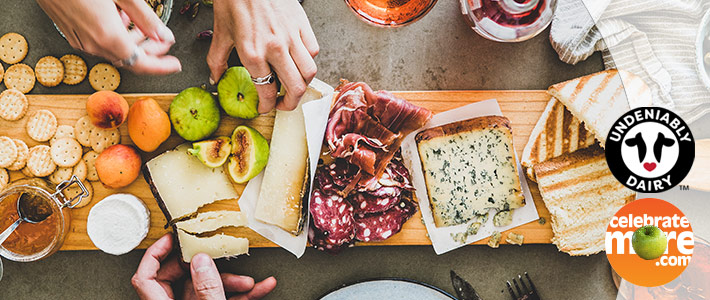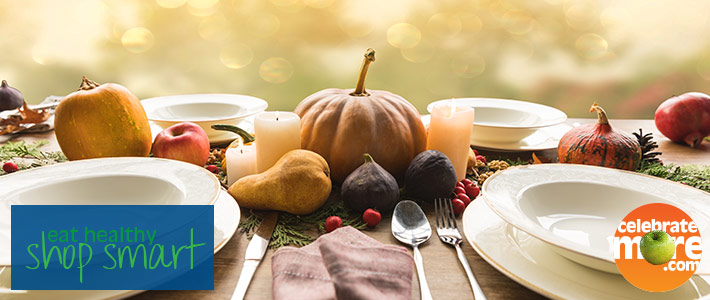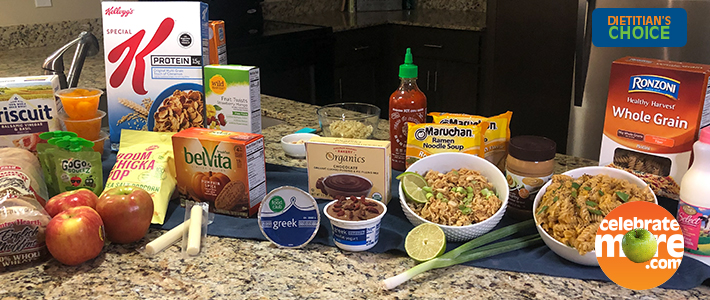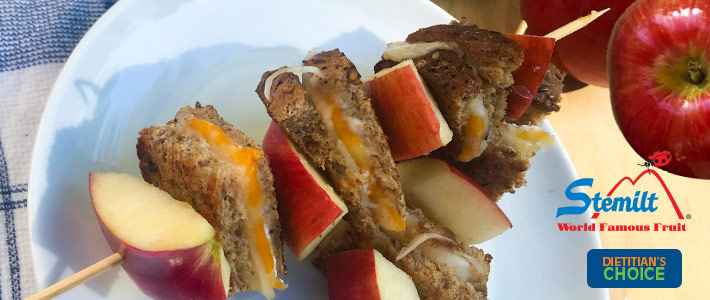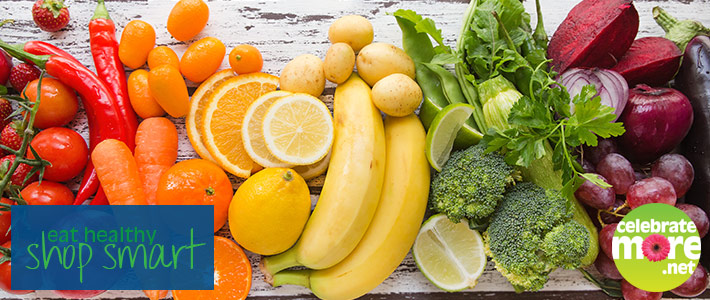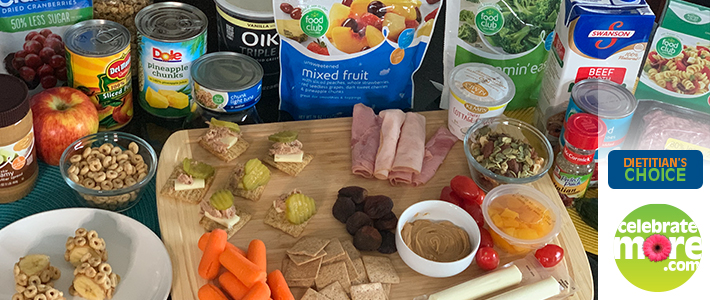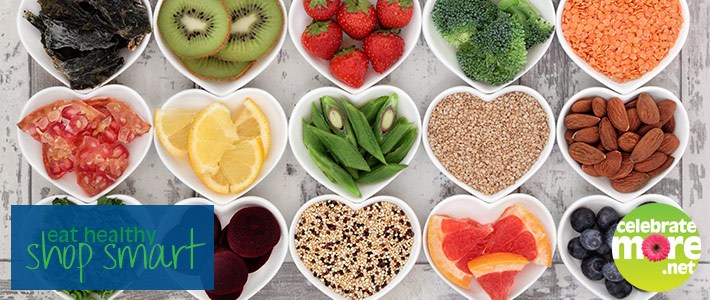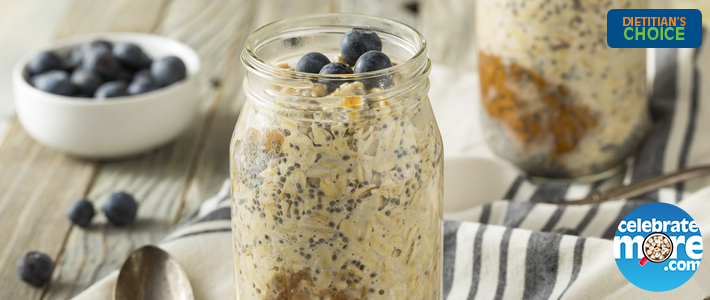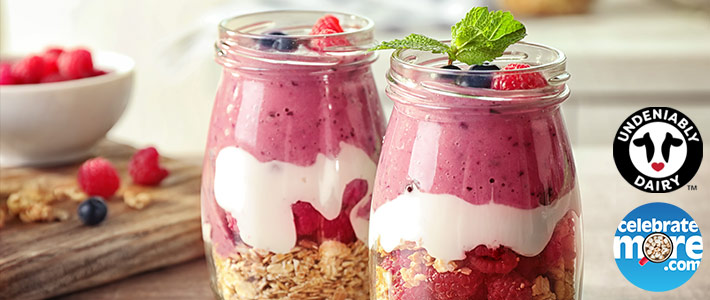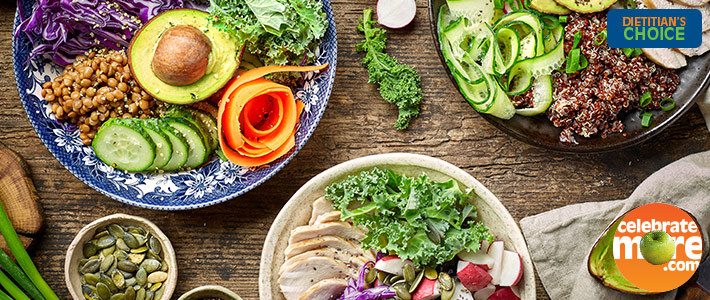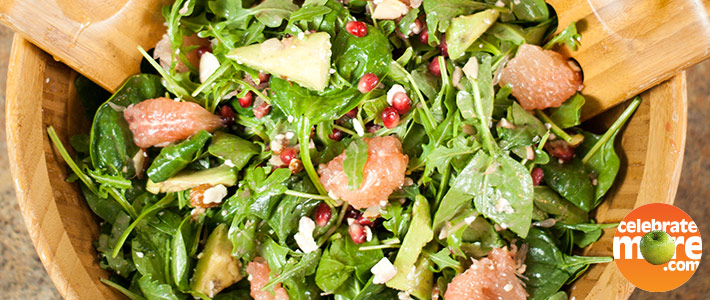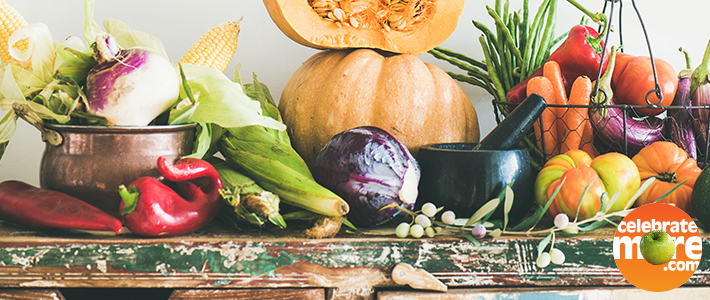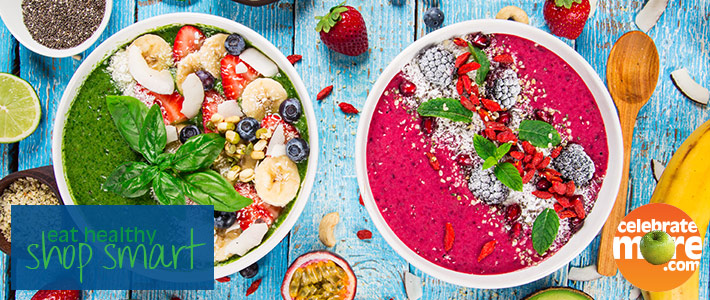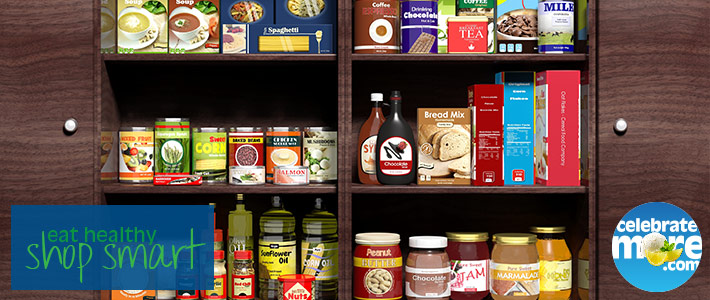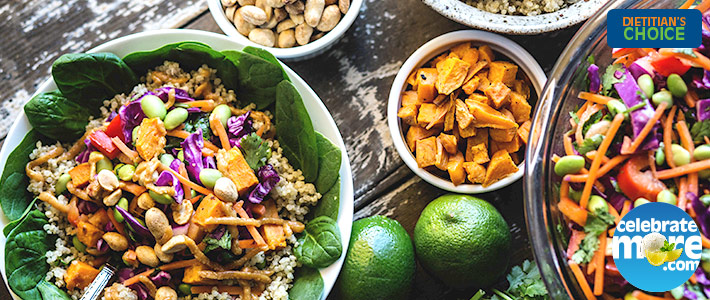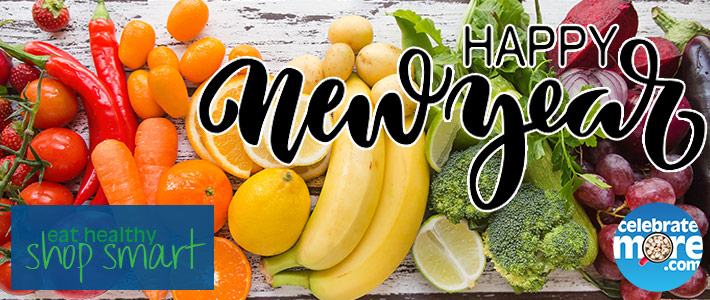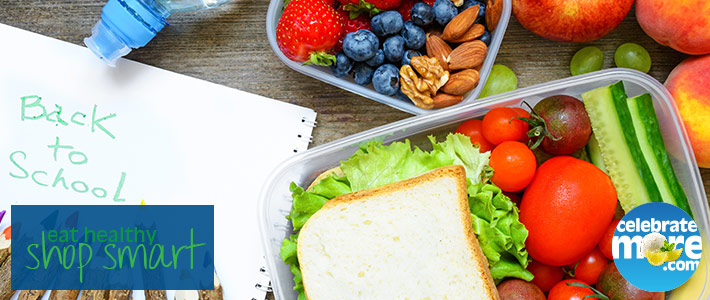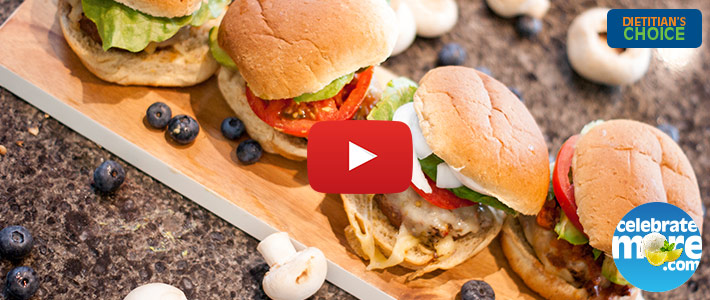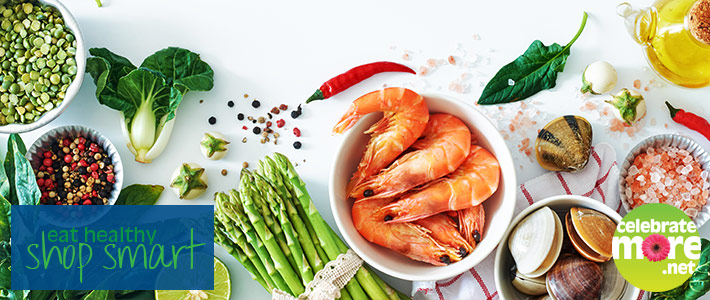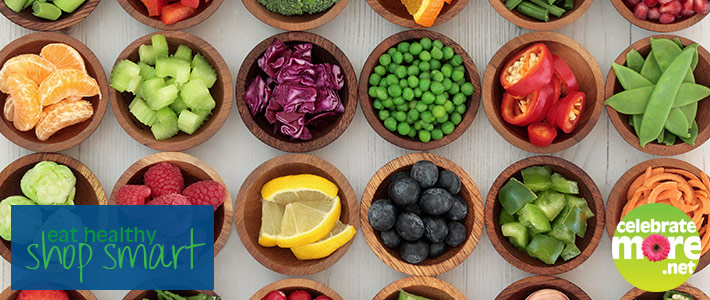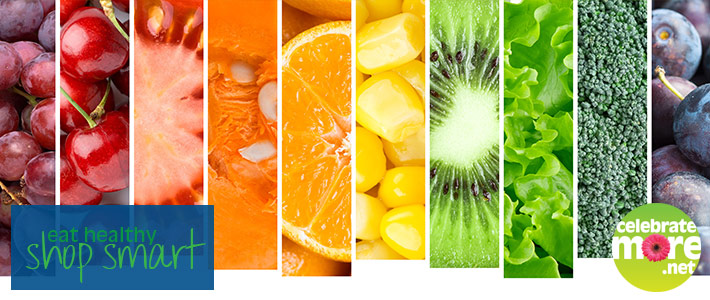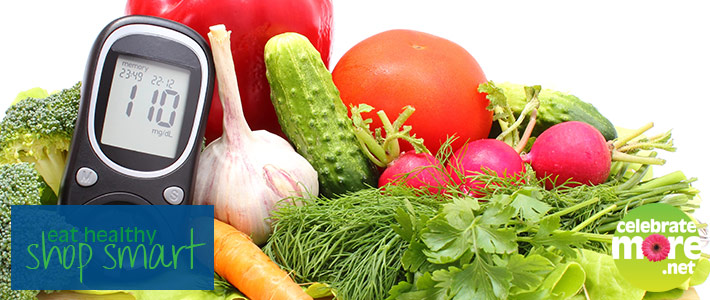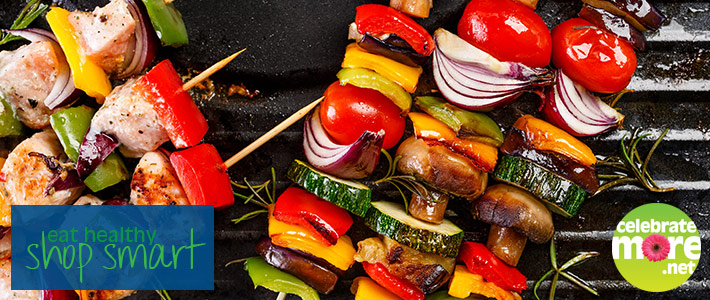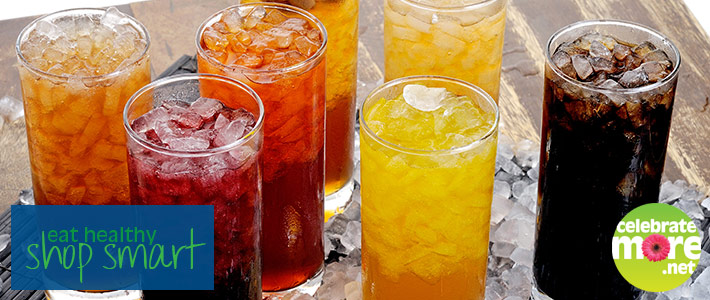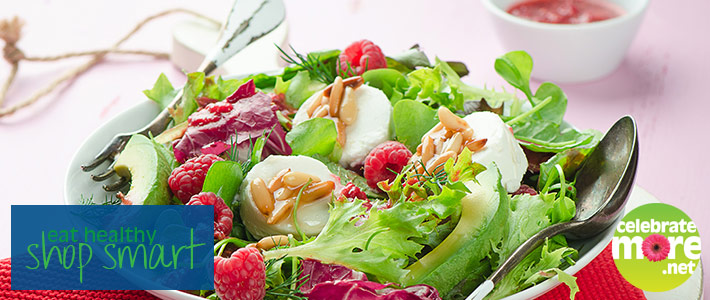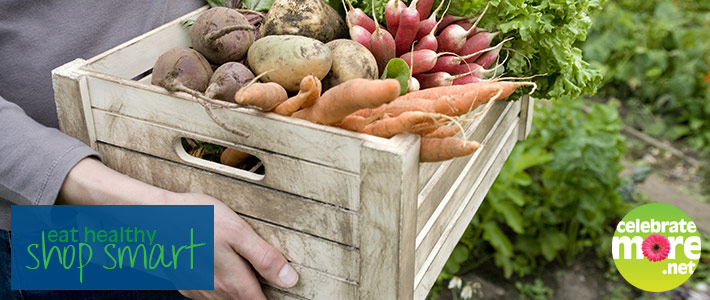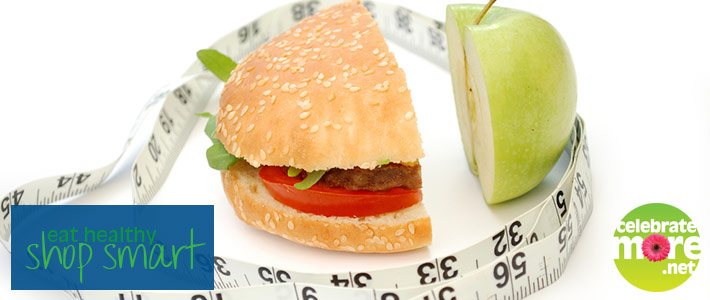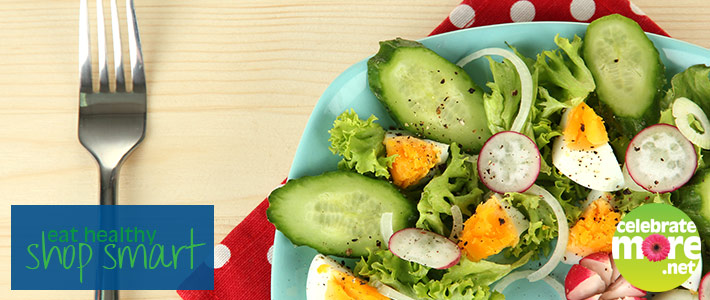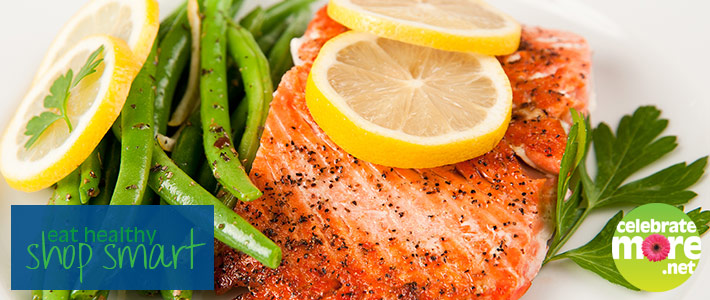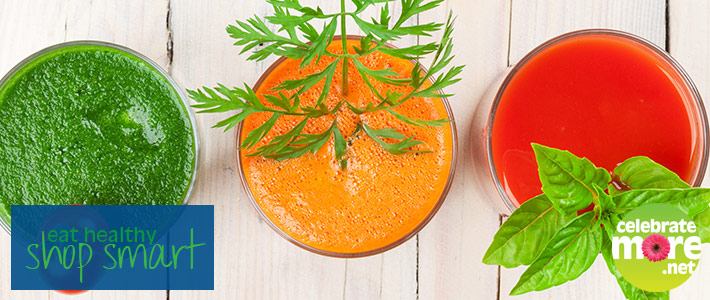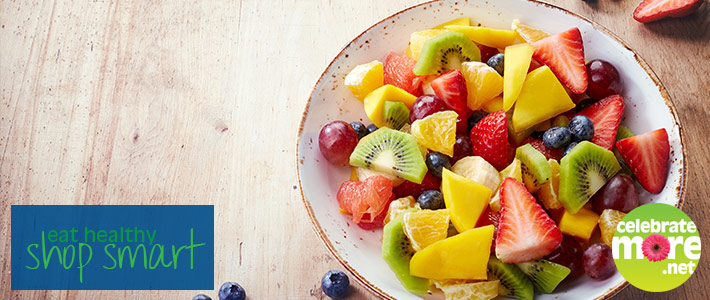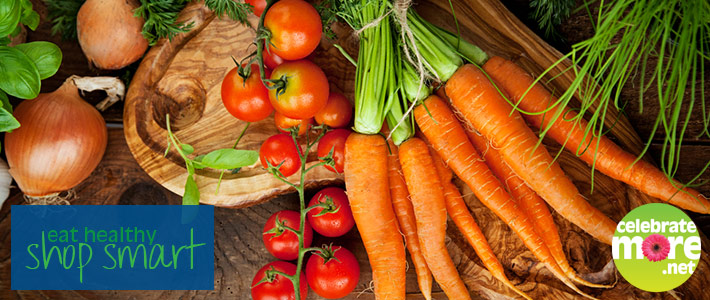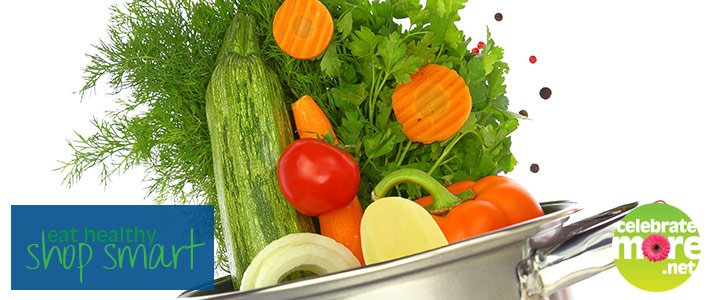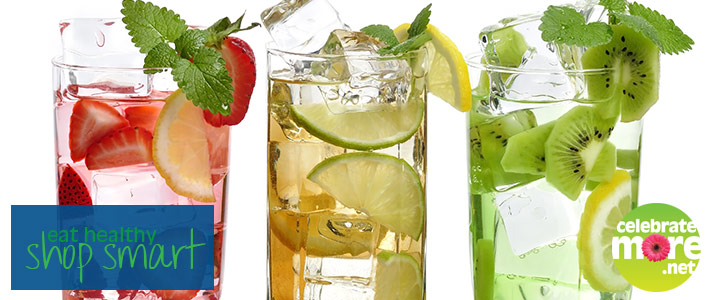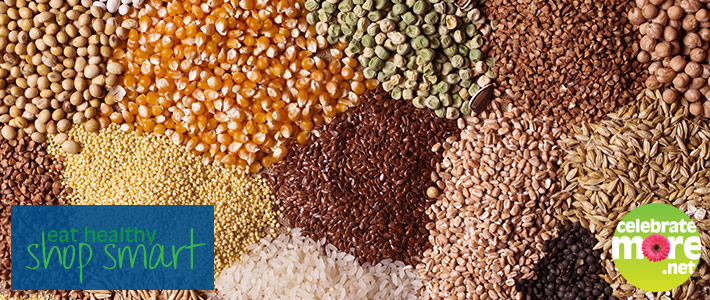
Meet our Supermarket Registered Dietitians!
Emily

Emily Parent MFCS, RD, LD, FAND
Hello! My name is Emily, and I am one of your Registered Dietitians. I am a Wisconsinite at heart but have loved exploring the best of what the rest of the Midwest has to offer over the last 7 years. After graduating with my bachelor’s degree from the University of Wisconsin-Stout, I completed my dietetic internship at OSF Saint Francis Medical Center in Peoria, IL and went on to complete my Master’s degree in Nutrition from Iowa State University virtually after moving to Minnesota to work as a retail dietitian. I believe that food should be enjoyed and that there is always room for your favorite foods within a balanced lifestyle. In my spare time, you’ll often find me traveling to new places, trying strange foods, and spending ample time with my family and dog, Benny.
Hello! My name is Emily, and I am one of your Registered Dietitians. I am a Wisconsinite at heart but have loved exploring the best of what the rest of the Midwest has to offer over the last 7 years. After graduating with my bachelor’s degree from the University of Wisconsin-Stout, I completed my dietetic internship at OSF Saint Francis Medical Center in Peoria, IL and went on to complete my Master’s degree in Nutrition from Iowa State University virtually after moving to Minnesota to work as a retail dietitian. I believe that food should be enjoyed and that there is always room for your favorite foods within a balanced lifestyle. In my spare time, you’ll often find me traveling to new places, trying strange foods, and spending ample time with my family and dog, Benny.
Jess

Jessica Talbot MPPD, RDN, LD
Hi, I’m Jess, one of your Registered Dietitians! Like Emily, I am a Wisconsinite at heart, but I have been living in Minnesota for the past 7 years. I earned my bachelor’s degree in nutrition from the College of Saint Benedict and went on to complete my dietetic internship and Master of Professional Practice in Dietetics through Iowa State University. My passion lies in empowering individuals to put the fun back into cooking and food choices, utilizing an “all foods fit” approach to nutrition. I love to cook and try new recipes, with an emphasis on adding nutrient dense food choices to my dishes! Outside of work, you can find me fishing, hiking, snowshoeing, and overall enjoying the beauty that Northern Wisconsin and Northern Minnesota have to offer with my husband and two pups, Yukon and Timber.
Hi, I’m Jess, one of your Registered Dietitians! Like Emily, I am a Wisconsinite at heart, but I have been living in Minnesota for the past 7 years. I earned my bachelor’s degree in nutrition from the College of Saint Benedict and went on to complete my dietetic internship and Master of Professional Practice in Dietetics through Iowa State University. My passion lies in empowering individuals to put the fun back into cooking and food choices, utilizing an “all foods fit” approach to nutrition. I love to cook and try new recipes, with an emphasis on adding nutrient dense food choices to my dishes! Outside of work, you can find me fishing, hiking, snowshoeing, and overall enjoying the beauty that Northern Wisconsin and Northern Minnesota have to offer with my husband and two pups, Yukon and Timber.
Resources
Get health and nutrition information from the experts! Our team of Registered Dietitians have created a number of resources to help you live your best life. We’ve got resources ranging from heart health and diabetes to weight management and picky eaters! Simply download the pdfs below and learn more from our Supermarket Registered Dietitians.
To better assist our guests in making more nutritious choices, our Supermarket Registered Dietitians hand select “better for you” options throughout our store. Learn more »
Dietitian’s Choice Recipes
Stuck in a rut with the same meals over and over again? Our team of Supermarket Registered Dietitians are sharing great recipes to help make meal planning and pleasing your family a whole lot easier. Look through our recipes and check back often as we add more!
Latest Dietitian's Choice Recipes
Shop Ingredients
Coborn’s
×
Select Your Coborn’s Store
Albertville, MN
Belle Plaine, MN
Big Lake, MN
Buffalo, MN
Clearwater, MN
Delano, MN
Elk River, MN
Foley, MN
Glencoe, MN
Hastings, MN
Huron, SD
Isanti, MN
Little Falls, MN
Long Prairie, MN
Melrose, MN
Mitchell, SD
Mora, MN
New Prague, MN
Otsego, MN
Park Rapids, MN
Pipestone, MN
Princeton, MN
Ramsey, MN
Sartell, MN Pine Cone
Sartell, MN Riverside
Sauk Centre, MN
Sauk Rapids, MN
St. Cloud, MN Cooper Ave.
St. Joseph, MN
Close
Shop Ingredients
Cash Wise
×
Select Your Cash Wise Store
Bismarck, ND
Bismarck, ND – North
Dickinson, ND
Fargo, ND – 13th Ave
Hutchinson, MN
Jamestown, ND
Minot, ND
Moorhead, MN
New Ulm, MN
Owatonna, MN
South Fargo, ND – 52nd Ave
Stanley, ND
St. Cloud – East, MN
Tioga, ND
Waite Park, MN
Watford City, ND
West Fargo, ND
Williston, ND
Willmar, MN
Close
Shop Ingredients
MarketPlace Foods
×
Select Your MarketPlace Foods Store
Hayward, WI
Menomonie, WI
Rice Lake, WI
St. Croix, WI
Close [...]
Read more...
Shop Ingredients
Coborn’s
×
Select Your Coborn’s Store
Albertville, MN
Belle Plaine, MN
Big Lake, MN
Buffalo, MN
Clearwater, MN
Delano, MN
Elk River, MN
Foley, MN
Glencoe, MN
Hastings, MN
Huron, SD
Isanti, MN
Little Falls, MN
Long Prairie, MN
Melrose, MN
Mitchell, SD
Mora, MN
New Prague, MN
Otsego, MN
Park Rapids, MN
Pipestone, MN
Princeton, MN
Ramsey, MN
Sartell, MN Pine Cone
Sartell, MN Riverside
Sauk Centre, MN
Sauk Rapids, MN
St. Cloud, MN Cooper Ave.
St. Joseph, MN
Close
Shop Ingredients
Cash Wise
×
Select Your Cash Wise Store
Bismarck, ND
Bismarck, ND – North
Dickinson, ND
Fargo, ND – 13th Ave
Hutchinson, MN
Jamestown, ND
Minot, ND
Moorhead, MN
New Ulm, MN
Owatonna, MN
South Fargo, ND – 52nd Ave
Stanley, ND
St. Cloud – East, MN
Tioga, ND
Waite Park, MN
Watford City, ND
West Fargo, ND
Williston, ND
Willmar, MN
Close
Shop Ingredients
MarketPlace Foods
×
Select Your MarketPlace Foods Store
Hayward, WI
Menomonie, WI
Rice Lake, WI
St. Croix, WI
Close [...]
Read more...
Shop Ingredients
Coborn’s
×
Select Your Coborn’s Store
Albertville, MN
Belle Plaine, MN
Big Lake, MN
Buffalo, MN
Clearwater, MN
Delano, MN
Elk River, MN
Foley, MN
Glencoe, MN
Hastings, MN
Huron, SD
Isanti, MN
Little Falls, MN
Long Prairie, MN
Melrose, MN
Mitchell, SD
Mora, MN
New Prague, MN
Otsego, MN
Park Rapids, MN
Pipestone, MN
Princeton, MN
Ramsey, MN
Sartell, MN Pine Cone
Sartell, MN Riverside
Sauk Centre, MN
Sauk Rapids, MN
St. Cloud, MN Cooper Ave.
St. Joseph, MN
Close
Shop Ingredients
Cash Wise
×
Select Your Cash Wise Store
Bismarck, ND
Bismarck, ND – North
Dickinson, ND
Fargo, ND – 13th Ave
Hutchinson, MN
Jamestown, ND
Minot, ND
Moorhead, MN
New Ulm, MN
Owatonna, MN
South Fargo, ND – 52nd Ave
Stanley, ND
St. Cloud – East, MN
Tioga, ND
Waite Park, MN
Watford City, ND
West Fargo, ND
Williston, ND
Willmar, MN
Close
Shop Ingredients
MarketPlace Foods
×
Select Your MarketPlace Foods Store
Hayward, WI
Menomonie, WI
Rice Lake, WI
St. Croix, WI
Close [...]
Read more...
Shop Ingredients
Coborn’s
×
Select Your Coborn’s Store
Albertville, MN
Belle Plaine, MN
Big Lake, MN
Buffalo, MN
Clearwater, MN
Delano, MN
Elk River, MN
Foley, MN
Glencoe, MN
Hastings, MN
Huron, SD
Isanti, MN
Little Falls, MN
Long Prairie, MN
Melrose, MN
Mitchell, SD
Mora, MN
New Prague, MN
Otsego, MN
Park Rapids, MN
Pipestone, MN
Princeton, MN
Ramsey, MN
Sartell, MN Pine Cone
Sartell, MN Riverside
Sauk Centre, MN
Sauk Rapids, MN
St. Cloud, MN Cooper Ave.
St. Joseph, MN
Close
Shop Ingredients
Cash Wise
×
Select Your Cash Wise Store
Bismarck, ND
Bismarck, ND – North
Dickinson, ND
Fargo, ND – 13th Ave
Hutchinson, MN
Jamestown, ND
Minot, ND
Moorhead, MN
New Ulm, MN
Owatonna, MN
South Fargo, ND – 52nd Ave
Stanley, ND
St. Cloud – East, MN
Tioga, ND
Waite Park, MN
Watford City, ND
West Fargo, ND
Williston, ND
Willmar, MN
Close
Shop Ingredients
MarketPlace Foods
×
Select Your MarketPlace Foods Store
Hayward, WI
Menomonie, WI
Rice Lake, WI
St. Croix, WI
Close [...]
Read more...
Shop Ingredients
Coborn’s
×
Select Your Coborn’s Store
Albertville, MN
Belle Plaine, MN
Big Lake, MN
Buffalo, MN
Clearwater, MN
Delano, MN
Elk River, MN
Foley, MN
Glencoe, MN
Hastings, MN
Huron, SD
Isanti, MN
Little Falls, MN
Long Prairie, MN
Melrose, MN
Mitchell, SD
Mora, MN
New Prague, MN
Otsego, MN
Park Rapids, MN
Pipestone, MN
Princeton, MN
Ramsey, MN
Sartell, MN Pine Cone
Sartell, MN Riverside
Sauk Centre, MN
Sauk Rapids, MN
St. Cloud, MN Cooper Ave.
St. Joseph, MN
Close
Shop Ingredients
Cash Wise
×
Select Your Cash Wise Store
Bismarck, ND
Bismarck, ND – North
Dickinson, ND
Fargo, ND – 13th Ave
Hutchinson, MN
Jamestown, ND
Minot, ND
Moorhead, MN
New Ulm, MN
Owatonna, MN
South Fargo, ND – 52nd Ave
Stanley, ND
St. Cloud – East, MN
Tioga, ND
Waite Park, MN
Watford City, ND
West Fargo, ND
Williston, ND
Willmar, MN
Close
Shop Ingredients
MarketPlace Foods
×
Select Your MarketPlace Foods Store
Hayward, WI
Menomonie, WI
Rice Lake, WI
St. Croix, WI
Close [...]
Read more...
Shop Ingredients
Coborn’s
×
Select Your Coborn’s Store
Albertville, MN
Belle Plaine, MN
Big Lake, MN
Buffalo, MN
Clearwater, MN
Delano, MN
Elk River, MN
Foley, MN
Glencoe, MN
Hastings, MN
Huron, SD
Isanti, MN
Little Falls, MN
Long Prairie, MN
Melrose, MN
Mitchell, SD
Mora, MN
New Prague, MN
Otsego, MN
Park Rapids, MN
Pipestone, MN
Princeton, MN
Ramsey, MN
Sartell, MN Pine Cone
Sartell, MN Riverside
Sauk Centre, MN
Sauk Rapids, MN
St. Cloud, MN Cooper Ave.
St. Joseph, MN
Close
Shop Ingredients
Cash Wise
×
Select Your Cash Wise Store
Bismarck, ND
Bismarck, ND – North
Dickinson, ND
Fargo, ND – 13th Ave
Hutchinson, MN
Jamestown, ND
Minot, ND
Moorhead, MN
New Ulm, MN
Owatonna, MN
South Fargo, ND – 52nd Ave
Stanley, ND
St. Cloud – East, MN
Tioga, ND
Waite Park, MN
Watford City, ND
West Fargo, ND
Williston, ND
Willmar, MN
Close
Shop Ingredients
MarketPlace Foods
×
Select Your MarketPlace Foods Store
Hayward, WI
Menomonie, WI
Rice Lake, WI
St. Croix, WI
Close [...]
Read more...
Shop Ingredients
Coborn’s
×
Select Your Coborn’s Store
Albertville, MN
Belle Plaine, MN
Big Lake, MN
Buffalo, MN
Clearwater, MN
Delano, MN
Elk River, MN
Foley, MN
Glencoe, MN
Hastings, MN
Huron, SD
Isanti, MN
Little Falls, MN
Long Prairie, MN
Melrose, MN
Mitchell, SD
Mora, MN
New Prague, MN
Otsego, MN
Park Rapids, MN
Pipestone, MN
Princeton, MN
Ramsey, MN
Sartell, MN Pine Cone
Sartell, MN Riverside
Sauk Centre, MN
Sauk Rapids, MN
St. Cloud, MN Cooper Ave.
St. Joseph, MN
Close
Shop Ingredients
Cash Wise
×
Select Your Cash Wise Store
Bismarck, ND
Bismarck, ND – North
Dickinson, ND
Fargo, ND – 13th Ave
Hutchinson, MN
Jamestown, ND
Kimball, MN
Minot, ND
Moorhead, MN
New Ulm, MN
Owatonna, MN
South Fargo, ND – 52nd Ave
Stanley, ND
St. Cloud – East, MN
Tioga, ND
Waite Park, MN
Watford City, ND
West Fargo, ND
Williston, ND
Willmar, MN
Close
Shop Ingredients
MarketPlace Foods
×
Select Your MarketPlace Foods Store
Hayward, WI
Menomonie, WI
Rice Lake, WI
St. Croix, WI
Close [...]
Read more...
Shop Ingredients
Coborn’s
×
Select Your Coborn’s Store
Albertville, MN
Belle Plaine, MN
Big Lake, MN
Buffalo, MN
Clearwater, MN
Delano, MN
Elk River, MN
Foley, MN
Glencoe, MN
Hastings, MN
Huron, SD
Isanti, MN
Little Falls, MN
Long Prairie, MN
Melrose, MN
Mitchell, SD
Mora, MN
New Prague, MN
Otsego, MN
Park Rapids, MN
Pipestone, MN
Princeton, MN
Ramsey, MN
Sartell, MN Pine Cone
Sartell, MN Riverside
Sauk Centre, MN
Sauk Rapids, MN
St. Cloud, MN Cooper Ave.
St. Joseph, MN
Close
Shop Ingredients
Cash Wise
×
Select Your Cash Wise Store
Bismarck, ND
Bismarck, ND – North
Dickinson, ND
Fargo, ND – 13th Ave
Hutchinson, MN
Jamestown, ND
Kimball, MN
Minot, ND
Moorhead, MN
New Ulm, MN
Owatonna, MN
South Fargo, ND – 52nd Ave
Stanley, ND
St. Cloud – East, MN
Tioga, ND
Waite Park, MN
Watford City, ND
West Fargo, ND
Williston, ND
Willmar, MN
Close
Shop Ingredients
MarketPlace Foods
×
Select Your MarketPlace Foods Store
Hayward, WI
Menomonie, WI
Rice Lake, WI
St. Croix, WI
Close [...]
Read more...
Shop Ingredients
Coborn’s
×
Select Your Coborn’s Store
Albertville, MN
Belle Plaine, MN
Big Lake, MN
Buffalo, MN
Clearwater, MN
Delano, MN
Elk River, MN
Foley, MN
Glencoe, MN
Hastings, MN
Huron, SD
Isanti, MN
Little Falls, MN
Long Prairie, MN
Melrose, MN
Mitchell, SD
Mora, MN
New Prague, MN
Otsego, MN
Park Rapids, MN
Pipestone, MN
Princeton, MN
Ramsey, MN
Sartell, MN Pine Cone
Sartell, MN Riverside
Sauk Centre, MN
Sauk Rapids, MN
St. Cloud, MN Cooper Ave.
St. Joseph, MN
Close
Shop Ingredients
Cash Wise
×
Select Your Cash Wise Store
Bismarck, ND
Bismarck, ND – North
Dickinson, ND
Fargo, ND – 13th Ave
Hutchinson, MN
Jamestown, ND
Kimball, MN
Minot, ND
Moorhead, MN
New Ulm, MN
Owatonna, MN
South Fargo, ND – 52nd Ave
Stanley, ND
St. Cloud – East, MN
Tioga, ND
Waite Park, MN
Watford City, ND
West Fargo, ND
Williston, ND
Willmar, MN
Close
Shop Ingredients
MarketPlace Foods
×
Select Your MarketPlace Foods Store
Hayward, WI
Menomonie, WI
Rice Lake, WI
St. Croix, WI
Close [...]
Read more...
Shop Ingredients
Coborn’s
×
Select Your Coborn’s Store
Albertville, MN
Belle Plaine, MN
Big Lake, MN
Buffalo, MN
Clearwater, MN
Delano, MN
Elk River, MN
Foley, MN
Glencoe, MN
Hastings, MN
Huron, SD
Isanti, MN
Little Falls, MN
Long Prairie, MN
Melrose, MN
Mitchell, SD
Mora, MN
New Prague, MN
Otsego, MN
Park Rapids, MN
Pipestone, MN
Princeton, MN
Ramsey, MN
Sartell, MN Pine Cone
Sartell, MN Riverside
Sauk Centre, MN
Sauk Rapids, MN
St. Cloud, MN Cooper Ave.
St. Joseph, MN
Close
Shop Ingredients
Cash Wise
×
Select Your Cash Wise Store
Bismarck, ND
Bismarck, ND – North
Dickinson, ND
Fargo, ND – 13th Ave
Hutchinson, MN
Jamestown, ND
Kimball, MN
Minot, ND
Moorhead, MN
New Ulm, MN
Owatonna, MN
South Fargo, ND – 52nd Ave
Stanley, ND
St. Cloud – East, MN
Tioga, ND
Waite Park, MN
Watford City, ND
West Fargo, ND
Williston, ND
Willmar, MN
Close
Shop Ingredients
MarketPlace Foods
×
Select Your MarketPlace Foods Store
Hayward, WI
Menomonie, WI
Rice Lake, WI
St. Croix, WI
Close [...]
Read more...
Shop Ingredients
Coborn’s
×
Select Your Coborn’s Store
Albertville, MN
Belle Plaine, MN
Big Lake, MN
Buffalo, MN
Clearwater, MN
Delano, MN
Elk River, MN
Foley, MN
Glencoe, MN
Hastings, MN
Huron, SD
Isanti, MN
Little Falls, MN
Long Prairie, MN
Melrose, MN
Mitchell, SD
Mora, MN
New Prague, MN
Otsego, MN
Park Rapids, MN
Pipestone, MN
Princeton, MN
Ramsey, MN
Sartell, MN Pine Cone
Sartell, MN Riverside
Sauk Centre, MN
Sauk Rapids, MN
St. Cloud, MN Cooper Ave.
St. Joseph, MN
Close
Shop Ingredients
Cash Wise
×
Select Your Cash Wise Store
Bismarck, ND
Bismarck, ND – North
Dickinson, ND
Fargo, ND – 13th Ave
Hutchinson, MN
Jamestown, ND
Kimball, MN
Minot, ND
Moorhead, MN
New Ulm, MN
Owatonna, MN
South Fargo, ND – 52nd Ave
Stanley, ND
St. Cloud – East, MN
St. Michael, MN
Tioga, ND
Waite Park, MN
Watford City, ND
West Fargo, ND
Williston, ND
Willmar, MN
Close
Shop Ingredients
MarketPlace Foods
×
Select Your MarketPlace Foods Store
Hayward, WI
Menomonie, WI
Rice Lake, WI
St. Croix, WI
Close [...]
Read more...
Shop Ingredients
Coborn’s
×
Select Your Coborn’s Store
Albertville, MN
Belle Plaine, MN
Big Lake, MN
Buffalo, MN
Clearwater, MN
Delano, MN
Elk River, MN
Foley, MN
Glencoe, MN
Hastings, MN
Huron, SD
Isanti, MN
Little Falls, MN
Long Prairie, MN
Melrose, MN
Mitchell, SD
Mora, MN
New Prague, MN
Otsego, MN
Park Rapids, MN
Pipestone, MN
Princeton, MN
Ramsey, MN
Sartell, MN Pine Cone
Sartell, MN Riverside
Sauk Centre, MN
Sauk Rapids, MN
St. Cloud, MN Cooper Ave.
St. Joseph, MN
Close
Shop Ingredients
Cash Wise
×
Select Your Cash Wise Store
Bismarck, ND
Bismarck, ND – North
Dickinson, ND
Fargo, ND – 13th Ave
Hutchinson, MN
Jamestown, ND
Kimball, MN
Minot, ND
Moorhead, MN
New Ulm, MN
Owatonna, MN
South Fargo, ND – 52nd Ave
Stanley, ND
St. Cloud – East, MN
St. Michael, MN
Tioga, ND
Waite Park, MN
Watford City, ND
West Fargo, ND
Williston, ND
Willmar, MN
Close
Shop Ingredients
MarketPlace Foods
×
Select Your MarketPlace Foods Store
Hayward, WI
Menomonie, WI
Rice Lake, WI
St. Croix, WI
Close [...]
Read more...
Shop Ingredients
Coborn’s
×
Select Your Coborn’s Store
Albertville, MN
Belle Plaine, MN
Big Lake, MN
Buffalo, MN
Clearwater, MN
Delano, MN
Elk River, MN
Foley, MN
Glencoe, MN
Hastings, MN
Huron, SD
Isanti, MN
Little Falls, MN
Long Prairie, MN
Melrose, MN
Mitchell, SD
Mora, MN
New Prague, MN
Otsego, MN
Park Rapids, MN
Pipestone, MN
Princeton, MN
Ramsey, MN
Sartell, MN Pine Cone
Sartell, MN Riverside
Sauk Centre, MN
Sauk Rapids, MN
St. Cloud, MN Cooper Ave.
St. Joseph, MN
Close
Shop Ingredients
Cash Wise
×
Select Your Cash Wise Store
Bismarck, ND
Bismarck, ND – North
Dickinson, ND
Fargo, ND – 13th Ave
Hutchinson, MN
Jamestown, ND
Kimball, MN
Minot, ND
Moorhead, MN
New Ulm, MN
Owatonna, MN
South Fargo, ND – 52nd Ave
Stanley, ND
St. Cloud – East, MN
St. Michael, MN
Tioga, ND
Waite Park, MN
Watford City, ND
West Fargo, ND
Williston, ND
Willmar, MN
Close
Shop Ingredients
MarketPlace Foods
×
Select Your MarketPlace Foods Store
Hayward, WI
Menomonie, WI
Rice Lake, WI
St. Croix, WI
Close [...]
Read more...
Shop Ingredients
Coborn’s
×
Select Your Coborn’s Store
Albertville, MN
Belle Plaine, MN
Big Lake, MN
Buffalo, MN
Clearwater, MN
Delano, MN
Elk River, MN
Foley, MN
Glencoe, MN
Hastings, MN
Huron, SD
Isanti, MN
Little Falls, MN
Long Prairie, MN
Melrose, MN
Mitchell, SD
Mora, MN
New Prague, MN
Otsego, MN
Park Rapids, MN
Pipestone, MN
Princeton, MN
Ramsey, MN
Sartell, MN Pine Cone
Sartell, MN Riverside
Sauk Centre, MN
Sauk Rapids, MN
St. Cloud, MN Cooper Ave.
St. Joseph, MN
Close
Shop Ingredients
Cash Wise
×
Select Your Cash Wise Store
Bismarck, ND
Bismarck, ND – North
Dickinson, ND
Fargo, ND – 13th Ave
Hutchinson, MN
Jamestown, ND
Kimball, MN
Minot, ND
Moorhead, MN
New Ulm, MN
Owatonna, MN
South Fargo, ND – 52nd Ave
Stanley, ND
St. Cloud – East, MN
St. Michael, MN
Tioga, ND
Waite Park, MN
Watford City, ND
West Fargo, ND
Williston, ND
Willmar, MN
Close
Shop Ingredients
MarketPlace Foods
×
Select Your MarketPlace Foods Store
Hayward, WI
Menomonie, WI
Rice Lake, WI
St. Croix, WI
Close [...]
Read more...
Shop Ingredients
Coborn’s
×
Select Your Coborn’s Store
Albertville, MN
Belle Plaine, MN
Big Lake, MN
Buffalo, MN
Clearwater, MN
Delano, MN
Elk River, MN
Foley, MN
Glencoe, MN
Hastings, MN
Huron, SD
Isanti, MN
Little Falls, MN
Long Prairie, MN
Melrose, MN
Mitchell, SD
Mora, MN
New Prague, MN
Otsego, MN
Park Rapids, MN
Pipestone, MN
Princeton, MN
Ramsey, MN
Sartell, MN Pine Cone
Sartell, MN Riverside
Sauk Centre, MN
Sauk Rapids, MN
St. Cloud, MN Cooper Ave.
St. Joseph, MN
Close
Shop Ingredients
Cash Wise
×
Select Your Cash Wise Store
Bismarck, ND
Bismarck, ND – North
Dickinson, ND
Fargo, ND – 13th Ave
Hutchinson, MN
Jamestown, ND
Kimball, MN
Minot, ND
Moorhead, MN
New Ulm, MN
Owatonna, MN
South Fargo, ND – 52nd Ave
Stanley, ND
St. Cloud – East, MN
St. Michael, MN
Tioga, ND
Waite Park, MN
Watford City, ND
West Fargo, ND
Williston, ND
Willmar, MN
Close
Shop Ingredients
MarketPlace Foods
×
Select Your MarketPlace Foods Store
Hayward, WI
Menomonie, WI
Rice Lake, WI
St. Croix, WI
Close [...]
Read more...
Shop Ingredients
Coborn’s
×
Select Your Coborn’s Store
Albertville, MN
Belle Plaine, MN
Big Lake, MN
Buffalo, MN
Clearwater, MN
Delano, MN
Elk River, MN
Foley, MN
Glencoe, MN
Hastings, MN
Huron, SD
Isanti, MN
Little Falls, MN
Long Prairie, MN
Melrose, MN
Mitchell, SD
Mora, MN
New Prague, MN
Otsego, MN
Park Rapids, MN
Pipestone, MN
Princeton, MN
Ramsey, MN
Sartell, MN Pine Cone
Sartell, MN Riverside
Sauk Centre, MN
Sauk Rapids, MN
St. Cloud, MN Cooper Ave.
St. Joseph, MN
Close
Shop Ingredients
Cash Wise
×
Select Your Cash Wise Store
Bismarck, ND
Bismarck, ND – North
Dickinson, ND
Fargo, ND – 13th Ave
Hutchinson, MN
Jamestown, ND
Kimball, MN
Minot, ND
Moorhead, MN
New Ulm, MN
Owatonna, MN
South Fargo, ND – 52nd Ave
Stanley, ND
St. Cloud – East, MN
St. Michael, MN
Tioga, ND
Waite Park, MN
Watford City, ND
West Fargo, ND
Williston, ND
Willmar, MN
Close
Shop Ingredients
MarketPlace Foods
×
Select Your MarketPlace Foods Store
Hayward, WI
Menomonie, WI
Rice Lake, WI
St. Croix, WI
Close [...]
Read more...
Shop Ingredients
Coborn’s
×
Select Your Coborn’s Store
Albertville, MN
Belle Plaine, MN
Big Lake, MN
Buffalo, MN
Clearwater, MN
Delano, MN
Elk River, MN
Foley, MN
Glencoe, MN
Hastings, MN
Huron, SD
Isanti, MN
Little Falls, MN
Long Prairie, MN
Melrose, MN
Mitchell, SD
Mora, MN
New Prague, MN
Otsego, MN
Park Rapids, MN
Pipestone, MN
Princeton, MN
Ramsey, MN
Sartell, MN Pine Cone
Sartell, MN Riverside
Sauk Centre, MN
Sauk Rapids, MN
St. Cloud, MN Cooper Ave.
St. Joseph, MN
Close
Shop Ingredients
Cash Wise
×
Select Your Cash Wise Store
Bismarck, ND
Bismarck, ND – North
Dickinson, ND
Fargo, ND – 13th Ave
Hutchinson, MN
Jamestown, ND
Kimball, MN
Minot, ND
Moorhead, MN
New Ulm, MN
Owatonna, MN
South Fargo, ND – 52nd Ave
Stanley, ND
St. Cloud – East, MN
St. Michael, MN
Tioga, ND
Waite Park, MN
Watford City, ND
West Fargo, ND
Williston, ND
Willmar, MN
Close
Shop Ingredients
MarketPlace Foods
×
Select Your MarketPlace Foods Store
Hayward, WI
Menomonie, WI
Rice Lake, WI
St. Croix, WI
Close [...]
Read more...
Shop Ingredients
Coborn’s
×
Select Your Coborn’s Store
Albertville, MN
Belle Plaine, MN
Big Lake, MN
Buffalo, MN
Clearwater, MN
Delano, MN
Elk River, MN
Foley, MN
Glencoe, MN
Hastings, MN
Huron, SD
Isanti, MN
Little Falls, MN
Long Prairie, MN
Melrose, MN
Mitchell, SD
Mora, MN
New Prague, MN
Otsego, MN
Park Rapids, MN
Pipestone, MN
Princeton, MN
Ramsey, MN
Sartell, MN Pine Cone
Sartell, MN Riverside
Sauk Centre, MN
Sauk Rapids, MN
St. Cloud, MN Cooper Ave.
St. Joseph, MN
Close
Shop Ingredients
Cash Wise
×
Select Your Cash Wise Store
Bismarck, ND
Bismarck, ND – North
Dickinson, ND
Fargo, ND – 13th Ave
Hutchinson, MN
Jamestown, ND
Kimball, MN
Minot, ND
Moorhead, MN
New Ulm, MN
Owatonna, MN
South Fargo, ND – 52nd Ave
Stanley, ND
St. Cloud – East, MN
St. Michael, MN
Tioga, ND
Waite Park, MN
Watford City, ND
West Fargo, ND
Williston, ND
Willmar, MN
Close
Shop Ingredients
MarketPlace Foods
×
Select Your MarketPlace Foods Store
Hayward, WI
Menomonie, WI
Rice Lake, WI
St. Croix, WI
Close [...]
Read more...
Simple Snack Boards
These healthy snack boards can be great for busy weeknights or lazy weekends when no one wants to cook. Make up your healthy snack board with a variety of fruits and vegetables, lean sources of protein, whole grains, and healthy fats. If you’re using this as a snack, focus on getting at least 2-3 food groups on the plate; if you’re making one of these for a meal, try to have at least 4 food groups offered on the snack board.
Below are some ideas of what to include on your next Healthy Snack Board. The possibilities are endless! [...]
Read more...
Recent Articles
Dietitian's Corner
July 28, 2022Setting Yourself Up
For A Happy, Healthy School Year
Believe it or not, the school year is already right around the corner! And a new school year means busy schedules. Homework, sports, and carpooling take over your mental space – and it’s overwhelming! Plus, those aren’t the only concerns to juggle. You’re probably also thinking about how to provide your child with nutritious lunches. Which is easier said than done with how hectic this time of year gets. But with a little preparation before school resumes, you and your child can hit the ground running for a health-filled school year!
What does a nutritious lunch look like?
The MyPlate guidelines are a great tool for navigating how to structure your child’s meal. It may seem strange because you’re packing a lunchbox, not serving a plate. But MyPlate provides the perfect structure for your child’s lunch. Half of the “plate” should be fruits and veggies, with the other half split between protein and grains. And don’t forget the one cup of dairy that goes with the meal as well!
Check out our dietitian approved “Build a Better Lunchbox” ideas under resources on our Dietitian’s Corner website.
Fuel Stations
A fuel station for your home is just like a fuel station for your car – a one stop shop for filling up the tank with energy! But unlike cars, humans use food for fuel. Which means that our fuel stations are in places like the refrigerator and pantry. Fill a bin, basket, or platter with a variety of fruits, vegetables, crackers, popcorn, cheese or other food items. These stations can be geared towards after-school snacks, or options to pack with lunch. They are a fantastic way to keep things organized and give your children the opportunity to choose their foods.
Try labeling your bins and baskets in a way that helps your child understand how to put together his or her own lunch! For example, keep a bin of various dairy items such as yogurt and cheese in your refrigerator. Label the bin with “choose 1”. Then your child can make his or her choice for their lunch! You can do the same with fruits, veggies, and grains like crackers or popcorn.
The Benefits of Fuel Stations
Fuel stations are particularly effective for nourishing your child because having the ability to choose their own food builds independence and confidence. While a parent’s job is to provide nourishing food, the child’s job is to decide what and how much they will eat. When your child takes ownership of their snacks and school lunches, they are more likely to eat them!
Some of our Favorite Foods to Have On Hand For the School Year:
String cheese
Low sodium lunch meats
Whole grain crackers
Whole grain bread
Popcorn snack packs
Fruit
Veggies (especially snack packs!)
Nuts
Whole grain tortillas
Nut butters
Low sugar yogurt cups
Be on the lookout for our Dietitian’s Choice shelf tag when you’re shopping for school lunches and snacks! This tag identifies food items with less added sugar, sodium, and saturated fat. Which helps you to feel confident that you’re providing nutritious food options for your child. Your Registered Dietitians wish you a happy and healthy new school year!
– Jess, MPPD, RDN, LD [...]
Read more...
June 28, 2022Summer Food Safety Tips
Can you believe it’s already July? Summers here in the Midwest fly by, and that means spending as much time outdoors as possible. It’s important to enjoy the sunshine and warmth while we can! Which includes picnics and outdoor barbecues. However, the warm climate also creates the perfect opportunity for harmful foodborne bacteria to thrive. Follow these tips to keep your family and friends safe from foodborne illness this summer!
But first, understanding the “Temperature Danger Zone”
The temperature of your food is closely related to how safe it is to eat. Illness-causing bacteria multiply at high rates between the temperatures of 41F and 135F, which is why we call that range the “Temperature Danger Zone”. The goal is to keep hot foods hot and cold foods cold; the latter being particularly important in the warm summer months. Be aware of foods that need temperature control for safety, which include meats, dairy products, cut fruits, and cut vegetables.
Tip 1: Keep an eye on the clock
Make note of what time you put food out for your outdoor gathering. All perishable foods, hot or cold, should be consumed within two hours of sitting out. That rule of thumb changes to one hour if the temperatures are 90F+.
Tip 2: Have more than one cooler
In July, coolers are a lifesaver for keeping cold foods cold. They are most effective if kept in the shade and opened as few times as possible. This means that having a cooler designated for drinks is key! Who doesn’t want an ice-cold drink on a hot July day? The more you open the cooler, the faster the temperature will rise inside. Having two separate coolers means enjoying your beverages throughout the event, while also keeping your food safely chilled.
Tip 3: Grill to the safe internal temperature
The grill takes center stage during the summer months, and temperatures are important in the cooking process as well. One of the most important tools for grilling is a meat thermometer! Grilled meats tend to turn dark and appear done on the outside quickly, but it’s important to check the internal temperature to ensure that your protein is safe to eat. Follow this chart to determine doneness:
Fish 145 °F
Steaks, roasts and chops 145 °F
Hamburgers (ground beef/pork) 160 °F.
All poultry 165 °F
Fully cooked meats (hot dogs, ham) 165 °F
Serve your hot grilled items as soon as they are ready!
Tip 4: Separate raw from cooked
Bacteria can spread from one food to another, so it’s best to keep your raw meats separate from everything else. Have two plates and two sets of utensils on hand. Have a plate and utensils designated for handling raw meat. Once fully cooked, use a new set of utensils to transfer the meat onto a clean plate or platter. If you are using a marinade prior to grilling, always throw the leftover marinade away. It cannot be used again once the raw meat touches it!
Take full advantage of the warmth and sunshine in these summer months! But don’t forget the importance of keeping the food safe for you and your loved ones. We wish you a happy and healthy summer season!
– Jess, MPPD, RDN, LD [...]
Read more...
May 31, 20224 Ways to Utilize Plain Non-Fat Greek Yogurt
Happy June! For many, this is the beginning of warmer weather and lake days. But for us dietitians, we have our minds on June as National Dairy Month! It’s a time to celebrate dairy as the nutritional powerhouse that it is. Protein, calcium, Vitamin D, potassium, and Vitamin A are all packed into food items such as milk, yogurt, and cheese. And those are just a handful of the nutrients found in dairy! They benefit us humans in so many ways, from keeping our bones healthy to lowering the risk of high blood pressure.
Plain nonfat Greek yogurt has become a must-have dairy staple in my home because it’s so versatile. Not only is it a protein-packed choice for daily dairy consumption, but it brings so many other dishes to life!
A New Spin on Ranch Dressing
Ranch dressing is hands down my favorite dipping sauce, for everything from pizza to vegetables. It’s delicious, but often not-so nutritious. The good news is – you can make your dipping sauce more nutrient-rich by whipping up your own ranch dressing using plain nonfat Greek yogurt! Check out the recipe Here. When comparing the nutrition labels of traditional Ranch dressing and non-fat plain Greek yogurt, the differences shine through immediately. The yogurt option contains significantly more protein, calcium, and potassium, while also being significantly lower in sodium and fat. Making it the more nutritious choice when it comes to dipping!
Better Baking
When you have an impromptu baking session, you don’t always have all the ingredients on hand. For me, it’s always been the milk that’s missing. Until one day, I experimented with the plain nonfat Greek yogurt that I did have on hand. And it turns out, the yogurt leaves you with a fluffier and moister baked good! Swap the milk in your recipe for the exact same amount of yogurt – you’ll be surprised at the difference such a small change can make.
Quick and Easy Bagels
Want to have fresh bagels, but don’t have the time to wait for your dough to rise? Greek yogurt can fix that! You can make bagels from scratch, no yeast needed. With this recipe, bagels can be put together in as little as 45 minutes from start to finish. And the most exciting part is that the opportunities are endless when it comes to toppings! Try sesame seeds, everything bagel seasoning, or even mixing fresh or frozen blueberries into the dough for a sweeter taste.
Make it sweet
So, now that you’ve seen these creative ways to utilize plain nonfat Greek yogurt in your day to day, you may be thinking: I have non-fat plain Greek yogurt in my fridge – what if I want a sweet treat? The beauty of plain nonfat Greek yogurt is that you can make it your own! My personal favorite way to liven up my yogurt is to add a dash of vanilla and honey. The natural sugars in the honey bring it to life, especially with a touch of vanilla! Berries and granola on top make for a filling and delicious snack.
—
Next time you’re in the refrigerated section seeking out Greek yogurt, keep an eye out for out the “Dietitian’s Choice” label. Not all dairy is created equal, and this label tells you that our Coborn’s Dietitian Team has identified the food as a better for you choice. These dairy items are lower in added sugars and saturated fats than the full fat or sweetened versions. Consider trying a new way of including dairy in your meals this National Dairy Month!
– Jess, MPPD, RDN, LD [...]
Read more...
December 14, 2021Check out the segment! Coborn’s Holiday Appetizers – Twin Cities Live!
Our Registered Dietitian, Emily, was on Twin Cities Live to share holiday-worthy appetizers! Simple to make and something for everyone! Check out the segment and grab the recipes by clicking on each recipe image below!
Roasted Pear and Goat Cheese Holiday Appetizer
Butternut Squash, Ricotta, and Sage Crostini
Cowboy Caviar
Wishing you and your family a wonderful holiday season!
~Amy & Emily
Registered Dietitians [...]
Read more...
December 2, 2021Tis the season for so many wonderful meals! These 12 recipes are some of our
favorites for a wide variety of occasions. For brunch, appetizers, beverages and
more – these are great options that are loaded with flavor and nutrition.
Happy & healthy eating,
Amy, MS, RD, LD & Emily MFCS, RD, LD
Registered Dietitian Team
[...]
Read more...
November 12, 20214 Ways to Use Citrus to Warm Up Your Home This Holiday Season
We love snacking on fresh oranges, but there are some fun, out of the box ways to use citrus this holiday season to warm up your home.
1.) Dried Citrus Holiday Garland
Take orange slices and lay them out on a baking sheet lined with parchment paper. Bake for 3 1/2-4 hours in the oven at 200 degrees F. Flip halfway through. Bake until completely dried.
Once cooled, string orange slices together with twine and decorate your tree or other areas of your home! These dried orange slices also make a great addition to holiday table settings. The kids will love getting involved with making this fun garland!
2.) Stovetop Holiday Potpourri
4 Cups of water
3/4 Cup of Fresh Cranberries
4 Cinnamon Sticks
1 Tbsp. Cloves
Dash of Nutmeg
Simmer on stovetop on low heat or in a crock pot on low. Add water as needed. Your house will smell amazing! Need a gift idea for a friend? Put all ingredients (except water) into a glass gar and add a festive card with instructions.
3.) Freshen Up your Beverage
A light and and refreshing beverage perfectly flavored with holiday flavors and fresh citrus. Turn this mocktail into a cocktail with your favorite alcohol of choice.
Sparkling Citrus and Pomegranate Holiday Mocktail.
4.) Add dimension and flavor to baked goods with orange zest!
Orange zest can add a burst of flavor in a variety of recipes, such as cakes, pies, and breads. One my favorites is adding just a bit of orange zest to blueberry muffins. The flavor pairing is remarkable!
Enjoy citrus this holiday season! Wishing you and yours a warm & healthy holiday season!
Amy
[...]
Read more...
October 31, 2021Health Hacks for the Holidays
As we look forward to the holidays, we eagerly await gatherings, big or small, with our dearest family and friends. The holidays are my favorite time of year for many reasons including the snow (yes, I am a true Midwesterner!) and the food. I love testing out new recipes and putting a new spin on old ones that have been passed down for generations.
Before Thanksgiving arrives, I’m sharing 5 of my best health hacks for the holidays. Don’t wait until January 1st! These simple tricks can allow you to find balance in enjoying all that the holidays have to offer while feeling your best and staying on track.
1.) Fruit & Veggie Platters are For More Than Just the Party
Fruit and veggie platters are for more than just the special celebrations. Make fruit and veggie trays at home with washed and pre-cut produce. Take them out and set on the table for meals and snack times. When fruits and veggies are washed and ready to eat, you’ll find yourself reaching for more. Make a new platter every few days to keep the produce fresh!
When you do get together with family and friends, offer to bring a vegetable-based dish or fresh fruit. Then be sure to fill 1/2 your plate with fruits and veggies as you go through the line. You can still enjoy tasting the flavors of the other dishes without feeling over-stuffed.
2.) Sip Smarter with Better Beverages
Beverages can often times be the culprit for excess calories and added sugar. Stay hydrated by always keeping a water bottle with you that you can re-fill throughout the day. Limit the intake of sugar sweetened beverage such as fruit cocktail juices and sodas. Instead, try a variety of flavors of zero calorie sparkling waters or low calorie flavored beverages. For parties, I suggest serving fun mocktails, too, such as our Citrus Pomegranate Sparkling Mocktail, made with sparkling water and 100% fruit juice to wow the crowd and your taste buds!
3.) Simple Ingredient Swaps!
So many of us (including me!) crave comfort food this time of year. The warm hearty soups, roasts in the crock pot, and creamy green bean casserole are some of my favorites. Many of these comfort foods are higher in sodium and saturated fat depending on our ingredient choices. By making a couple simple swaps in the ingredients, you can significantly improve the nutrition of your dish without sacrificing flavor. Here are a few that are perfect for your favorite holiday comfort-food dishes.
Broth → Low Sodium / Salt Free Broth
White flour → Whole wheat white flour
Mayo, sour cream → Plain, non-fat Greek yogurt
Plain, non-fat Greek Yogurt can be used in so many dishes! Check here for more ideas!
Vegetable oil → Canola Oil or try 1/2 unsweetened applesauce and 1/2 canola oil!
Chocolate Chips → 60% Cocoa dark chocolate baking chips
Half and half → Fat Free half and half
Peanut Butter → Natural Peanut Butter (Ingredients are just peanuts!)
Instead of making a cake or cupcakes try mini cupcakes to shrink the portion size
Pumpkin pie in the can → Go for 100% canned pumpkin puree + add your own spices
4.) Get up and Move!
Just because the weather is cooler doesn’t mean you can’t find ways to stay active. Grab that parka and those mittens and hit the trails or finds ways to stay active at home! Don’t let your watch tell you it’s time to move every hour, stay ahead of it and stay active however you can. Whether you’re deep cleaning your house for guests or chasing little ones around, there is always something to do to keep you moving.
5.) Focus on What’s Important: Good Company
The food might taste good, but the relationships with our friends and family are so good for the soul. Enjoy your plate of your favorite dishes this holiday season, but fill your heart with joy by enjoying in conversation with those you love the most.
Wishing you and yours a healthy holiday season,
Amy
Registered Dietitian
[...]
Read more...
August 28, 2021Family Mealtime is a Must
If you had 1 more hour in your day, what would you do with it? Perhaps you take that hour and dedicate it to having one more meal at home with your family. September celebrates National Family Meals Month™ and we’re excited to join the #familymealsmonth movement with many others around the country.
Do you strive to eat more meals together, as a family, but then life gets in the way? Currently, adults say they eat about 59% of their meals together.1 Parents, specifically, express wanting to do so more. Among parents who say they miss some dinners during the week, 86% say they are taking steps to eat with their child(ren) more.1
Eating together is worth the effort. Family mealtime is associated with physical, social, and mental health benefits. In fact, regular family meals are linked to the kinds of outcomes that we all want for our children: higher grades and self-esteem, healthier eating habits, and less risky behavior. And eating at home can be a win-win for both your pocketbook and your waistline, with research showing that people who eat more home-cooked meals consume about 130 fewer calories per day, on average.2
Our Coborn’s Family of Stores (Coborn’s, Marketplace Foods, and Cash Wise Foods) have committed to being an active part of the Family Meals Month™ movement because the health
and well-being of you and your family is important to us. We understand that family meals are important, but that your lives are also busy. We understand that responsibilities to balance and competing priorities can thwart even the best of
intentions. Luckily, we have the expertise, tools, and resources to support you in making more family meals a reality.
Start now with the following steps!
1. Be committed. Pledge to Raise Your Mitt to Commit™ to sharing one more meal together at home per week.
2. Be resourceful. Visit to find .
3. Be social. Follow us on Facebook for family meals focused content, including meal ideas and recipes. @cobornsgrocery @cashwisefoods @marketplacefoodswi
4. Be engaged. Share your own family meal experiences, misadventures, and solutions within your social channels. Remember to use the hashtag #familymealsmonth to be part of the conversation!
As the school year starts up again and we get back in a routine, make the effort to enjoy family meals throughout the week. Need ideas? Check out our Meals In Minutes Cookbook for great family recipes that can be made in 30 minutes or less! We also have many other meal ideas on CelebrateMore.com/dietitians.
@CobornsGrocery | @CashWise | @MarketplaceFoodsInc
@cobornsgrocery | @cashwisefoods
Happy National Family Meals Month!
Amy, MS, RD, LD
1. FMI Foundation. Power of Family Meals 2017: Desires, Barriers and Directions for Shared Meals at Home, 2017. Accessed at: https://www.fmi.org/docs/default-source/familymeals/fmi-power-of-family-meals-whitepaper-for-web.pdf?sfvrsn=13d87f6e_2
2. Wolfson, J. and Bleich, S. Is cooking at home associated with better diet quality or weight-loss intention? Public Health Nutrition, 2014. [...]
Read more...
July 28, 2021School is just around the corner and we know cold lunches can be a bit boring. These combinations are fun and flavorful, all while offering great nutrition to keep those kiddos fueled and focused all day long.
Lunch Box 1:
For Kabob:
Dietz and Watson deli meat
Crystal Farms string cheese,
cut into 4 pieces each
Cherry tomatoes
Sweet peppers
Additional Sides:
Sabra hummus
GoGo Squeeze applesauce
Crav’n wheat crackers
Lunch Box 2:
Whole Grain Banana Muffins Recipe | Quaker Oats
Chobani Zero Sugar Yogurt
Apple slices
Celery sticks
Sunbutter
Lunch Box 3:
For Cracker Stackers:
Crav’n wheat crackers
Crystal Farms sliced cheese
Dietz and Watson deli meat
Additional Sides:
Sabra hummus
Cherry tomatoes
Sweet peppers
Wild Harvest fruit cups
Happy and Healthy Eating,
Emily, MFCS, RD, LD [...]
Read more...
June 23, 2021Celebrate Brain Health Month with Walnuts and Blueberries
June is Alzheimer’s and Brain Health Awareness Month, and we’re celebrating it with the California Walnut Board and U.S. Highbush Blueberry Council! Brain health is important at every age in the lifecycle, but especially relevant for older adults. Let’s show our noggins a little extra love this month and beyond with blueberries and walnuts.
For shoppers looking to make nutritious food decisions, blueberries and walnuts offer a delicious, no-fuss solution. It’s simple to grab a boost of blue and walnuts too, every day. Walnuts can be seasoned to meet sweet, salty or spicy flavor cravings – or enjoyed raw. And, just one cup of blueberries provides vitamin C, vitamin K, manganese and anthocyanins – compounds that give blueberries their blue color. Delicious and nutritious? That’s what we call a win-win.
Blueberries, and walnuts have both been studied in connection with brain health.
Blueberries
One cup of blueberries is considered one serving of fruit d provides vitamin C, vitamin K, manganese and anthocyanins – compounds that give blueberries their blue color – all for just 80 calories.
Walnuts
One ounce of walnuts (about a handful) offers important nutrients including 4g protein, 2g fiber and are a good-fat food predominantly comprised of polyunsaturated (13g) and monounsaturated (2.5g) fats.
Snacking on walnuts provides ALA omega-3 fatty acid (2.5g/oz, the only nut with a rich source!), studied in connection with brain health.
With these tasty benefits, what’s not to love about walnuts and blueberries?! If you’re looking to add more of each to your diet this month, check out these delicious recipes. From nutty blueberry “brain bite” muffins to fruit-and-nut snack mixes and everything in between, you’ll find something that everyone is sure to love.
Happy and Healthy Eating,
Emily, MFCS, RD, LD [...]
Read more...
March 26, 2021At Coborn’s, every day is Earth Day! From the farm, to the shelves, to the table, we know that what we all do matters for people, animals, and the planet. Health and well-being is on our minds more than ever, so let’s dig into the story of the food we eat and the farmers who grow and raise it.
It Starts on the Farm.
Farming isn’t just a job — it’s a calling and a commitment. It takes knowledge and passion to combine science with the care needed to grow an amazing variety of nutrient-rich foods you find in our stores to fill your pantries. Most farms (97%!) across the country are family owned and passed from generation to generation. Rochelle Krusemark is a Minnesota based farmer raising pork and growing soybeans, among other crops. For her, farming is a family affair, which she shares with her husband Brad, their two children and their three grandsons.
Each farm is different, with each farmer considering the soil, weather, water, and many other factors that directly impact their farm and the people, animals, and natural resources that surround it. Rochelle’s 2,100 acre farm presents a unique set of challenges – one she rises to every morning year round. This is why we proudly share the farmer story – to teach about what they do to ensure a safe, delicious, nutritious and affordable food supply is available to us every day.
————-
To help bring this story to life, let’s take a closer look at soybeans and pork. Minnesota’s geography and weather make it a perfect place to grow and raise both of these nutrient-rich foods. Most people don’t realize that soybeans are actually the number one vegetable oil crop grown worldwide, and one of the largest row crops in the United States. Soybeans are a high-quality protein source (containing all the essential amino acids) for both animals and people. Soybeans are also used to make heart healthy soybean oil, commonly labeled vegetable oil in the grocery store. They contain several nutrients we need to thrive, including folate, potassium, fiber, and omega-3 polyunsaturated fatty acids. In addition to feeding animals and us, soybean and pig farmers care for the planet, too!
Soybeans are a sustainable choice because they use nitrogen from the atmosphere to grow, which means they don’t require extra fertilizer. This is important for both the plants and for healthy soil.
—–———-
—–———-
Like soybeans, pork is a sustainable, nutrient-rich choice. Pork has many beneficial qualities that make it easy to incorporate into a balanced menu. From decadent cuts like bacon to lean cuts like the pork tenderloin, pork provides a variety of options that are flavorful, easy to make, and enjoyable for people of all ages.
—–———-
For decades, America’s pig farmers have worked closely with veterinarians and other
pig health professionals reviewing and researching what pigs eat and how they are raised and bred to develop leaner, higher quality meat that people continue to prefer. In fact, pork has consistently been the number one protein enjoyed worldwide.
Pork, by definition, is an “excellent” source of nutrients important in supporting our health, including vitamin B-6, thiamin, phosphorus, niacin and selenium, and protein and a “good” source of zinc, riboflavin and potassium. Both the pork tenderloin and pork sirloin roast meet the criteria for the American Heart Association.
In addition to the nutrients and flavor pork provides, pig farmers are committed to managing their farms in environmentally responsible ways. Renewable energy, conservation, recycling, land management, water and air quality, and manure management are priority areas of continuous improvement for pig farmers.
—–———-
Animal welfare is foundational on the farm and drives every decision farmers make, from growing and providing nutritious soy feed for pigs all the way to the type of barns built. What farmers grow and raise demands their attention from the ground up – check out some of the ways farmers have been caring for the land and animals for decades and with an eye to the future.
In recent years, the idea of “sustainability” has become top of mind in our food conversations. To farmers, sustainability is more than just a word – it’s a way of working. It’s a way of life. Sustainability is making sure that
natural resources like water, soil, and nutrients to support plants and animals are used efficiently and intentionally. Sustainability means conserving those resources when possible, using only what we need now so that future generations can continue to grow and raise our food.
This is why many farmers raise and grow multiple things. Modern farms of all sizes are diversified, doing everything needed to grow and raise our food. Rotating crops seasonally allows farmers to grow efficiently, while also refreshing and restoring the soil. Many farmers, like Rochelle Krusemark, even let plants and animals share their land. Rochelle raises pigs and cows and grows soy and corn.
—–———-
From the Farm to the Store
Now that you’ve heard from your farm team – the farmers, animal nutritionists, and veterinarians, it’s time to hear a little from us at Coborn’s Inc, because it’s not just farmers and their families who do this. Retailers like Coborn’s are also engaged in sustainability initiatives tied to our food supply. Our Coborn’s team supports and promotes sustainability with employees, suppliers, communities, and you!
“Coborn’s continued success depends upon sustaining our environment, the people in our company, the communities we serve, and the way our business operates. Coborn’s has always been committed to the responsible use of environmental resources, and seeks continuous improvement in sustainability. These aspirations consider the well-being of our employee/owners, customers, suppliers, communities and ethical commitments.”
Just like farmers (and you!), Coborn’s makes reductions wherever practical in consumption of energy, fuel, water and materials. We explore, and implement wherever practical, alternatives for reducing, reusing, and recycling materials.
————–
Cooking with pork is beneficial in many ways. It is an extremely versatile protein and certain pork cuts like pork tenderloin and pork chops provide us with the proper pork nutrients our body needs. With a variety of pork cuts and cooking methods, the opportunities for how to cook pork are endless. Short and simple videos bring it back to the basics while also providing new and fresh ideas. Check out the globally inspired and mouthwatering dishes for a delicious staycation this spring
Our food has a delicious, rich history from the farm to the store to your table. The biggest question to start with is, what will you cook first?
———-
Written By Kim Kirchherr, MS, RD, LDN (IL), FAND, ACSM-CPT on behalf of the United Soybean Board and National Pork Board in partnership with Coborn’s Dietitians Amy Petersen, MS, RD, LD and Emily Parent, MFCS, RD, LD
[...]
Read more...
March 10, 2021Coborn’s Inc loves supporting local and today we’re excited to give you an inside look at Revol Greens!
In Feb. of 2021, our Registered Dietitians took a field trip down to Owatonna, MN to explore how a local MN grower can provide fresh, leafy greens to our stores 365 days a year. We toured the facility with Chayla Balko, Director of Business Development at Revol Greens, and are giving you the inside scoop on their growing practices including the varieties they grow and their sustainability efforts. Check out the full video for more information and to see the inside of the greenhouse!
—
How large is the greenhouse?
Revol Greens greenhouse is 10 acres (equivalent to about 7 football fields!) Although smaller than a traditional farm, their ability to grow leafy greens 365 days a year is extremely advantageous.
How are the leafy greens grown?
Revol Greens grows leafy greens using a hybrid-hydroponic system. This combines the best of all farming methods. They use a small amount of soil to get nutrients to the plants right away, but rather than planted in the ground, they are “planted” on a pond. The roots grow into the water to soak up nutrients while they float through the pond. (The video provides great visuals to how this works- check it out!) From seed to harvest, it takes an average of 3 weeks for these leafy greens to grow.
What sustainability efforts are in place at Revol Greens?
Revol Greens is proud of their strong commitment to sustainability. First off, as a local grower, once their leafy greens are harvested, they are packaged at their facility and sent directly to our stores. This allows the fresh product to be on your dinner table in a matter of days, and reducing the total miles that the produce has had to travel.
Another incredibly sustainable practice they have in place is using recycled water. Revol Greens actually captures and UV sterilizes MN rain water and snow, and can utilize that inside the greenhouse. It’s a win-win! On the days when it’s sunny, the greenhouse windows let in natural light for the crops. On overcast days, the Revol Greens team has LED and HID lights to provide the light and nourishment needed to keep their crops growing strong 365 days a year.
Revol Greens is a great choice!
Eating more vegetables is always encouraged! Revol Greens provides a variety of products that meet the needs of all our guests including both a conventional and organic line. Of course, their products have great nutrition, too! Leafy greens are packed with vitamin K, and also include fiber, vitamins A & C, magnesium, calcium, iron, potassium, and antioxidants.
We hope you enjoy the full video to give you an inside look at the greenhouse and more tips from Chayla, their Director of Business Development. Revol Greens can be found at Coborn’s, Cash Wise and Marketplace Foods stores.
[...]
Read more...
January 5, 2021Meal Prep with The Instant Pot
The Instant Pot has been popular for a few years and many of you have maybe even received one as a gift for the holidays over the years or gone out and purchased one yourself. These pressure cookers are great for many reasons, but they can often be intimidating; they can be so intimidating in fact that many individuals may still have their pressure cooked hiding in their pantry or storage closet, and just aren’t quite sure where to start with it.
Today we’ll be sharing a few of our favorite ways our Dietitian Team loves to use their Instant Pot and/or pressure cooker. These next few recipes are EASY, and are great for meal prep for the week.
Salsa Verde Shredded Chicken – Instant Pot
Ingredients:
2 raw, fresh chicken breasts
1 Jar of Low Sodium Salsa Verde (or your favorite salsa!)
Directions: Add the chicken breasts and the entire jar of salsa into the Instant Pot. Set to MANUAL, HIGH pressure for 10 minutes. Allow to slow release for 5 minutes after cooking. Remove the chicken from the Instant Pot and shred with a fork. Then add back into the Instant Pot to help the chicken absorb more of the Salsa Verde. Add to your favorite dishes such as a Mexican powerbowl, enchiladas, or even tacos!
Quinoa – Instant Pot
Ingredients:
1 Tbsp Olive Oil
1 Cup Quinoa, dry
1 1/2 Cups of Water or low sodium vegetable broth
Pinch of Salt
Directions: Gently coat the instant pot with olive oil to prevent the quinoa from sticking. Add in quinoa, water, and salt. Seal with the lid and set to MANUAL, HIGH pressure, for 1 Minute (yep! ONE Minute!). Let the steam naturally release for about 8-10 minutes. Fluff with a fork and it’s ready to be used it any of your favorite dishes!
Hard Boiled Eggs
Ingredients:
6-12 Eggs
1 Cup Water
Metal trivet accessory for instant pot
Directions: Place Eggs on top of the metal trivet in the Instant Pot, then add 1 Cup of water. Set on MANUAL, HIGH pressure for 5 minutes. Once cook time is complete, allow steam to naturally release for 5 minutes, then, place in a bowl with ice-cold water to stop the cooking process and cool the eggs. Once cooled, just peel them and enjoy or use in your favorite dishes! [...]
Read more...
November 13, 2020Welcome to our Virtual Adults Cook at Home Cooking Class! We’re so glad you’re here! We’ve created this Guide to help you prepare for the our upcoming LIVE class on Tuesday, November 17th at 1:30pm CST.
You may have heard of the term before or even seen it on a restaurant menu, but what does charcuterie mean? ‘Charcuterie’ comes from the French term meaning cooked meat. While charcuterie boards contain a variety of cured meats, they also include a wide array of delicious cheeses as well as dried fruits, tangy pickles, crispy crackers and sweet jams.
During our LIVE Facebook Live—Adults Cook at Home: The Perfect Charcuterie Board—we will be sharing our favorite tips for creating a gorgeous (and delicious) charcuterie board this holiday season, including:
Our favorite flavor combinations
How to cut cheeses of all forms
Wine and beer pairings
Supplies to Have on Hand at Home:
Display Board (Think marble, slate, or wood)
Ramekins or small bowls
Cutting Boards
Chef’s Knife
Paring Knife
Cheese Spreader/Knife (optional)
Full Class Shopping List:
Cheese
Aged cheddar
Hard cheese (choose 1-2)
Havarti
Gouda
Muenster
Gruyere
Fresh cheese (choose 1-2)
Brie
Feta
Cheese curds
Blue Cheese
Other cheese (optional)
Find a fun merlot cheese or chive cheese spread? Add it to your cart!
Charcuterie (choose 2-3)
Sausage
Salami
Prosciutto
Pate
Accessorize (choose 3-4)
Grapes
Dates
Fig jam
Honey
Green olives
Walnuts
Crusty bread
Crackers
Beer and/or wine pairings
Pilsner
Riesling
Pinot Noir
Questions?
Please email our team of Registered Dietitians at Supermarket.Dietitians@Cobornsinc.com
This Adults Cook at Home class was sponsored by Midwest Dairy.
[...]
Read more...
November 9, 2020Managing Diabetes Through the Holidays
Hey there! The holidays are just around the corner. Although our holiday gatherings may look a bit different this year, we truly wish you wonderful holiday season. Did you know that November is National Diabetes Awareness Month? For those of us that have prediabetes and diabetes and for those that are focusing on improved health, the holidays can be a time of stress. The temptations can be overwhelming, but our team of Registered Dietitians have some great tips for you to ensure that you are still full of holiday cheer, and can ENJOY your favorite holiday foods.
Tip #1 You can ALWAYS create a healthier “better for you” version of almost anything.
It is all about selecting the right ingredients. We’ve made it easier to find better-for-you options of all your favorite ingredients through our shelf-tag programs like Food Facts & Dietitian’s Choice – These programs will help guide you towards more nutritious options in every aisle. Items have been hand selected by our team of Registered Dietitians as better-for-you options. Swapping out ingredients in your favorite recipes for some better for you options is a great place to start making small, sustainable changes. Here’s a list of some of our favorite healthier substitutions.
White flour → Whole wheat white flour
Mayo, sour cream → Plain, non-fat Greek yogurt
Plain, non-fat Greek Yogurt can be used in so many dishes! Check here for more ideas!
Egg → 1 Tbsp. Flax + 3 Tbsp. water
Vegetable oil → Canola Oil
Stick margarine → Land O Lakes Light Butter (tub)
Chocolate Chips → 60% Cocoa dark chocolate baking chips
Half and half → Fat Free half and half
Peanut Butter → Natural Peanut Butter
Instead of making a cake or cupcakes use mini cupcake liners to limit portion
Pumpkin pie in the can → 100% canned pumpkin puree + add your own spices
Tip #2 It can still taste amazing! Try to be open minded about trying new versions of your favorite recipes.
Still not sure what to make? Check out this great vegetable side dish for Sweet and Spicy Brussels Sprouts.
Tip #3 It’s all about proper portions and moderation. Balance is key.
The first few bites are the most satisfying when compared to the last bites. This is all about being present and mindful when eating. Be sure you are enjoying your time and conversations with family and friends.
Add color to your plate with fruit and vegetables. For individuals with diabetes or prediabetes, focus on your non-starchy vegetables and balancing our your plate with protein, whole grains, and fruit.
You can find so many of our resources for Diabetes on www.celebratemore.com/dietitians –> Resources
Living with Diabetes: Dietitian’s Tips
Counting Carbohydrates – Dietitian’s Tips
Tip #4 Don’t skip meals!
Don’t think you should save your carbs and calories for a dinner or party. It is very important to eat consistent amounts of carbs throughout the day to keep your blood glucose levels more consistent, minimizing those peaks and valleys. It will help you feel better throughout the day, too!
Happy & healthy eating throughout the holiday season!
Peace & wellness,
The Coborn’s Dietitian Team [...]
Read more...
October 1, 2020Boo!
I hope I didn’t scare you too badly! But let me tell you, the leaves are changing color, the air is getting cooler and it’s giving me the chills! Where did summer go? As we know, the cooler weather is inevitable, but fall isn’t so bad, especially when we have Halloween to look forward to!
As a dietitian, I would love to say that handing out a healthy apple instead of candy is a perfect way to make the holiday a little more nutritious… but I would be lying. Truth be told, that was my least favorite trick or treat goodie. Of course, that’s not to say we can’t make Halloween healthy – c’mon, I’m a Dietitian!
So, how do we make the season healthy? By getting the kids involved and making it fun! I’ve gathered some of my favorite Halloween ideas that will be fun for the kids and also provide some good nutrition!
Fruits and vegetables are all you need to make this adorable Halloween scene! This is great for the little ones in your family, because they can help peel the bananas and oranges and they can add the face to their ghost! I personally like to use raisins for the ghost, but I’m sure the kids won’t argue if you use chocolate chips instead.
Everyone loves pizza! Start by taking your favorite whole wheat pizza crust and add-on a lower sodium pizza sauce. When topping with cheese, do a light layer of reduced fat cheddar cheese and then add-on slices of reduced fat mozzarella. The cheddar will add a bright orange color, while the sliced mozzarella will be perfect for your ghosts! Use black olives to make spiders and small faces for your spooky little ghosts. Tip: We have numerous whole wheat pizza crust options at the store! Check in both center store as well as near the deli for some great options. Be sure the first ingredient reads: whole wheat flour. This is a simple trick you can use to find whole grain products throughout the store!
We all know avocado toast is trending, but let’s switch it up a bit and make these fun little Frankensteins at breakfast. Avocados are one of the only fruits that provide healthy monounsaturated fat, which will also keep you fuller longer! Be sure to use whole wheat toast as well. You can use olives, red peppers and the egg whites from hard-boiled eggs to make your Frankenstein as friendly or as scary as you’d like!
These adorable little monster mouths are easy and so fun to make with apples, nut butter, and macadamia nuts! Tip: When choosing a nut butter, look for an option with lower sodium and sugar. Did you know, we have some nut butters where the only ingredients is “peanuts?!”
You’ve heard our dietitian team loving up on veggie spaghetti, but how cool is this meal!? You can heat up the veggie spaghetti with some pesto in a skillet for a few minutes until cooked through. Then, add-on slices of cooked egg yolks, black olives, and some red peppers to make a perfect meal for Halloween!
Happy & healthy eating,
Emily [...]
Read more...
September 24, 2020Whether your student is college-bound or stuck at home, good nutrition is important for keeping their brains sharp and ready to learn. Yes, as it turns out, ramen is not exactly a balanced diet – but the good news is that with a dorm fridge and a little planning, you
can make sure your student is all set when late night study-fueled snack cravings set in.
Our Registered Dietitian, Emily, has some great ideas for packing or sending a care package to send to your kids in college, or turn your student’s dorm room (or maybe this fall, their bedroom) into a place that enables and encourages nutritious snacking. Check out some of her great recipes all college students will be sure to love.
Banana Bread Yogurt Cup
Servings: 1
Ingredients
1-6 oz container Greek yogurt
½ banana, mashed
Dash vanilla
1T granola
1T walnuts
Instructions
Add mashed banana and vanilla to yogurt container and mix.
Top with granola and walnuts
Chocolate Cake Yogurt Cup
Servings: 1
Ingredients
1-6 oz container Greek yogurt
2T chocolate pudding mix
Optional: Top with fresh fruit
Instructions
Add chocolate pudding mix to yogurt container and mix.
Top with fresh fruit.
Micro Mac and Cheese
Servings: 2
Ingredients:
1/3 cup whole grain pasta
¾ cup water
¼ cup low-fat milk
½ tsp cornstarch
3 T shredded cheese
Salt and pepper
Instructions:
In a medium bowl or large mug, add pasta and water.
Microwave about 4 minutes or until pasta is fully cooked.
Drain pasta of excess water.
Add milk, cornstarch and shredded cheese to pasta and mix.
Microwave an additional 60 minutes or until sauce is melted.
Season with salt and pepper.
Micro Ramen Pad Thai
Servings: 1
Ingredients:
Ramen packet (noodles)
½ cup water
½ cup frozen mixed veggies
1 T Peanut butter
1 tsp honey
¼ tsp siracha
½ lime, juiced
1 T Peanuts, crushed
Instructions:
Add ramen noodles, water and frozen veggies to a medium bowl. Microwave for 3-4 minutes until ramen is cooked. Drain off excess water.
While ramen is cooking, in a small bowl, mix together peanut butter, siracha, lime juice, and honey.
Add peanut butter mixture to ramen and stir.
Top with crushed peanuts and a lime wedge. [...]
Read more...
August 13, 2020Something to Rave About: Food-on-a-Stick
Coborn’s has been committed to helping our shoppers enjoy favorite state fair foods despite the Great Minnesota Get Together not taking place this year. We’re taking it one step further by combining two fair favorites – food-on-a-stick and apples, specifically Rave® apples, the first off the tree each year and available now in our stores.
Here are some ideas for combining these two fair favorites:
Grilled Cheese Apple Skewers
Make your favorite grilled cheese sandwich. We recommend whole wheat bread as a flavor complement to the cheese and apples. Then cut the sandwich into six squares. While the sandwich is cooking, cut a Rave® apple into 8-12 chunks. Using skewers, alternate each sandwich square with 1-2 apple chunks.
This recipe is a great way to incorporate fruit directly into a main dish. According to the Produce for Better Health Foundation, market research suggests eating fruit and veggies every day of the week can help improve happiness, life satisfaction and emotional wellbeing. These skewers are also a great change of pace for breakfast, the meal where the fewest fruits and vegetables are eaten.
#PasstheRave and Dip.
For an easy peanut butter dip, mix 1 cup Greek yogurt, ¼ cup peanut butter, 2 tablespoons honey or maple syrup, and ½ teaspoon of vanilla. Portion dip into individual cups for each person. Core Rave® apples and cut into large slices. Put one slice on a skewer, continuing until all slices are used. Enjoy!
The Perfect Pairing: Rave® + Cheese.
Because it’s so juicy and crisp, Rave® is best for fresh applications, like dipping in the recipe above or paired with cheese. For a snack kids can assemble themselves, cube your favorite cheese and cut Rave® apples into chunks. Alternate on skewers.
Now’s the time to #PasstheRave on-a-stick in celebration of the great tradition of the Minnesota State Fair. [...]
Read more...
July 1, 2020Click here to watch: Today’s WCCO Segment – Kids Cook at Home with Coborn’s Registered Dietitian
In our “all family time, all the time” lives this summer, it is becoming clear for many families that one can only eat mac & cheese so many days in a row before even that beloved pantry staple loses its appeal. That’s why we’ve created our Kids Cook at Home program! Our Registered Dietitian, Amy, talked all about the Kids Cook at Home program today on WCCO- she even shared her top 3 favorite recipes. The Frozen Yogurt Bark is perfect for the upcoming 4th of July weekend!
Frozen Yogurt Bark
Confetti Quesadillas
Egg-Cellent Egg Cups
One of the best ways to get kids interested in trying food is to get them involved in making food. The videos and recipes at Kids Cook at Home focus on tasty, nutritious and fun dishes that aren’t too difficult (and don’t make too much of a mess!). Next time one of your kids says “I’m bored!” find a recipe on this site to make with your kids! It’s a great opportunity to transform your kitchen into a classroom and feed those hungry bellies!
This summer, kids can learn basic cooking and grocery shopping techniques, and develop a sense of adventure and play in the kitchen – lifelong skills that serve them long after the day is over. Best of all, Kids Cook at Home is interactive- We want kids and their adults to share their creations, their triumphs and yes, even their disasters. (It’s all learning, right?)
We can’t forget to spread the love on social media! We encourage families to share their photos and experiences with us on Facebook and Instagram by tagging @Cobornsgrocery and using the hashtag #KidsCookAtHome – we can’t wait to see your photos!!
Be sure to check it out at celebratemore.com/kids-cook-at-home [...]
Read more...
May 21, 2020Let’s talk food waste.
Many families stocked up on groceries in the beginning of this pandemic and are now doing their best to limit extra trips to the grocery store. Although we may be enjoying more meals at home with our family, many of us are also struggling with food waste. Below are some great tips to keep your produce lasting longer, plus we’re sharing a delicious recipe that can have dinner on your table in less than 20 minutes!
Proper Storage
Clean and organize your fridge. Simply organizing your refrigerator may help you from wasting food. Always be sure that your food is visible! If you can’t see it- you’ll likely forget about it and it will spoil before you find it again. When bringing home groceries, always be sure the older items are closer to the front, and the newer items in the back. We call this the FIFI Method (First in, First Out).
Where do I store what?
When it comes to fresh produce, it can be tricky to know what items to store where in order for them to last longer. Here is a breakdown:
On the Counter
Bananas
Cucumbers (FYI -if you store them in the fridge, they are best within about 3 days.)
Garlic
Grapefruit
Lemons/Limes
Onions
Potatoes
+ others
In the Fridge:
Apples
Asparagus
Berries
Cherries
Leafy Greens
Cilantro
+ others
Don’t forget about ethylene producing foods! Apples, Avocado, Bananas, Cantaloupe, tomatoes, + more give off an ethylene gas. Be careful to place to not store these items next to each other or other ethylene sensitive produce items like cucumbers, lemons/limes, potatoes and grapes. Why does it matter? Produce that is stored incorrectly, will spoil quickly!
Plan your Weekly Menu
We’ve created a great Meal Planning Guide that will walk you through the HOW to meal plan, AND it even gives you a 7 day meal plan including recipes and shopping lists! (Can you say, “Yes, please!”)
Since we are all home more often, don’t forget to have a plan for breakfasts, lunches, and even snacks.
My favorite tip: Check your inventory (the refrigerator, freezer and pantry!) Plan your meals with the food that you already have on hand. For example, if you already have sweet potatoes, frozen corn, and a can of black beans, you already have some of the main ingredients for a simple recipe like our Southwestern Stuffed Sweet Potatoes
And if you REALLY want to make grocery shopping and meal planning easy… shop ONLINE from your HOME! It’s the best of both worlds…check your inventory as you shop and only purchase what you need! (Shop in-store or order online for pickup at all locations! (Or delivery if you are in the St. Cloud or Elk River area!
Featured Recipe Southwestern Stuffed Sweet Potatoes
______________________________________________________
How does Date Labeling Impact Food Waste?
We’ve turned to Kim, our Food Safety and Nutrition Manager, Registered Dietitian to talk about this.
Do you ever wonder when you go grocery shopping “what do those dates on the packages actually mean”? Best if Used By, Sell By, Use By….what are these dates telling us?? Well, let me help explain.
Product dating is truly up to each manufacturer. Federal regulations actually do not require food products to be labeled with a date, with the exception of baby formula. If a food manufacturer does choose to date a product, this is where the requirements kick in. If using a calendar date, it must include both the month and the day. They must also include a year if it is a shelf stable or frozen item. In addition, this date needs to include a statement such as “Sell By”, “Use By”, etc.
Interesting Tidbit – Although Federal regulations do not require dating on product labels, dating of select food items is required in 20 or so states, Minnesota and North Dakota are among those.
Product dating can be presented in basically two ways. Either through what is called Open Dating or Closed Dating. Open Dating is essentially calendar dating which is easily understood by the consumer. As I talked about earlier, this will include a month and a date and often the year. Closed Dating, on the other hand, also known as coded dating, is just that….a code. These codes can be presented in various forms including random numbers and letters which are not intended for the consumer to understand. These codes allow the manufacturers to track their products and may often represent the date of production, which manufacturing plant the product was produced in, etc.
A little more about open dating and the words typically used (from USDA’s Food Safety and Inspection Service):
Sell By – tells the store how long to display the product for sale. You should buy the product before the date expires.
Best if Used By – recommended for best flavor or quality. It is not a purchase or safety date.
Use By – is the last date recommended for the use of the product while at peak quality. The date has been determined by the manufacturer of the product.
As stated above these dates refer to the quality of the product not the safety which is a common misconception. Foods impacted by spoilage bacteria may exhibit changes in flavor and appearance and may have an off odor, these products should not be used due to poor quality. It is important to note that spoilage bacteria do not impact the safety of the food. Pathogens (organisms that will make you sick) do not give off any odors nor do they make food taste or look badly. It is also important to remember that mishandling of the product can cause rapid bacterial growth and if pathogens are present at even the slightest level this mishandling can cause the levels to grow and then foodborne illness can result. So, it is very important to handle foods properly, specifically those food items that are perishable (requiring refrigeration). Some examples of mishandling include:
Allowing product to sit too long in the Danger Zone..…remember “The Danger Zone”?? this is from 41°F-140°F
Thawing product at room temperature – this should always be done under refrigeration or if in a hurry under cool running water or in the microwave and cooked immediately afterwards
—-
Happy & Healthy Eating!
Amy, MS, RD, LD – Supermarket Registered Dietitian
Kim, RD, LD, CP-FS – Food Safety Manager, Registered Dietitian
[...]
Read more...
March 25, 2020Our Registered Dietitian, Amy, was recently on WCCO (check out the segment HERE) sharing tips for feeding your family during this time. Check out our resources on simple ingredients that can keep your kiddos happy, healthy & full!
Tip #1 Simplifying Your Snacks
Many parents are now home with their kiddos and while we are all practicing social distancing, it can be stressful when you’re doing your best to limit trips to the grocery store and all while purchase foods that nourish your family. My best advice is to keep it simple.
There always seems to be pressure on parents to feed their kiddos the absolute best and Pinterest-worthy meals. Parents need to know that no meal or snack is perfect, and at the end of the day, the most important thing is that our kids are happy, healthy and full. Below are a few snack and meal ideas to help parents pivot their thinking when it comes to healthy eating and feeding their family.
S I M P L E S N A C K I N G
We recommend snacks to include a carbohydrate + a protein/healthy fat. And remember, we don’t need to over engineer it. Examples of healthy carbohydrates include fruit (all forms count), dairy (milk, yogurt, cheese), and whole grains (such as crackers, bread, rice, oats, granola, etc.) When it comes to produce, don’t forget that all forms of fruits and vegetables are nutritious! Of course, keep purchasing fresh produce, but don’t forget about canned, frozen, or dried. Purchase no sugar added frozen, canned, and dried fruit, and purchase no salt added canned and frozen vegetables. These are great options to choose at the store to help you and your family #haveaplant
We have a list of healthy snack ideas on this handout. Plus, a few fun & easy recipes below.
Banana Sushi (1 serving)
Ingredients
1 banana, peeled
1 Tablespoon nut butter
Toppings: ½ cup granola, whole grain cereal, or dried fruit (such as raisins)
Directions
Spread nut butter over banana evenly. Either sprinkle or roll banana in toppings until well coated. Using a knife, cut the banana into ½ inch pieces. Enjoy your banana sushi!
Tuna Cracker Stackers
Ingredients
Whole grain crackers
Cheese
Canned or Pouch Tuna
Pickles
Directions
Add some cheese to each cracker (can be string cheese, sliced cheese, shredded cheese). Top each cracker with some tuna & top with a pickle. Serve with a side of fruit (fresh, frozen, canned, or dried).
————
S I M P L E M E A L S
Snack Platters – perfect for meals or snacks!
What is a snack platter? It’s a blend of different fruits, vegetables, whole grains, dairy products and proteins that you spread out on a large plate or a cutting board. The purpose of this snack platter is to give your family nutritious, yet simple options that they can choose from. This is a great opportunity to put out some thawed frozen fruit, cheese, crackers, nuts/seeds, peanut butter, canned fruit, dried fruit, tuna packets, etc. It’s a perfect solution for one of those times when no one wants to cook! Here is what was on the snack platter in the WCCO segment:
Whole grain crackers
Nut butter
Walnuts, Almonds and Pumpkin Seeds
Carrots and Grape tomatoes
Fruit Cups (in 100% juice)
Dried fruit
Luncheon meat (lower sodium ham and turkey)
Cottage Cheese
Cheese Sticks
Tuna
One Pot Meal! Ground Beef Pasta Primavera
And last, but certainly not least, here is one of our favorite recipes using pantry staples and it cooks all in one pot! Check out the link for the full recipe of our Ground Beef Pasta Primavera. Here are a few substitutions you can make to use the items you have on hand:
Although lean (93%) lean ground beef is recommended, you can also pick 80% lean and drain the extra fat after cooking. No beef? Try ground turkey, ground chicken, or even substitute it out for some beans!
The zucchini can be swapped for any other fresh or frozen vegetable such as broccoli, cauliflower, green bell peppers, etc! Use what you have on hand.
Ground Beef Pasta Primavera
For additional resources from our dietitians including recipes, articles and more, please visit celebratemore.com/dietitians. You can also find great resources about produce from our friends at the Produce For Better Health Foundation. Don’t forget to #HaveAPlant to support a healthy immune system!
Amy, MS, RD, LD
Registered Dietitian [...]
Read more...
March 13, 2020Foods To Support A Healthy Immune System
We are currently in a time where having a strong immune system is top of mind. The big question is What foods actually help support a strong immune system?
Our dietitians are sharing a few of the top nutrients to help keep your immune system healthy, along with a list of foods to help you on your next shopping trip. You’ll notice there is a common theme in our recommendations: eat more produce! #HaveAPlant
Vitamin C—you guessed it! This is the first nutrient that comes to mind when we think of immunity and for good reason. Lack of Vitamin C in your diet can result in decreased immunity, so it is important to be sure you are including foods with this vitamin throughout your day.
Sweet bell peppers (Did you know, sweet red bell peppers have more vitamin C per serving than an orange?!) Stock up on those sweet snack-size peppers! Or perhaps Stuffed Bell Peppers should be on your meal plan for this week!
Citrus fruits (In season right now!)
Strawberries
Kiwi
Spinach
Kale
Broccoli
Spinach
Vitamin E—this antioxidant is not only fabulous for healthy skin, but also helps your body fight off infection.
Almonds
Peanuts
Hazelnuts
Sunflower Seeds
Spinach
Broccoli
Vitamin A—you may be able to find foods with this vitamin by their color! Foods rich in orange color contain carotenoids, which our body then turns into Vitamin A when we eat them. These, too, are antioxidants to give your immune system the boost it needs.
Carrots
Sweet potatoes
Cantaloupe
Squash
There are many more nutrients that help support a strong immune system. The nutrients above includes just a few. All of the foods that are listed above are recommended in a well-balanced diet. You’ll see the Dietitian’s Choice logo on each of these products throughout our stores. We encourage you to adapt a “diet” rich in fruits, vegetables, whole grains, lean sources of protein, healthy fats, and dairy products.
Food Safety, First!
As always, it’s important to practice safe food handling techniques including washing your hands and cleaning your fruits and vegetables. The CDC recommends washing (or scrubbing) produce under running water. Even on foods where you don’t typically eat the peel (such as a banana, or kiwi) it’s important to wash them. It’s possible for germs to get inside the fruit when cutting the peel or the skin off. Washing produce is a great way for your kids to get involved in the kitchen. It teaches them great food safety practices and encourages them to be involved with meal and snack preparation.
Happy & Healthy Eating,
Amy and Emily
Registered Dietitians
Sources: NIH ,Cleveland Clinic, CDC
[...]
Read more...
March 10, 20203 Ways to Use Oats
#1 Raspberry Chia Oatmeal Power Bowls
Ingredients:
– 1/2 Cup Oats
– 1 Cup Milk
– 1/2 Banana, sliced
– 1/3 Cup Raspberries
– 1 Tbsp. Chia Seeds
– 1 oz Walnuts
Instructions: Heat Oats and Milk according to package instructions. Top with sliced bananas, raspberries, chia seeds and walnuts.
#2 Blueberry Banana Nut Overnight Oats (make 1 -2 servings)
Ingredients:
– 1/2 Cup Oats
– 1/2 Cup Milk
– 1/4 Cup Plain Greek Yogurt
– 1/2 Banana, sliced
– 1/3 Cup Blueberries
– 1 Tbsp Ground Flaxseed
– 1 Tbsp Nut Butter
– 2 tsp. Honey
Instructions: In a glass container, combine oats, milk, and greek yogurt. Let sit overnight in the refrigerator (or for at least 4 hours). In the morning, add banana slices, blueberries, ground flaxseed, nut butter, and honey drizzle. Serve chilled.
Brownie Batter Overnight Oats (makes 1 -2 servings)
Ingredients:
– 1/2 Cup Oats
– 1/2 Cup Milk
– 1/4 Cup Plain Greek Yogurt
– 1/8 tsp almond extract (OPTIONAL or vanilla)
– 1/2 Tbsp. Unsweetened Cocoa Powder
– 1 Tbsp. Ground Flaxseed
– 1/2 Banana, Sliced
– 1/4 Cup Nuts
Instructions: In a glass container, combine oats, milk, greek yogurt almond extract, unsweetened cocoa powder, and ground flaxseed.. Let sit overnight in the refrigerator (or for at least 4 hours). In the morning, add banana slices and walnuts. Serve chilled.
#3 No- Bake Zucchini Energy Bites
Zucchini Energy Bites
[...]
Read more...
February 3, 2020It’s February, which according to a U.S. News & World Report, 80 percent of our New Year’s resolutions have failed by now. Although the success rates of these resolutions are small, who says you can’t be in the 20% that do succeed? As dietitians, we often have our clients seek out our help with their nutrition resolutions. While many ask what the ideal diet looks like, we love to work with our clients and share that rather than diets, what we eat should be a balance of all foods. Restricting certain foods or food groups can often make us feel deprived and cause us to fall in and out of diets. By focusing on foods that both we enjoy and nourish our bodies, we can find peace with foods and meet our nutrition goals! Looking for easy recipes to help you meet your goals? Check out a few of our favorite recipes that contain nutrients such as protein, calcium, vitamin D, and B vitamins from you guessed it—dairy!
Blueberry, Avocado & Banana Smoothie Bowl
Serves: 1-2
Ingredients
1 Cup Blueberry Low-Fat Kefir
1 Cup Frozen Blueberries
2 Tbsp. Avocado
1 Banana, frozen
Additional Toppings
Granola
Blueberries
Banana Slices
Fresh Mint
Instructions
Blend all ingredients in blender or food processor until smooth.
Pour into 1-2 Bowls. Top with desired toppings.
*Try adding 1 Tbsp Ground Flaxseed or 1 Tbsp Chia Seeds for added nutrition!
Buttermilk Green Goddess Dressing
Yield: 1 Cup
Ingredients
1/2 Cup Mayonnaise with Olive Oil
1/3 Cup Buttermilk
1/4 Cup Fresh Chives, chopped
1/4 Cup Fresh Parsley, roughly chopped
1 Tbsp. Fresh Tarragon, chopped
1 Tbsp. Fresh Lemon Juice
2 Anchovy Fillets in Oil, drained and chopped
1 Medium Garlic Clove
Salt and Pepper, to taste
Instructions
In a bowl of a food processor, combine ingredients and puree until smooth. Season with salt and pepper, to taste.
Serve immediately or cover and chill up to 3 days.
Butternut Squash Mac & Cheese
Ingredients
2 cups butternut squash, peeled and cubed
10 ounces pasta, dry
2 tablespoons low-sodium vegetable broth
1 1/2 tablespoons butter
1 1/2 tablespoons flour
1 tablespoon garlic powder
3/4 cup skim milk
2 1/2 cups shredded cheddar cheese
Instructions
Bring a large pot of water to boil and add butternut squash. Cook until squash is softened and drain. Alternatively, microwave squash until softened (about 4-5 minutes).
Prepare pasta according to box. Drain and set aside.
Place squash and vegetable broth in food processor or blender. Pulse until mixture is smooth. Add water by 1/4 teaspoon if mixture is too firm.
Heat butter over medium-low heat until melted in a small saucepan. Whisk in flour and cook 1-2 minutes.
Whisk in garlic powder, milk and squash. Continue to whisk for another 1-2 minutes’ mixture thickens.
Once thickened, add cheese and whisk until melted (about 5 minutes). Stir mixture into pasta.
Looking for more undeniably delicious dairy recipes? Check out DairyGood.org. [...]
Read more...
January 2, 2020Happy New Year!! We are so grateful for all of our guests and the opportunities that our team of Registered Dietitians have had to share our passion for health & wellness with you and your families. We look forward to another great year in 2020!
Meet Our Dietitians
For those of you who don’t know us, we are Amy & Emily. Both Registered Dietitians who love to share recipes and resources to make healthy eating simple and delicious. We’re here to inspire you and help you fall back in love with food in a healthful way. To stay up-to-date with our latest articles, recipes, and resources, be sure to check back often to CelebrateMore.com/dietitians.
Food Trends 2020
As we gear up for 2020, our team of dietitians want to share what we believe are going to be some strong health and wellness trends when it comes to food for the New Year. The three big trends include food transparency (with a big focus on local products), plant-based foods, and functional foods and beverages (think gut health!).
>> Food Transparency (Local)
Consumers are continuing to look for more information on the shelf-tag and on the product that help them know what’s in their food (and what’s not) as well as where it was sourced. Labels such as “Natural” and “Organic” will be sought-after by consumers, and in 2020, we believe we will see an increase in consumers who are looking for “Local”. Here in the Midwest, we are proud to carry local products including produce, grains, meat, poultry, and even snacks. Although all local produce isn’t available all year round (thanks to our cold winters), we still have a variety of items supporting our local farmers.
>> Plant-Based Foods
We’ve seen an increase in popularity of plant-based foods and the trend will only gain traction as we settle into 2020. Plant-based foods (especially produce items) can help consumers meet their daily goal of fruits and vegetables. In addition to produce, consumers are looking for more plant-based sources of protein, as well. There are many great options out there, including whole grains (such as quinoa, wild rice, etc.), edamame, and even tempeh. There are many other plant-based sources of proteins, such as burgers, too. Check out Emily’s past article on plant-based proteins, Plant Based Or Plant Based Junk Food?. She will help guide you through the aisles ensuring that your plant-based choices are the best choices in regards to nutrition.
>> Functional Foods (Good for the Gut!)
More and more consumers want to be sure that the foods they are eating are beneficial to their health- in particular, good for their gut! Probiotics are some of those good-for-your-gut foods and can be found in many fermented foods. Some fermented products gaining popularity in 2020 include kombucha, miso paste, sauerkraut, and kefir.
Minnesota Wild Rice Power Bowl with Miso Lime Dressing
We’re serving up an easy and delicious plant-based power bowl that uses local ingredients and is good for your gut!! This recipe is perfect for a busy weeknight and can be easily made ahead of time to pack for lunches throughout the work-week.
[...]
Read more...
December 1, 2019Plant Based or Plant-Based Junk Food?
It’s no news that plant-based diets are gaining popularity, but what does plant-based mean? To some it may mean going vegan, while others say it’s being vegetarian, while still others may describe it as incorporating more plant foods into their daily eating patterns. Regardless of how it’s described, as a Registered Dietitian, I love to see more and more people turning to plants! From fruits and veggies, to whole grains, nuts and seeds, plants are all important to have in a balanced diet.
With the popularity of plant-based foods, this trend is here to stay. However, just as with other trends, food companies thrive on using marketing techniques to entice shoppers to buy their products. The animal protein alternative category has exploded with products designed to replace or imitate traditional meat and dairy products, which include plant-based milk, tempeh, tofu, bean burgers, as well as, plant-based sausages, deli meats, crumbles, nuggets, and steaks.1 While the traditional meat and dairy alterative category grows, it’s important to learn how to navigate the Nutrition Facts Label to determine if these alternatives are plant-based protein or plant-based junk food.
How to navigate the Nutrition Facts Label:
Saturated Fat:
While one would think that switching to a plant-based meat alternative would result in lower saturated fat, the reality is that many meat alternatives, especially hamburger imitators, have comparable amounts. Our team suggests looking for options that have less than 4 grams of saturated fat per serving—or just look for the ‘Dietitian’s Choice’ logo!
Sodium:
This part of plant-based meat alternatives is often left off front-of-package labeling. The amount of sodium in these products can vary considerably from product to product and brand to brand, however, it is important that consumers check this part of the Nutrition Facts Label. With some brands reaching up to 700 mg of sodium or more for imitation meat, shoppers can look for lower sodium options such as black bean burgers or even adding spinach to your burger patties next time you grill out at home. If you are purchasing packaged meat alternatives our team suggests looking for options that have less than 450 mg of sodium per serving—or just look for the ‘Dietitian’s Choice’ logo!
Protein:
Plant-based products must have comparable protein, right? Not all animal alternatives are created equal when it comes to protein. For example, soymilk has 7 grams of protein per cup compared with almond milk which only has 1 gram. If you are purchasing a milk-alternative for protein, we suggest looking for a product with at least 6 grams of protein per serving. If you are purchasing a meat-alternative, we suggest looking for the ‘Dietitian’s Choice’ logo on the shelf-tag.
The plant-based protein category is ever evolving. While these foods can fit into a balanced diet, it is important that shoppers recognize that just because a product is labeled ‘plant-based,’ it doesn’t necessarily mean it’s more nutritious! Use the tips above to help you find plant-based foods that fit into your lifestyle! And don’t forget—fruits and veggies are plant based, too! #HaveAPlant
Happy & healthy eating!
Emily, MFCS, RD, LD
1. Schroeder, B. (2019, June 18). Plant based food products started with milk, now taking on meat, what’s next? Retrieved from https://www.forbes.com/sites/bernhardschroeder/2019/06/18/plant-based-food-products-started-with-milk-now-taking-on-meat-whats-next/#6b4f2a2821da
2. Olayanju, J. (2019, July 30). Plant-based meat alternatives: perspectives on consumer demands and future directions. Retrieved from https://www.forbes.com/sites/juliabolayanju/2019/07/30/plant-based-meat-alternatives-perspectives-on-consumer-demands-and-future-directions/#7a510e266daa
3. Gelsomin, E. (2019, August 8). Impossible and Beyond: How healthy are these meatless burgers? Retrieved from https://www.health.harvard.edu/blog/impossible-and-beyond-how-healthy-are-these-meatless-burgers-2019081517448 [...]
Read more...
November 1, 2019November is National Diabetes Month and between our Registered Dietitians and our team of Pharmacists we have just the resources you need to help prevent and manage diabetes.
Preventing Diabetes with Fruits and Vegetables
A well-balanced plate full of great nutrition includes fruits and vegetables which provide fiber, vitamins, and minerals. One way to help prevent diabetes is to be sure ½ your plate is full of fruits and vegetables. Remember, all forms of fruits and vegetables can be great choices. Here are a few tips:
FRESH: All fresh fruits and vegetables are great options. Be sure to get a variety!
FROZEN: Choose frozen fruit with no added sugar and frozen vegetables with no added sodium
CANNED: Choose canned fruit in 100% juice and canned vegetables with no salt added. For canned vegetables and beans drain and rinse them for 2 minutes to remove additional sodium.
DRIED: Choose dried fruit with no sugar added
Managing Diabetes with Fruit and Vegetables
Individuals who are on a diabetic friendly diet should focus balanced carbohydrates. Yes, fruit and some vegetables contain carbohydrates, however they still contain fiber, and plenty of vitamins and minerals. We still need carbohydrates- but the type and the amount are very important. Be sure to talk with your doctor or registered dietitian regarding how many carbohydrates you should have at each meal and snack.
Once you have additional guidance from your doctor or dietitian regarding how to balance carbohydrates at each meal and snack, be sure to check out all our great resources from our team of Registered Dietitians! Our resources can all be found at Celebratemore.com/dietitians and click on Resources.
For questions regarding your medication, ask your pharmacist! Together with the correct medication and a carbohydrate-balanced diet you can be in full control of your diabetes.
For questions, please ASK A DIETITIAN
Wishing you a happy and healthy holiday season,
Amy, RD, LD [...]
Read more...
October 1, 2019Kick Off the Fall Season with a Fresh Start
Hi! Hey! Hello!
It’s October, which means we are officially in the season of changing leaves and apple cider. Fall is often associated with back-to-school or a fresh start—even long after we are out of school. If you are looking to make small changes this Fall with your health—we have you covered. I have 4 simple tips for you to help you meet your 2019 Fall goals!
People often ask me what the best detox or diet is. If I am being honest, I’m not a fan of either. Usually I answer with something along the lines of eating more nutritious foods and listening to the body. My answer never seems to get the reaction I hope for; don’t people want to be told they can eat REAL food instead of endless rice cakes and shakes that never seem to satisfy hunger?
With everything at our fingertips these days, it seems like a quick-fix is always within arm’s reach. Sorry to break it to you, but quick fixes when it comes to nutrition, especially weight control, never end up the way we hope. My theory is that we need to make lifestyle changes for eating habits to be sustainable. Small, SIMPLE, changes can have a huge influence on your health and affect the way you feel! Let’s talk about 4 of my favorite simple fixes that will leave you feeling healthier and happier!
1. Forget calorie counting
Focusing on only calories can lead to unhealthy habits, such as taking attention away from overall nutrition. If you are watching your weight, look for other ways to make sure your body is getting the nourishment it needs.
My favorite way two ways?
1. Try adding a fruit and/or vegetable to every meal and snack! Not only does this help you meet your recommended 5 servings of fruits and vegetables per day, it also is a fantastic way to nourish your body and increase satiety.
2. Intuitive eating. Before, during, and after eating, check in with your body’s natural hunger signals.
You can use a basic scale from 1 to 10, 1 being you haven’t eaten all day and 10 being you feel like you just ate a Thanksgiving dinner.
The goal is to stay between 3 and a 6 at all times.
Are you eating because you are truly hungry, or are you bored, stressed, sad, or happy? It does take practice, but the better you get at eating based on what your body is telling you, the less you will overeat.
2. Don’t skip meals
Skipping meals can promote overeating later in the day, which can potentially result in weight gain. When you eat at least 3 meals per day, you are more likely to be able to focus on your hunger cues, keeping your blood sugar balanced. Try your best to eat breakfast or a small snack in the morning, including a fruit and/or vegetable. This will provide you with the energy you need to start your day off right!
3. Don’t eat boring food
People often associate healthy with boring salads, dressing on the side. I am here to proudly say that’s not the case! Do eat your fruits and veggies, but prepare them in a way that you enjoy! Throw them in the oven or on the grill with a drizzle of olive oil. Now that’s a game changer! Find ways to make more nutritious choices that work for you. I promise that eating healthy can taste good!
4. Kick the added sugar
Hands down, added sugar is one of the most problematic foods when it comes to weight gain, high blood sugar, and high triglyceride levels. Added sugars add calories to the diet without adding any substantial nutrition. The American Heart Association recommends that men consume no more than 36 grams and women consume no more than 24 grams added sugar per day…about the amount in 1 can of soda.
Let’s discuss the difference between natural and added sugar:
Naturally occurring sugars like lactose (milk sugar) and fructose (fruit sugar) are completely natural and shouldn’t be a concern for most people.
Sucrose (honey, cane sugar, etc.) is used to add sweetness (added sugar) to foods like cakes, cookies, salad dressings, pasta sauces, and many other commonly consumed products.
Incorporate more foods in your diet that naturally contain sugar like dairy, fruits, and vegetables! And lastly, look for products with little or no added sugars!
Happy and Healthy Eating,
Emily [...]
Read more...
August 1, 2019Have A Plant™ in the Shape of Fruits and Vegetables
What’s the biggest trend hitting school lunch boxes this school year? Plant-forward options, encouraging kids to fill up on the beautiful colors, amazing flavors, and new food adventures the plant world has to offer.
Fruits and vegetables are claiming their rightful place at the foundation of plant-forward eating habits. During August, the Coborn’s Dietitian Team is encouraging all kids and families to Have A Plant™ – in the shape of more fruits and vegetables – to enjoy the beneficial role they play in a happier, healthier lifestyle. That’s right, according to the Produce for Better Health Foundation, market research suggests eating fruit and veggies every day of the week can help improve happiness, life satisfaction and emotional wellbeing.1,2
Here are some tips to help the kids in your life Have A Plant™, in the shape of fruits and vegetables:
Pick a Color Theme. Kids love a color scheme and silliness is sure to ensue when kids open a Go Green lunch box filled with green veggies (think cucumber spears, asparagus, broccoli, celery) and our Tasty Tofu Spinach Dip. Include green napkins and silverware to extend the theme.
Add Unfamiliar to Familiar. Kids are more likely to try a new food item, including a fruit or vegetable, when used in a meal they love or with other foods that are their favorites. Add zucchini noodles to a pasta dish, sliced radishes, kale or mango to tacos, or arugula, mushrooms or bell peppers to pizza.
Revamp a Favorite. Smoothies are a go-to for mornings on the run or after school snacks. Increase the amount of fruits and vegetables included and pair with other nutrient-dense ingredients for a high-powered, smile encouraging option. Our Strawberry Papaya Smoothie includes three fruits plus tofu – a plant-based food that adds creaminess and takes on the flavors of foods with which it’s paired.
Create Pairings. Most often we eat foods in combination, and pairing produce with other nutrient-dense foods can balance flavor, texture and nutrition. In our featured recipes, tofu – another plant-forward food – is the pairing. When used in dips, tofu’s creaminess balances the crunch of vegetables. In our smoothie, tofu adds plant protein to fruits’ vitamins and fiber. Pairing with other nutrient-dense foods – as we’ve done in these recipes – can be an effective way to work towards the goal of eating fruit and vegetables at least one more day each week and increasing happiness.
For more plant-forward recipes and information on tofu, visit House Foods Website.
From us and our friends at Produce For Better Health, happy and healthy eating!
Coborn’s Dietitian Team [...]
Read more...
July 4, 2019I don’t know about you, but I see literally everything these days made from cauliflower including crackers, wings – yes even wings, gnocchi, tots, pizza crust and of course the riced cauliflower. You name it, I’m sure it exists. This trend has been around for a while, and we still get many questions about it as more of these plant-based products make their way to grocery store shelves.
It was initially started by the low carb movement as a way to reduce carbs (i.e. instead of rice choose riced cauliflower to go from carbs to no carbs). As a dietitian, I LOVE the fact that we are adding another veggie to the plate in so many creative and fun ways! I mean turning cauliflower into wings – that’s pretty amazing. The flavors are quite impressive, too. However, I do want to course correct and be sure we are all on the same page that carbs are GOOD for us and that we do need carbs at every meal, including those of us with diabetes and those trying to lose weight. It truly is the number way that our body prefers to get energy and its most efficient for our bodies. The problem is when we are getting too many carbs and when we are choosing simple carbs as opposed to complex carbs (i.e. whole grains, fruits, starchy veggies, milk and yogurt).
I tell clients that if they want to take part in enjoying all things with cauliflower, that’s great. I will definitely be cheering you on as you add another veggie to the plate, especially one that wasn’t especially desired prior to this trend. I love this rebirth of cauliflower, BUT please ensure that you are still getting carbs at that meal and of course those whole grains that are rich in iron, fiber, B vitamins and offering protein. What does this look like on the plate you ask?
When doing riced cauliflower, I would recommend doing half riced cauliflower half whole grain brown rice or quinoa. And then still half you plate being fruits and more veggies with of course your serving of protein and dairy as illustrated on MyPlate. Or if you are doing mashed cauliflower instead of mashed potatoes (which are still very healthy; it matters about the portion and what you are adding to them that makes all the difference) again you could do half mashed potatoes, half cauliflower or the mashed cauliflower, but add a slice of whole grain bread to the meal. This way you are still getting in whole grains and complex carbs during your meals 😊
Finally, just because something is made with cauliflower doesn’t mean it is always healthier, it can have added sugar, added sodium and lots of fat for it to taste good. For example, mashed cauliflower with all the bacon and cheese- we all know its tastes amazing, however, keep in mind “everything in moderation,” 😉 It’s best to always check the shelf tag for that ‘Dietitian’s Choice’ label indicating that it is a better for you option.
Cheers to making veggies cool and fun!!! Who knows what the next vegetable trend will be, perhaps cabbage? Who knows! More and more we are seeing consumer interest move towards more plant-based foods, bolder flavors, and overall healthy eating and gut-health are top of mind. Always remember that as trends change and new eating patterns appear in the media, ask our team of Registered Dietitians to give you the science-based research to help you know what truly is best for you and your personal health. You can count on us to keep you updated and well informed!!
Peace and Wellness,
Ashley [...]
Read more...
May 29, 2019Spring Into Summer with Smoothie Bowls
Like to eat? Me too! While smoothies are a quick and easy way to get in great nutrition, I’ve always had one personal problem with them – I’d rather eat my food than drink it. Then entered the smoothie bowl. Tasty, nutritious and Instagram worthy? Hellooooo #BowlGoals. While making a smoothie bowl is quite straight forward, I am sharing my top 5 tips for getting the most nutrition (and taste) out of your next creation.
Start with a nutritious (and tasty) base
When making a balanced smoothie bowl (or any meal or snack for that matter), it is important to include a protein, carbohydrate and healthy fat.
For this tip, let’s focus on protein. While there are many ways to incorporate protein into a smoothie bowl, one of the best ways I recommend is to use a protein-rich base like:
Kefir
Milk or lactose-free milk
Soy milk
Greek yogurt
Skyr-style yogurt
Not only do these options provide protein, they also contain other nutrients like calcium, vitamin D and probiotics!
All the fruits and veggies
Next up, let’s chat about carbohydrates. Carbohydrates, especially fruits and veggies, are an important part of what we eat.
According to the CDC, 76% of Americans are not consuming the recommended 1.5-2 cups of fruit per day and 87% are not meeting the 2-3 cups of veggies recommended per day.1 This means there is plenty of room in our smoothie bowls for fruits and veggies!
Fruits
One of my favorite tips is to add frozen fruit! This allows for a thicker and creamier texture – perfect for eating by the spoonful.
Frozen, fresh and canned fruit (in 100% fruit juice) are great ways to add flavor, color and variety.
My personal favorites are using in-season fresh fruit (bananas are always a great option), frozen berries or cherries and canned pineapple!
Veggies
Long gone are the days where you must have a brown smoothie bowl in order to get your veggies!
Although greens (like spinach and kale) are great additions to smoothies, milder tasting veggies such as cooked cauliflower or sweet potato can add variety in texture and nutrition.
Don’t forget about no-salt added canned beans! White northern beans and chickpeas also add great variety and are an inexpensive addition to your smoothie bowl.
Add in your healthy fats
Healthy fats are often forgotten when blending up a smoothie bowl, however, they can add in key nutrients such as fiber, healthy monounsaturated fats and omega-3s!
Try adding one of these the next time you create your own concoction:
Avocado
Nut or seed butter
Flax oil
Avocado oil
Hemp seed
Chia seed
Ground flax seed
Blend it up
This may sound like a simple step, but I wanted to include this tip with a few helpful hints.
If using greens, blend the base and greens first before adding in other ingredients. This will ensure that greens are well blended. Although I said I like to ‘eat’ my food, I’m not a fan of leaves of spinach sticking out of my smoothie bowl.
If you are not going to eat your smoothie bowl right away (aka meal prepping), be warned that you shouldn’t mix dairy and pineapple together. Pineapple naturally contains the enzyme bromelain, which when mixed with dairy and left to sit, the dairy will curdle.
Don’t forget the toppings
After you have your tasty, nutritious and blended creation, the fun part starts.
Pour your smoothie mix into your favorite bowl and top with tasty toppings!
You can choose toppings based on flavor or design, but either way, have fun with it! Here are some of my favorite suggestions:
Nuts and seeds
Hemp, chia, and flax seeds
Nut and seed butters
Fruit slices
Edible flowers
100% dried fruit
Cacao nibs
Granola
To help start you off right, try one of my personal favorite smoothie bowl recipes – Blueberry, Avocado, and Banana Smoothie Bowl!
Healthy and Happy Eating,
Emily Parent, RD, LD
(2015, July 10). Adults meeting fruit and vegetable intake recommendations — United States, 2013. Retrieved from www.cdc.gov/mmwr/preview/mmwrhtml/mm6426a1.htm
[...]
Read more...
May 2, 2019Spring Cleaning Your Pantry!
The weather is warming up and if you’re like me, you’ve got the windows open and you’ve already started doing some spring cleaning! Of course, it’s great to tackle all the grime and dust that builds up in places around your home, but there’s one area that most people tend to forget about in their cleaning frenzy… the pantry!
Are you up for the challenge? Then join our Spring Cleaning #PantryChallenge! It’s the perfect time to clear out your expired food items and re-organize your food storage space to be more functional for the whole family. I’ve established a How-To-Guide on cleaning your pantry, fridge and freezer! It’s easy to follow and you can do it on your own time.
#PantryChallenge Goals:
Get rid of expired food in your pantry, freezer and refrigerator.
Guide your meal planning to utilize items you have on hand.
Give you inspiration to make better choices for you and your family!
Let’s Get Started
Pick your zone! Start in the pantry, fridge or freezer. Where you start doesn’t matter, as long as you take the first step. Just know you will repeat these steps with each space.
Step 1: Take EVERYTHING out
I mean it… EVERYTHING! If you keep any small appliances or other non-food supplies in your pantry, clear them all out. This will help you start fresh and keep things organized where they need to be. Plus, it’s a good chance to dust off the ones you haven’t used in a while or consider donating items you haven’t used in a REALLY long while!
Step 2: Toss all expired food
I can pretty much guarantee that you’ll have some items in your house from 2017 or before. (I’m guilty, too). Toss them out and keep only the items that you and your family will eat. For non-perishable items that are not expired and you don’t see your family utilizing, donate them to your local food shelf.
Step 3: Write it down
Write down all food items that you are keeping. Find a blank notebook, scratch paper or an app in your phone… whatever works for you! Make 3 columns – Pantry, Freezer & Refrigerator. Write down all the items that you still have on hand, make sure to exclude all the items that were outdated and donated.
Step 4: Scrub-a-dub-dub!
Clean & wipe down the space. Now that everything is out, give it some good old-fashioned elbow grease and get cleaning! Get in those corners and be sure that your food is being stored in a clean place. This would be a good opportunity to add or replace shelf paper in the pantry or add a coat of paint to brighten up the space too!
Step 5: Re-stock
Put all your items back in. Keep them organized as you go by putting like items together. This is a good time to add new shelves or bins to help keep your food organized. Double check the food as you return it to the space to see if the cans or boxes may be dusty too. Wipe them down if needed so they don’t dirty up your nice clean shelves.
Smarter Meal Planning
Take the list that has all the food items you have in your pantry, fridge, and freezer. Are you overwhelmed? It’s amazing how much food we have on hand, yet, we can still come home and think “We have no food in this house!” (I’m guilty, too!)
The last step to our #PantryChallenge is my favorite part! I challenge you to use the list of food that you have on hand and create as many meals out of it as you can! For example, if you know you have pasta and lean ground beef, perhaps you make spaghetti and meatballs one night. Or if you have a variety of canned beans, maybe you try out some chili.
The goal is to plan meals that utilize the food you have on hand to help you use up the food that’s been sitting in the cupboard for quite a while. So, get creative with your meals or find some new recipes! (We have lots of great Dietitian’s Choice recipes right here on CelebrateMore!) By planning ahead, it’s easier to plan healthier, more balanced meals for the whole family. Plus, your shopping list should be much shorter if you’re utilizing what you already have at home, saving you time and money at the grocery store!
Share your photos with us!
Take a before and after photo… You’ll be glad you did! We would love to see the progress and improvements you made in your home with the #PantryChallenge! So, show off a little on how you are reducing food waste and stretching your food dollar. Share your photos on Instagram and tag us @Coborns_Stores. We would love to know what other tips you might have when it comes to spring cleaning your pantry!
Cheers to spring!!
Amy, RD, LD [...]
Read more...
April 1, 2019Staying on Trend with Plant Based Eating
Plant based foods are trending in the world of health and nutrition, and for good reason! By aiming to incorporate more plant-based foods in your meals and snacks, you’ll increase your serving of fruits and vegetables, vary your protein sources and boost your fiber intake. All can aid in digestive health, weight management, and overall health.
Choosing more plant-based foods doesn’t mean throwing out all your meat and poultry options. It simply means adding more variety to your food choices to jazz up your meals and snacks! You’re likely eating some plant-based foods as part of your daily routine already. Fruit, vegetables, whole grains, and beans are all examples. With spring upon us, it’s a great time to be thinking about potentially having a vegetable garden or having some tomatoes or green peppers in potted plants on your deck. It’s an easy and inexpensive way to have more produce on hand.
Digestive Health
As a registered dietitian, I want to be clear that eating meat and poultry is not bad and can still provide great nutrition! However, sometimes we are repetitive with our shopping list and food choices. (I’m guilty of this as well!) There are so many plant-based foods that can help us achieve our protein and fiber needs throughout the day. For example, beans, quinoa, brown rice and lentils all provide protein and fiber!
Inside our guts we have a microbiome that is made up of mostly bacteria (don’t fret – we need these bacteria!!) Our gut plays a huge role in our overall health and you’ll feel much better if your microbiome is well balanced! We can help balance our microbiome by having good nutrition and feeding it pre and pro biotics.
Prebiotics and Probiotics
People often think of these two as the same, but they are in fact very different! Prebiotics act as food for the current bacteria that’s in our gut and helps it to grow. On the other hand, probiotics are the new bacteria that we add to our current microbiome. They are both essential for a healthy gut!
Prebiotics can be found in many of the foods that we consume (or should consume) daily. That’s why there is more of an emphasis on probiotics in the media. Foods that have prebiotics include fruits, vegetables and other complex carbs including fiber. So, plant based foods can offer great benefits towards our gut health!
Probiotics contain live organisms, which is good! Yogurt is a perfect example of a common food that contains probiotics. Now if you look on the shelf at the store, you’ll see other items such as kombucha and sauerkraut that have probiotics. Then again, you can find supplement forms of both pre and probiotics. Food is the best source for pre and probiotics, as they offer so many other nutrients beneficial to our health.
Find what works for a healthier YOU!
As always, our goal as Registered Dietitians is to help you feel your best! We’d challenge you to tie in more plant-based foods into your day-to-day life and see how you can boost your intake of fruits and vegetables as well as provide protein, fiber, pre and pro biotics into your routine. If you have any questions, please reach out to us through our Dietitian’s Corner page!
Check out these plant-based recipes!
BBQ Jackfruit Sandwich with Avocado Slaw
Quinoa Salad with Apples, Baby Spinach and Chick Peas
Lentil Soup
The BLEND Classic California Burger! *This is for those who have good intentions of eating a plant- based burger, but still need their beef! It’s a perfect blend of mushrooms and beef to add great flavor to a juicy burger!
Amy, RD, LD
Mayo Clinic. (2018, March 06). Prebiotics, probiotics and your health. Retrieved from https://www.mayoclinic.org/prebiotics-probiotics-and-your-health/art-20390058 [...]
Read more...
March 4, 2019Hey Everyone! In case you didn’t know March is National Nutrition Month – basically every dietitian’s favorite month of the year! It is definitely worth celebrating all month long! And what is this dietitian’s favorite way to celebrate? By enjoying amazing food, of course!
Presently we are in a culture where overeating is prevalent and mindful intuitive eating is becoming mainstream. We need to strike a balance between genuinely enjoying the eating experience, nourishing our bodies with what it needs to function at its highest capacity, and yet allowing ourselves to indulge in all foods in moderation, proper portion and balance. It’s really about listening to our bodies and being mindful and intuitive throughout the whole eating experience. Quite the harmonizing act, but all in the name of appreciating our food and allowing it to sustain our bodies so we can feel our personal best!
Food is a big part of every culture and every person, everywhere on planet earth. It truly has the power to connect and is inclusive of everyone. Food has the power to bring us to the table for conversation, relationship building and enjoyment of the food experience which includes both eating and preparation. Throughout my travels around the world that is the biggest theme.
Many of you know that my husband is from Kenya and we make it a point to travel there as often as possible so that our boys can know their family and know Kenya in a very personal and genuine way, especially in terms of the food experience. I wanted to take time to share the meaning of food and the eating experience in Kenya – the symbolism of food is incredible, and every culture and society holds their own beliefs.
In traditional Kenyan fare, there is ALWAYS sautéed greens, its not a meal without them. In fact, the most common green is called Skuma Wiki – think of it like kale or collard greens. The meaning behind it in Kiswahili – one of the main languages is, “to get through the week.” Families that are unable to afford other foods rely on this very common and low-cost green to satisfy them through the week when other foods are unavailable due to cost.
Ugali – Many Kenyans, especially the men don’t believe they can be truly satisfied or full without this staple. It is a corn-based flour that is cooked and formed into a dense cake. This is basically the mashed potatoes of Kenya!
Chapati – this is like a homemade flour tortilla. It’s my ABSOLUTE favorite food in Kenya. My son LOVES them, and he begs Grandma Kenya (as we call her) to make them literally every day when he is with her. There is so much time and effort including very special skills put in to make the perfect chapati. It is served to visitors, especially after a long safari (journey) to symbolize appreciation of the visitor and a very sincere welcome to the guest.
Kachumbari – This is like a side salad but think of it as a fresh salsa. It has diced tomatoes, chopped onions, cilantro, a squeeze of lemon and sometimes fresh avocados.
Meat – Meat is expensive in Kenya. The most common meats served are beef and goat. The meat is either roasted on the grill (choma) or put into a stew to dip the ugali and chapati. Meat is really a status symbol of wealth in Kenya. It is very common for a well-to-do Kenyan to slaughter a whole goat or even a whole cow depending on the number of guests, as a welcome and symbol of genuine appreciation for the guests visiting. Someone who is less financially fortunate will provide the best that they have, even if it means the family will suffer for the week leading up to the visit and the week after hosting a guest. If a chicken is available, the host will even slaughter their last chicken and prepare it for the guest.
If you haven’t noticed, the guest is truly the most important person in the Kenyan culture and Kenyans hold them to the highest regard, truly rolling out the red carpet to their greatest capacity to make their guest feel most welcome and most comfortable. This is all accomplished through the food offered and the event of the meal shared at the table.
This is only the beginning of the food symbolism in the Kenyan culture. Where are your roots and family heritage/ancestry? We would love to hear! What are the most important foods in your culture and what are their meanings?
“Food is our common ground and our universal experience” – James Beard
“The power of food is very spiritual. It not only brings the whole family on the same table, but also brings the whole world together” – Vikas Khanna
Peace and Wellness,
Ashley, RD, LD [...]
Read more...
January 30, 2019Intermittent Fasting
For a dietitian (and soon-to-be dietitians) it’s important to stay up to date with nutrition trends to be able to answer client’s questions. It can be quite the race trying to keep up with the latest diet fads. Seems like every week there’s a new strategy for eating, and it feels like you’re running a marathon at the pace of a 50m sprint. You finally figure out one diet, then another pops up and you’re back to the beginning – pretty soon you’re out of breath and need a snack. Maybe a nap, too.
Navigating the pros and cons and separating fact from fiction on the Internet can be difficult. Unfortunately, even articles that provide scientific references many times cherry pick information from research to fit their articles. This makes it that much harder to know what to believe. Lucky for you, dietetics is an evidence-based profession, and we are taught how to read and interpret scientific literature so you don’t have to!
So, let’s get to the scientific facts you need to know about intermittent fasting.
What is it?
Intermittent fasting is the practice of abstaining from food or drink for an extended period of time, whether it be overnight, during the day, or a number of days. It’s a pretty straightforward concept. Essentially, you have a period of time daily or weekly in which you do not consume any caloric intake (water is still allowed during fasting periods). There are different methods to this, so there are different variations of this style of dieting. Fasting has been a religious practice for thousands of years, but as of recently has caught media attention as a diet style for weight loss.
Intermittent fasting has a wonderful eat whatever the heck you want policy, as long as you don’t eat during your fasting period. This freedom to choose the foods you like is enticing, I totally get it.
There are different types of fasting strategies:
Based on time – your fasting period is an extended period of time daily, most likely just an extended nightly fast that we all do while we sleep. Just think of it as once you wake up you don’t eat until lunch time.
Based on days – your fasting period is a whole day, and you alternate days in which you fast.
Based on calories – this type allows you to eat every day, but you have a severe caloric restriction on specific days with no calorie restriction on the others.
These are examples of a few, but there are definitely other variations.
What does Science say?
Science has mixed thoughts and, as with many fad diet trends, a serious lack of long-term trials to fully assess if intermittent fasting is beneficial. As of right now, in healthy persons, there’s no harm physically or mentally to intermittent fasting, and some studies have shown some weight loss in these groups. However, there has been no conclusive evidence showing intermittent fasting provides a superior amount of weight loss when compared to typical calorie restriction1. There is limited research as well on this diet and whether it can help with prevention of chronic diseases like heart disease and diabetes2. Also, much of the research available to dictate how fasting affects metabolism is done in mice or rats. While the research from these studies shows some promise, it is only a starting point and we cannot base conclusions off animal studies.
Reducing calories is the main driver behind intermittent fasting and how it allows some people to lose weight. Cutting out a meal a day allows some folks to reduce that many more calories. Hello weight loss! The science is inconclusive on how fasting impacts our hunger cues, so it might either make you ravenous or not change your hunger at all. But, if increased hunger happens and you eat more at your other meals, your calorie deficit is gone.
All in all…
We would not recommend intermittent fasting based on the fact that we just don’t know how intermittent fasting truly works on the body. There is no scientific research to support the theory that it’s more beneficial than traditional calorie restriction and there’s just not enough historical research to know how it affects us long term. Maybe when we have more definitive human research we can consider this as a more viable option, but for now, eating a balanced diet and reducing calories is the approach we recommend for weight loss! And of course, include physical activity for a well balanced lifestyle.
Wishing you a happy & healthy new year,
Kayla Wenner
This article was written by Kayla Wenner, Dietetics Student from the University of Minnesota, Twin Cities. This article was reviewed and approved by the team of Coborn’s Registered Dietitians.
References:
Patterson RE, Sears DD. Metabolic Effects of Intermittent Fasting. Annu Rev Nutr. 2017; 37: 371-393.
Barnosky AR, Hoddy KK, Unterman TG, Varady KA. Intermittent fasting vs daily calorie restriction for type 2 diabetes prevention: a review of human findings. Transl Res. Oct 2014; 164(4): 302-311.
Ganesan K, Habboush Y, Sultan S. Intermittent Fasting: The Choice for a Healthier Lifestyle. Cureus. July 2018; 10(7): e2947. [...]
Read more...
January 1, 2019Getting a Happy and Healthy Start to the New Year
We may have just found the key to happiness—a daily dose of fruits and veggies. We are all well-aware that fruit and veggie consumption has been linked to various health benefits such as lowered risk for heart disease, cancer, and high blood pressure, but did you know that science has found that people who eat more fruits and veggies are actually happier, have increased life satisfaction, and better mental well-being?1
Researchers from the University of Warwick analyzed dietary habits of 80,000 British women and men.1 Over a 24-month period, it was found that extra servings of fruits and veggies led to increased happiness levels and that consumption of 7-8 servings per day led to the happiest people. Just how much happier are these individuals? According to the study, if an individual went from eating no produce to eating eight servings per day over the 24-month period, they experienced a 0.24 increase on average in their happiness score (scored 1-10). Although that may not sound like a large boost, the increase can be compared to the feeling of going from unemployed to employed.1
With just 1 in 10 adults meeting the recommendations for fruit and veggie consumption, researchers (and dietitians alike) hope this added benefit of fruit and veggie intake, increases people’s motivation to consume more.2
With health-related New Year’s Resolutions in full-gear, this is the perfect time to add more fruits and veggies to your diet. Look for creative ways to boost your consumption, such as adding seasonal produce to classic Midwest dishes. Try one of our team’s favorite easy breakfast recipes: Apple Cranberry Oatmeal Bake.
Looking for more ways to boost your fruit and veggie intake for you and your family? Check out these kid-friendly recipes
Fruit Kabobs
Zucchini Energy Bites
Apple Cinnamon Overnight Oats
or head on over to our Dietitian’s Corner for all of our latest recipes, articles and resources!
Happy and Healthy Eating,
Emily, RD, LD
1News & Events. Retrieved December 29, 2017, from https://warwick.ac.uk/newsandevents/pressreleases/7-a-day_for_happiness/
2CDC Newsroom. (2017, November 16). Retrieved December 29, 2017, from https://www.cdc.gov/media/releases/2017/p1116-fruit-vegetable-consumption.html [...]
Read more...
November 30, 2018Although we are all proud and tough here in the midwest, we often just need to stay inside to stay warm on these brisk winter days! However, we may get a little antsy if we’re stuck inside for too long, especially with kids around.
A great family activity is cooking or baking together, especially around the holidays! I can almost guarantee that when you cook with the kids, the kitchen will be a bit more of a mess, but it will all be worth it! No matter their age, cooking can be a great way to encourage kids to try new foods, develop new skills, and learn to follow instructions.
How to get the kids involved at every age:
The Big Question: What Do We Make?!
There are so many great recipes that incorporate fruits and vegetables that are so easy and fun for kids to make. Here are a few of my favorites:
Confetti Quesadillas
Everyone loves confetti, right!? What about confetti quesadillas? This is a fun spin on your classic quesadilla that adds in the veggies, beans and whole grains. Perfect for Taco Tuesdays for a quick weeknight dinner!
Pizza Night
Build pizza your way on a whole grain pizza crust! This is always a hit with kids and they can add whatever toppings they like. Try making fun faces on the pizzas using veggies to make eating veggies more fun!
Blueberry, Avocado, and Banana Smoothie Bowl
This is a great way to get more fruit in your kids’ diets! They’ll have fun adding things in the blender and watching it mix. It’s a great afternoon snack or the perfect breakfast to start their day (and yours!) off right!
Share with us on Instagram @Coborns_Stores what you and your kids are cooking up! Join in the conversation with the #kidscookingcreations!
Wishing you all a happy and healthy holiday season,
Amy RD, LD [...]
Read more...
August 30, 2018Around Our Family Table
By: Ashley Kibutha, Supermarket Registered Dietitian & Mother of Two
At our house life is crazy as is the case in many of your households. We now have 2 kiddos, a 3-year-old and a 3-month-old, plus I work a full-time job and my husband works a full time and a part time job! We love to stay active in the community and be social with lots of friends and family.
As a dietitian, I strive to serve healthy meals for dinner (at least most of the time). Of course, there will be a random night here or there where we have pizza and wings but that is not the norm – everything in moderation and proper balance! So how do I do this? First of all, every Sunday I create a menu for the week and go grocery shopping for just those items. I look in our cupboards to see what we have available to serve as components to a meal so nothing will go out dated.
For example, I see spaghetti noodles in the pantry – great! That means spaghetti is the entre for one night and that’s a rather simple meal to make, so I will put that on for Monday in case it’s a hard transition to work from the weekend. Then I always think about the rest of the components of the meal using MyPlate… do I have all the food groups? Fruit, veggie, whole grain, protein and diary… So, for spaghetti I will have:
whole grain pasta
lean beef for the protein
Dietitian’s Choice tomato sauce (such as our Four Brother’s brand)
Then I will add extra veggies like:
frozen spinach
sautéed onions (already diced from the Chop Shoppe at my Coborn’s store)
minced garlic (in the jar, pre-done of course)
squeezable cilantro so I don’t have to cut it (always makes such a mess!)
precut mushrooms in the package
diced tomatoes in the can (no salt added)
Then we always have a side salad using pre-chopped lettuce from the bag – how easy is that!? I always like to add:
nuts
craisins (50% less sugar)
Bolthouse Farms dressing
For dessert, I will have a fresh berry blend over a Dietitian’s Choice Greek yogurt to get in the rest of the MyPlate components. There you have it! Simple and easy, I try to cut corners and save time by getting prechopped and canned items.
Another huge piece of family meals is that you need to make cooking time part of family time. I love multitasking this way because I am spending time with the kids and my husband as well as making a nutritious dinner. I always feel a sense of accomplishment plus I feel like a good mom and wife. I know I am also helping to meet my goals of returning to that pre-pregnancy weight.
You are probably thinking where are these kids that sound so peaceful and perfect?! Don’t worry, it can be chaotic at our house too! A baby and a toddler – need I say more? We involve our toddler in many of the meal prep activities. He gets his step stool and watches us chop up items or prep the food. He has a cute little plastic toy knife, cutting board and veggies and likes to be a part of the meal prep by mimicking us and “chopping” up his toy veggies! Then we let him do age appropriate tasks to help us, i.e adding the vegetables in the pan, mixing, and pouring in the noodles. [See the backside of our Picky Eaters Handout for how kids can get involved in the kitchen.]
If he’s having a bad day or a melt down then we put on music and let him dance and play in the kitchen with his toys, or color or do play playdoh at the table so he is still a part of this and we can have family time. My husband or I are with the baby, depending on who is cooking. I am still breastfeeding so I breastfeed in the living room while my husband cooks and observes our toddler, keeping him engaged. We have a small house so we are able to hold a conversation while he is cooking in the kitchen and I feed the baby in the living room.
Yes, it may take longer to cook if our toddler is helping but remember you are prepping a healthy meal and having family time all at the same time! Yes, your toddler is probably starving after daycare and so are you, so you can have an appetizer of veggies with hummus or a piece of fruit. When dinner is ready we all sit down and enjoy our family dinner including the baby. We set him in a bouncer near us so he is a part of it all too! If it’s an exceptionally good day we even get to sneak in a glass of wine while the dinner is cooking while playing a memory game with our toddler!
So, think of cooking as time together with the whole family – rather than a mundane chore. Keep it exciting with new meal ideas and recipes! We have lots of great Dietitian’s Choice recipes right here on CelebrateMORE… so make sure to check those out to help make your family meals nutritious as well as time well spent with the whole family.
Peace and wellness,
Ashley, RD, LD [...]
Read more...
August 22, 2018A New Perspective:
A Unique Shopping Experience In The New Generation Coborn’s Marketplace Stores
Hello all! My name is Jennie Xiong and I am a dietetic intern through the St. Cloud Hospital Dietetic Internship. I have been working with various Coborn’s dietitians (who are all awesome by the way) during my community rotation to learn more about what their roles are as Coborn’s Supermarket Dietitians. Food and health is such a hot topic nowadays and continues to be an important aspect in our everyday life, which is why it is important for us to build a healthy relationship with food!
Many of us are guilty of running into a grocery store and grabbing only what we need and running back out. We all live such a fast-paced lifestyle that we often forget to appreciate our relationship with food. In today’s world, grocery stores like Coborn’s are reinventing themselves to give customers a better and more interactive experience while they do their shopping.
I don’t think I’ve ever been so excited about grocery shopping until I was given a store tour during my rotation. Yes, a store tour, that’s a thing! I was given a store tour by one of the Coborn’s dietitians, Amy, and believe it or not, my jaw dropped. The last time I was in a Coborn’s grocery store, I was in it for less than 5 minutes, not giving much thought about my grocery shopping experience at all. However, this time around, walking around the store and seeing what they have to offer sparked a lot of excitement within me. I was tempted to go grab a grocery cart and start shopping at that very moment!
Grocery shopping is a great way to build your relationship with food. Now some of you may think that sounds silly but having a positive relationship with where and how you get your food will give you a better outlook on food and your overall health. To sum up my experience, I have some of my biggest “AHA” moments during my tour at Coborn’s listed below, which illustrates the new generation of Coborn’s Marketplace!
Chop Shoppe
On the run? No problem! The Chop Shoppe at Coborn’s provides freshly cut produce just for you! Did you know that you can also choose a whole item in the produce section (such as a mango) and bring it to the Chop Shoppe where they can cut it however you want? The Chop Shoppe also makes their own juices using only their fresh fruits and vegetables. Try the Green Ninja, it’s delicious!
Better for You Check Out Lane
Look out for the “Better For you Check Lane” when checking out at Coborn’s! This checkout lane includes dietitian’s choice products that are beneficial for your health, so skip the sugary candy bars and grab a KIND bar instead! Coborn’s is one of the few grocery stores in the country that has implemented this idea into their grocery stores to make healthy food more accessible to their customers!
The Misfits
Coborn’s partners with Misfits which aims to help shoppers save money and reduce food waste! The Misfits provide Coborn’s with “ugly” fruits and vegetables to be sold at a lower price. Instead of having them thrown away, shoppers can purchase these products. The best part about this? These produce items have the same nutritional benefits as the ones you see on the shelves! Go green!
Flavor Seal Packaging
When cooking, you only want the freshest food for you and your family, is that right? Well look no further. Coborn’s provides flavor seal packaging on select brands of meat which preserves freshness and flavor. Additionally, there are no meat drippings, which is a plus! Doesn’t get better than that!
Free produce for kids
One of the best aspects about Coborn’s is that they offer fresh fruits for the little ones! And guess what? It’s free! This is a great way to get kids to eat their fruits, so take your kids to the produce section at Coborn’s to check it out!
While I’ve been with Coborn’s, I also had the opportunity to test out recipes with the dietitian team! We worked together to increase the fiber content in these Zucchini Carrot Mini Muffins by adding in ground flaxseed into the original recipe. This recipe is very easy to follow and perfect for everyone, especially children! Give it a try and let us know what you think!
Jennie Xiong, dietetic intern [...]
Read more...
July 31, 2018Your New Back-To-School Routine: Batch Cooking Breakfast
Back-to-school means new routines for the entire family. While this change in daily patterns can be stressful, there’s one routine recommended by the Coborn’s Dietitian Team that can set the stage for a successful kick off to the new school year – breakfast batch cooking.
In batch cooking, key meal elements are prepared in advance to make daily meal prep quicker. Given the pace of hectic school mornings, pre-prepping breakfast meals over the weekend ensures all family members start their day with a nutritious, quick and convenient breakfast. There’s no need to stop and think “what’s for breakfast?” every morning, as you’ve planned it out in advance.
While we’re not the first to tell you that breakfast is the most important meal of the day, what you may not know is that only 18% of breakfasts include fruit and less than 6% include vegetables. Batch cooking breakfast can ensure kids and parents alike start their day with at least one fruit or vegetable.
Breakfast meals that are perfect for batch cooking include:
Omelet cups made in muffin tins. Use leftover vegetables in your refrigerator such as spinach, mushrooms, zucchini, and onions, and consider adding spice with seasonal ingredients like hatch chili peppers. Once the omelet cups cool, individually wrap them. On busy weekday mornings, microwave for a quick, hot breakfast.
Blueberry Protein Walnut Breakfast Bars, our featured recipe, is a great example of how to optimize nutrition by pairing nutrient dense foods, like blueberries and walnuts. Combined they provide protein, good fat and fiber. Make a batch of the bars on Sundays, cutting into portions perfect for your ages of children. You now have a grab-and-go breakfast ready for the week ahead.
Bento Box Breakfast. In a plastic container that has segments, place finger friendly fruits like orange or tangerine slices or berries in one segment, nuts, such as walnuts in another, and string cheese in another. Pre-pack the containers and refrigerate so they’re ready to grab as you head out to the carpool on busy school mornings.
Customized smoothie packs. Based on flavor preferences of your family members, use small containers or baggies to package fruit and vegetables with added plain yogurt or your favorite nut butter, and then freeze. On weekday mornings, set out milk and the blender for each person to make their own smoothie.
Starting this new routine means setting aside some time over the weekend to prep, but the reward of knowing your family starts off on their day with a nutritious breakfast that includes fruit and vegetables is a valuable payoff.
Happy & healthy eating,
Amy, RD, LD [...]
Read more...
July 2, 2018Summertime is here in the beautiful Midwest which means backyard barbecues, days on the lake, and plenty of family get togethers. Navigating the food selection can be a big challenge, but navigating the beverages can be a whole separate challenge in itself! With so many great summertime beverages like ice cold beer, fruity mixed drinks and sweet lemonades, it’s even more important to be aware of what those tasty drinks contain. Here’s a quick run down on some of those favorite drinks along with some healthier options to try out this summer!
Alcoholic Beverages
There’s something pretty refreshing about a cold adult beverage on a hot day… keep in mind that some are better than others though! Make sure you’re always drinking responsibly and know the recommended amount of alcoholic beverages. The recommendations for ‘moderate’ intake is 1 drink per day for women, and up to 2 drinks per day for men, 21 years of age or older. 1 drink is considered 12 ounces of beer, 5 ounces of wine and 1.5 ounces of spirits.
Wine
Almost every 5 ounce glass of wine has about 100 calories in it, so it’s best to watch your portion size with these. Due to their fermentation process with grapes, and other sweet fruits, they do pack a bit more of a calorie punch.
Beer
Stay away from heavy, dark beers such as porters and stouts. Even craft beer is going to be denser, packing in the calories. Try to choose light beers such as American lagers and pilsners that are lighter in color, body and calories.
Mixed Drinks
These are the trickiest of all to navigate due to the amount of ingredients, and many summery beverages call for a simple syrup as part of the recipe. All light spirits are going to be lower in calories compared to dark colored hard alcohol.
Vodka is a great option because it is so versatile. It can be mixed with 100% juice, diet soda, sparkling water or water with a twist of lime or lemon.
Tequila actually comes from an agave plant which can have some potential health benefits. I personally, love margaritas, however they are high in added sugars and potentially sodium if you salt the rim. Try mixing tequila with 100% orange juice and a splash of grenadine for a beautiful tequila sunrise! Or try it with a reduced-sugar, or light lemonade for an invigorating drink out on the boat!
Gin has a very unique, acquired flavor, however can be extremely refreshing. Try a lime-twist gin mixed with diet lemon-lime soda for a new drink packed with flavor!
Whisky or Rum with a diet soda, sparkling water, water or over ice can decrease the added sugar and calories if you enjoy drinking dark spirits. Dark spirits are naturally more calorie dense, causing an even greater energy intake when mixed with full sugar sodas.
Non-Alcoholic
There are plenty of ways to cool off and enjoy a beverage without consuming alcohol. This can be anything from a glass of homemade lemonade, some kombucha, or one of our “Mocktail” Recipes, all of which can be incorporated into a well-balanced diet. We have several non-alcoholic drink recipes that would be a great addition to any party, plus they’re great for both kids and adults! Try one of these tasty Dietitian’s Choice recipes this summer:
Bluberry Mojito
Frozen Raspberry Lemonade
Lipton® Sparkling Sangria Tea
Pineapple Banana Smoothie
Strawberry Watermelon Frozen Slush.
When looking for healthier beverage options in the grocery store, be sure to look for the Dietitian’s Choice logo to help you identify the better-for-you options. Some of my summertime favorites include:
sugar free iced teas
green tea
sparkling water
light colored, diet sodas
sparkling waters
water enhancers
Many of these come in a variety of flavors making it easy to find one you’ll enjoy. The water enhancers are one of my personal favorites because they are almost calorie free, have no sugar and taste awesome! They also store nicely, are individually wrapped so everyone can have their own flavor and require nothing other than water to mix and enjoy!
Most importantly of all, don’t forget to stay hydrated and rotate water into the mix of your fun summer activities. Especially when it’s hot out! The best way to keep hydrated is with regular old water.
Enjoy these short summer months & happy adventuring!
Becca, RD, LD [...]
Read more...
June 28, 2018I love summers up here in the Midwest because of the weather and of course the food! Today we are featuring a couple recipes for The Blend, which is perfect timing for grilling over the 4th of July!
What is The Blend you ask!? Well, it’s a blend of ground meat (or poultry) + mushrooms! Yes, mushrooms! It’s such a great way to sneak in some great nutrition without sacrificing great flavor. I look forward to grilling up some good ol’ burgers using The Blend all summer long!
You can’t go wrong with the Classic California Burger, but I’d love it if you tried out the Fiesta Burger, too! You won’t be disappointed! This is a perfect fit for upcoming meals with family and friends over the 4th of July.
Try The Blend in other recipes as well including meatballs, lasagna, tacos, spaghetti, and so many more! Let us know how you like it! Check out the video above for tips and tricks for making a delicious (as well as nutritious!) Blend!
Happy Blending!
Amy, RD, LD
A proud #blenditarian [...]
Read more...
May 25, 2018As we head into Memorial Day, many of us will be on the road – including myself. The hardest part about traveling is always the food. When we were little, we would often pack a cooler full of water, sandwiches, fresh fruit, and crackers & cheese. Of course, we couldn’t always eat it while we were driving, but it made for a fun pit-stop at a nice rest area along the way. If this would work for you, go ahead and try it! It’s a great way to split up the drive, get of our the car to stretch your legs, and of course, save some money.
For those travel plans where you may not have the time to fully stop and eat, try some of these easy and mess-free snacks for the car. They’re great for the whole family and will keep you feeling better throughout the trip. This is a great alternative to fuel yourself with good nutrition right from the start of your trip. All you’ll need is a cooler with ice packs, a bag or bin for the non-refrigerated items, plastic bags, a role of paper towels (trust me, it’s always good to have with!), and of course some wipes and hand sanitizer are always a good idea.
Here’s my list of Nutritious & Mess-Free Road Trip Snacks:
Pre-cut fruit or vegetables – apples, celery, sugar snap peas, orange sections, broccoli, cauliflower, strawberries, etc.
Dried fruit – look for dried fruit with no sugar added in the ingredients list. Raisins are a great example!
String cheese
Nuts and seeds
Popcorn/crackers/chips – try Angies Boom
Chicka Pop (the yellow bag!) as well as Beanitos or Beanfield Chips. Beanitos and Beanfields are made from beans and have such great flavor with added protein and fiber.
Whole grain granola bars – try Kind Bars or Belvita Breakfast Biscuits
Lower sodium jerky (Try Vermont Jerky sticks)
Bottled water (try adding Food Club or Crystal Light packets to add flavor without added sugar)
100% fruit juice (limit to 4-6 oz of juice)
Of course, there are so many other items we could add to this list! Let us know which foods you like to bring along with you on your road trips.
Happy & Safe Travels,
Amy
Supermarket Registered Dietitian [...]
Read more...
May 3, 2018It’s time to party! May is National Mediterranean Diet Month, so let’s celebrate! Among the many diets promoting health benefits, the Mediterranean Diet is one of the few I actually recommend. With emphasis on fruits, veggies, beans, nuts and seeds, whole grains, and healthy fats it’s an all-star diet that has been proven to reduce risk of heart disease, cancer, Parkinson’s and Alzheimer’s diseases. Sounds great, huh?
While other diets are strict, the Mediterranean Diet leaves room for flexibility and emphasizes foods, without restriction.
Here are some key components:
Eating primarily plant-based foods, such as fruits and vegetables, whole grains, legumes and nuts
Replacing butter with healthy fats such as olive oil and canola oil
Using herbs and spices instead of salt to flavor foods
Limiting red meat to no more than a few times a month
Eating fish and poultry at least twice a week
Enjoying meals with family and friends
Drinking red wine in moderation (optional)
Getting plenty of exercise
As you can see, the idea behind the Mediterranean Diet is not only about including more of the foods that are good for us, but also including more healthy lifestyle behaviors such as eating with family and friends and getting exercise! I want to discuss one of the key components a little further—incorporating more healthy fats, such as olive oil into your meals.
There has been research showing quality evidence that plant oils, such as olive oil, have positive health benefits such as reducing risk for stroke and heart attack. Some fun facts about olive oil include:
Contains antioxidants
Has anti-inflammatory properties
Has anti-bacterial properties
I recommend using extra-virgin olive oil or EVOO as this variety has the most health benefits. This is because EVOO is extracted from olives using only pressure (a process called cold pressing). Olive oil is great drizzled over a salad, mixed into a salad dressing, used in marinades for meat, fish, poultry or veggies, drizzled over whole grain pasta, and much much more!
You can also try including other unsaturated fats like olive oil in your diet such as fatty fish (tuna, mackerel, salmon, sardines), nuts, seeds, and avocado.
Healthy and Happy Eating,
Emily
Mediterranean diet: A heart-healthy eating plan. (2017, November 3). Retrieved from https://www.mayoclinic.org/healthy-lifestyle/nutrition-and-healthy-eating/in-depth/mediterranean-diet/art-20047801 [...]
Read more...
April 5, 2018April focuses on Irritable Bowel Syndrome (IBS) Awareness Month. While digestive issues aren’t the most glamourous subject to talk about, they are important to discuss! There are many digestive issues, however, April draws attention to IBS, a disorder where abdominal pain is associated with several different symptoms such as intermittent diarrhea, constipation, or even both. Symptoms are often unpredictable and can be triggered by stress. While the exact cause of IBS isn’t known and there is no cure, there different ways to improve symptoms.
There are several strategies that can be used to decrease IBS symptoms. Here are my top 5 tips for feeling better with IBS:
Reduce Stress
Find ways to destress and relax. Because your gut and brain are closely related, oftentimes when you are stressed, your digestive track can be affected.
Try mediation, yoga, journaling, or other ways you enjoy relaxing!
Get Better Sleep
Make time for relaxation BEFORE going to bed.
Avoid using electronics 30-60 minutes before bed.
Avoid caffeine 4 hours before bed.
Daily Movement
Try walking, running, jogging, cycling, or another favorite activity!
Increased heart rate reduces intestinal sluggishness and stimulates muscles to push waste out of the body.
Consistent Small Meals
Smaller portions can be easier for you to digest and result in less stress on your digestive track with IBS.
Watch the 4 Common Food Offenders of IBS
Caffeine, chocolate, fiber, and nuts
These foods can potentially irritate symptoms such as abdominal pain, diarrhea, and constipation in those with IBS.
If you have any concerns with your digestive health, please reach out to your medical provider or a Registered Dietitian. IBS symptoms can be uncomfortable and can affect daily living, but there are strategies to help relieve symptoms!
Happy and Healthy Eating,
Emily, RD, LD
[...]
Read more...
March 1, 2018Hello friends!
It’s March which means it’s almost Spring, but more importantly it means it’s National Nutrition Month! We may be bias, but March is by far our favorite month at the grocery store. Not only is it a month to celebrate food, it’s also a time to celebrate nourishing our bodies.
Every year, the Academy of Nutrition and Dietetics’ March campaign emphasizes the importance of making informed food choices and building a healthy relationship with food. In 2018, the theme is “Go Further with Food.” What does this mean exactly? Well, it means a few different things. First, we can have more energy and do more when we fuel are bodies with nourishing foods. Second, when we are more aware of what food we have on hand and how much we buy at the grocery store we can reduce food loss and waste which also means saving money! That being said, let’s talk about my top 5 tips for “Going Further with Food”:
Include a healthful variety of food. Remember, each food group contains different types of nutrients and in different amounts. It’s importance we get a good balance of these nutrients daily, but don’t be afraid to mix things up! Have a banana with oatmeal for breakfast every morning? Mix things up and add berries!
Consider what you have on hand. Before going to your local Coborn’s, Cash Wise Or Marketplace Foods, make a mental or physical note of what your already have in your pantry, refrigerator, and freezer. When we are aware of EVERYTHING we have on hand before going to the grocery store we often are able to use up those items that may be otherwise thrown out.
Buy only the amount of food that can be eaten or frozen within 4 days. Say what? Yes, you read that right. This is because items that are fresh or prepared should be eaten or frozen within a few days after preparing. Unfortunately, that hotdish sitting in the fridge you made last week needs to be tossed. To make sure that doesn’t happen again, be aware of how much you will eat within those days and freeze the rest. Hello, easy heat and eat meal!
Be mindful of your portion sizes. If we paid attention to our serving sizes and hunger cues I can guarantee we would not only feel better, we would also be reducing food waste as we would be more in-tune with how much we eat.
Move. Although this isn’t a food tip, it’s still a VERY important part of overall health. Find activities you enjoy (even in the winter!) and be physically active most days of the week.
We’d love to hear how you will be celebrating National Nutrition Month this year! Tune in to our Healthy Tip Tuesdays on Facebook Live each week and join us for lots of great topics on nutrition and even some great giveaways!
Healthy and Happy Eating,
Emily, RD, LD [...]
Read more...
February 1, 2018Hey all! Happy February! February is everything RED and HEARTS!
Of course, we all know its Valentine’s Day, but it is also Heart Health Month! This is the perfect time to learn about how to eat a heart healthy diet, not only if you have heart disease or are at risk for it, but this would be a healthy diet for the general population. It is full of whole grains, healthy fats, lean protein and lots of fruits and veggies! Be sure to limit the salt and added sugar as well! Oh, and did I say dark chocolate was allowed? Make sure it’s at least 72% cocoa and to receive the additional health benefits you only need 1 oz. per day! Everything in moderation and proper portion 😉
Check out our fabulous handouts listed below… they can be found on our website! Be sure to specifically look at our 8-week dietitian approved menu -that will put all these guidelines and recommendations into tasty and heart healthy meal and snack solutions! If you have any questions, want to meet with one of our supermarket dietitians in your area, or go on a tour to find these better for you options, you know where to find us!
• CentraCare Sodium-Restricted Flavor Ideas
• Dietitian’s Tips for a Healthy Heart
• 8 Week Dietitian Approved Menu
• Heart Healthy Brochure
• Dietitian’s Pick: Meat & Seafood
• Portion-Size Chart
Be sure to tune into our Facebook Live videos every Tuesday for “Healthy Tip Tuesday” brought to you by our team of Supermarket Registered Dietitian’s that will be sharing heart health tips ALL month long! Be sure to comment on our videos with your questions!
Peace and Wellness,
Ashley Kibutha, RD, LD
Coborn’s Supermarket Registered Dietitian
[...]
Read more...
January 6, 2018We’ve heard it all the time, “breakfast is the most important meal of the day!” How many of you always eat breakfast? If so, how much protein do you get at breakfast? Our team of Supermarket Registered Dietitians have teamed up with the MN Beef Council to bring you a little challenge for the New Year!
Protein: It’s What’s for Breakfast!
It’s the time of year we’re all considering how to reinvent our lifestyles to look and feel our best. What if I told you there’s one habit that has the potential to help you accomplish this goal within a month’s time?
Eating adequate amounts of protein at breakfast is the challenge I suggest we all commit to over the next 30 days.
Research suggests an ideal eating plan includes 25-30 grams of protein at each meal. Today, however, the average person consumes most of their protein, 43% in fact, at dinner. Only 16% of protein is consumed at breakfast. Protein has functions within the human body, such as roles in blood clotting and the normal repair of cells, muscle building, and a source of energy. Enough protein must be eaten throughout the day to help us function at our best. Some research also suggests that higher protein eating plans may assist with weight management. Individuals consuming more protein report feeling less hungry, protein takes more calories to digest than fat or carbohydrates and cutting calories while maintaining protein intake prevents loss of lean muscle. The challenge is to ensure your meals throughout the day, especially breakfast, include enough protein.
To accept this month’s challenge of consuming 25-30 grams protein at breakfast, consider these tips:
Over the weekend, make a high-protein egg bake (eggs, egg whites, lean meat or poultry, cheese), cool, and refrigerate. On busy weekday mornings, cut a portion and reheat for a quick breakfast.
Choose Greek yogurts, which are higher in protein than traditional choices. Use in a smoothie or parfait with your favorite fruits and vegetables.
Make overnight oats using Greek yogurt and peanut or almond butter; top with nuts before eating.
Consider savory breakfast options, such as this recipe for Beef and Egg Breakfast Mugs from our partners at the Minnesota Beef Council.
Mix sweet and savory by combining low-fat cottage or ricotta cheese with fruit and nuts.
Make your morning brew a latte with regular or soy milk, which contain 8-10 grams protein per cup.
For grab-and-go, make a breakfast burrito with eggs, cheese, black beans and salsa.
All you need for a breakfast banana split is Greek yogurt, banana, strawberries and your choice of nuts.
While reinventing your entire lifestyle seems like a daunting challenge, reinventing your breakfast is a realistic, accomplishable goal. After one month of consuming 25-30 grams of protein at breakfast, you’re sure to feel the impact. Check out some fun recipes on our website to help get you started!
Wishing you a happy & healthy New Year!
Ashley, Amy & Emily
Your Coborn’s Supermarket Registered Dietitians [...]
Read more...
January 2, 2018For those of you who are starting off 2018 with goals related to health & wellness, kudos to you! It’s a perfect time of year to get into a new routine. As far as better nutrition, just remember that it’s up to you to purchase good items at the store and eat your meals and snacks throughout the day to prevent yourself from getting too hungry!
The biggest struggle for individuals seems to be meal planning. Typically, dinner is the hardest for most families. With activities in the evening and coordinating when everyone will be home, planning dinner can be difficult. Others may struggle planning for dinner if they are cooking for just 1 or 2 people as well.
Breakfast – I don’t necessarily “meal plan” for breakfast, but I make sure I have items for breakfast foods before I head to the grocery store. For even the busiest of mornings, there are easy breakfast options that will keep you full and fueled for the day. Here are some favorites:
Whole grain frozen waffle with peanut butter spread + small cutie/halo orange + hard boiled egg
Whole grain cereal (Honey Nut Cheerios are my favorite!) with low-fat or fat free milk + apple
Frozen Breakfast burritos – these are a must-have in our freezer for breakfast, and honestly they work great for dinner too! The best part about these is you can make a batch and freeze them individually. Then just take one out and reheat for a few minutes in the microwave. Ta da! Instant nutrition! Check out the recipe here!
Lunch – Not sure about you, but I’m a fan of leftovers. They’re easy and they let me cook once, and eat twice! There are only two people in my household, which makes it difficult to make proper portions for just two people. Typically, I cook for 4 and provide lunch for both of us for the next day.
If you aren’t a left-over kind of person, no worries! There are foods that you can easily make and grab for a quick and nutritious lunch – much more nutritious than stopping at the local fast food place. Here are some of my favorites that are good for everyone, even the kids!
Peanut butter & banana roll up – Take a whole wheat tortilla + spread some peanut butter on, then roll a banana into it. It’s easy and loaded with whole grains, protein, healthy fat and even some fruit!
Mexican Pinwheels – Trust me, once you have one, you’ll want another. These are an easy after school snack for the kids, but also nice to add into a lunch. Especially if you eat on the run while at work. My best recommendation is to use leftover rotisserie chicken from dinner the night before. Again- trying to make it as easy as possible for you! Check out the recipe here!
Quinoa apple salad with maple vinaigrette. Still trying to pronounce quinoa? (KEEN-WAH). This fun ancient grain cooks like rice and is easy to add to so many dishes. It’s packed with nutrition, too! 1 Cup of cooked quinoa has 8 grams of protein and 5 grams of fiber. This cold side dish is great to bring to the office and the apples give it such great flavor. The recipe can be found here!
Evening Meals – Like I mentioned before, evening meals are always a hassle. Often, we give up and go out to eat to avoid all chaos! In the new year, challenge yourself and your family to have one more meal at home each week. Remember meals don’t need to be extravagant to be nutritious. Here’s some easy dinners that are often made in my house.
Chicken Caprese – Easy. I mean so easy! Only 4 ingredients! This is always a crowd favorite at our home and I don’t mind cooking on these nights because it takes me about 5-10 minutes to prep, then I let the oven do the work! We’ve loved the recipe from SmartChicken®, which you can find here.
For all you slow cooker lovers – I’ve got a great recipe for you on these chilly winter evenings! This crock pot-white chicken chili is another favorite in my house. After I make it, I can also freeze the left overs into smaller containers for an easy dinner another night too. The recipe can be found here.
We have these recipes and so many more on our Dietitian’s Corner page! We’ll continue to add more and more overtime, so keep checking back! If you find yourself struggling in the new year to keep on your health and wellness goals, always know that our team of Registered Dietitians are here to be your support system! We can do store tours with you, one-on-one consults, presentations for your office or any other organization, plus more! All our information can be found on the website coborns.com/dietitians-corner.
Wishing you all a happy & healthy New Year!
Amy, RD, LD
Supermarket Registered Dietitian [...]
Read more...
December 5, 2017A Day in the Life of a Dietitian During the Holidays
Yes, we’re real people too. I promise I’m not the girl walking into my parent’s house for Thanksgiving carrying kale and carrot sticks. I love this time of year because it brings together my three most favorite things in the world: Family + Friends & Food.
The holidays can be a tricky time for those wanting to eat a bit healthier, and they are often stressful for that reason. I feel that it’s important to have balance! You’re not “failing” at a healthful diet if you indulge in your favorite holiday foods. You’re a real person, just like me!
On the mornings of the holidays I always try to start off my day with well-balanced breakfast. It’s never a good idea to skip meals during the holidays to save your calories for the big meal. Keep as much routine as you can and provide your body with good nutrition when you have the most control. In addition to a good breakfast, I do my best to get out and exercise. I do belong to a gym near my house, but even if you don’t, you can still get in a good workout at home. Maybe it’s going for a walk, shoveling snow (if there is any!) or even doing more house chores like vacuuming to get your body moving.
The past couple of years I’ve participated in local/walk runs on Thanksgiving Day. This was always a fun way for me to get out with some friends and family and get moving in the morning. Some years we walked, and other years I ran. Many communities have Turkey Trots or Thanksgiving Day activities. There might even be some around Christmas time!
I’m from a large family and we switch out who hosts the holiday gatherings each year. Our tradition is for everyone to bring a dish to share, it’s a giant pot luck! It’s great because this gives me the opportunity to bring a dish that tastes great, but can also be a little better-for-you. There’s plenty of food, so I promise- I’m not ruining Thanksgiving by bringing healthier options!
Choosing Food Wisely
Food is everywhere at holiday gatherings. Have you noticed there is always more food than people? We would hate for food to run out! It’s important to get a good look at what everyone brought before filling up your plate.
I start my meals by scanning the table. What did everyone bring? What are the things that I really want? How hungry am I? These are the things I ask myself before I start in line. I’ll admit, I know that ½ my plate should be fruits and vegetables; but some years it just doesn’t happen like that at the holidays. I always take just a small portion of what I want for a few reasons;
If I took portions any larger I would need a second plate.
A little bit of everything satisfies me. Trust me, you can always go back for seconds!
Another tip I use and always share with my clients is to make a plate for tomorrow. Yep. You heard me. We all get sent home with left overs, so when I’m trying to decide what I want to eat, I create a plate for today, and then I start to build a plate for myself with a few of the other items for tomorrow. This way I’m not feeling upset that I can’t try everything because the holiday is only one day. I know I’ll be able to enjoy the foods I want, I will just spread them out a bit more over a of couple days. This way I can balance out good portion sizes and have other balanced meals during the day as well.
Remember that it may take about 20 minutes for your stomach and your brain to connect after you’ve eaten. Much of the time, we over eat because we won’t take our time. The spirit of the holidays is all about family and friends. Use this time to connect with them and let your stomach settle before going up for the next round of food.
The beverages
I love a good holiday beverage, don’t get me wrong. Some days I feel like a kid because I fill up on sugary drinks and then I’m not as hungry (even though I still eat just as much). It’s not worth filling up on sugar-sweetened beverages when we know we have so much food to enjoy. Set the soda aside and enjoy a low-calorie drink that’s also low in added sugars. One of my favorites is sparkling water, or add 100% pomegranate juice to the sparking water to make a non-alcoholic mimosa for everyone to enjoy. Stay well hydrated through the day with water as well! If you choose to have alcoholic beverages, remember to drink responsibly. Keep in mind that if you are dehydrated, you may be more likely to eat more because it causes you to feel hungry, even when you really aren’t.
How I Do Desserts… My Favorite Part
I love the dessert table. We get along great! If there is chocolate, I’m 99.99% likely to try it. When I tackle the desserts table, I always go for a small piece. And even though I want to take one of everything, I only take small pieces of 1-2 things and start with that. Even just a sliver of pumpkin or apple pie is enough to keep me satisfied.
Seasonal Activities with Family and Friends
Get the family active during your holidays gatherings! Up here in MN, we never know if we should expect 3 feet of snow, 1 inch of snow, or even rain on the holidays. The weather may be unpredictable, but there are always ways to get active! You could take the family sledding, go skating at a local park, play an outdoor football game, or even go for a walk with the family.
I’m a Real Person, Too
As you can see, I’m just like you. I like to indulge in my favorite holiday foods, but I see that it is just a part of my well-balanced diet. I don’t eat like this every day, which is why I am okay with enjoying the holidays with family and friends and enjoying every bite of food. You don’t need to overstuff yourself and you can always get back on track the next day. Enjoy the tips that I’ve shared!! Don’t get down on yourself and remember- the most important part of the holidays is spending times with friends and family. From all of us here at Coborn’s, Happy Holidays!!
Happy & Healthy Holidays,
Amy, RD, LD
Supermarket Registered Dietitian, Coborn’s
Click here for more blogs written by our Registered Dietitians [...]
Read more...
November 9, 2017New Dietitian’s Choice Program to Launch
We’re excited about our new program, Dietitian’s Choice, launching in Coborn’s stores this fall!
Grocery shopping can be stressful when shopping for nutritious foods. The new Dietitian’s Choice program easily calls out foods that support healthier choices during your shopping. To find those items, look for the “Dietitian’s Choice” logo on shelf tags located throughout the store. More than 5,500 items have been selected as better-for-you options.
After reviewing recommendations from the Academy of Nutrition and Dietetics, American Heart Association, FDA, USDA, World Health Organization, Mayo Clinic and Harvard School of Public Health, our supermarket dietitians established guidelines for “better-for-you” options.
CentraCare Health, with hospitals and clinics throughout Minnesota, has endorsed the Dietitian’s Choice program as well. Endorsement of the program by Central Minnesota’s premier health care provider affirms the quality of the Dietitian’s Choice program. It also demonstrates CentraCare’s ongoing commitment to partnering with community organizations to improve the overall health and wellness of the greater Central Minnesota region. Its endorsement adds credibility to the program in further promoting healthy lifestyles.
These guidelines will serve the general population. If you have any concerns for a special diet, please reach out to any of our supermarket dietitians.
Dietitian’s Choice can be found in all Coborn’s, Cash Wise and Marketplace Foods locations. Be sure to look for the blue logo on our shelf tags the next time you visit one of our stores.
The criteria for the selected Dietitian’s Choice items focus on:
Whole grains
Little to no added sugar
Lower in saturated fat
Lower sodium
Lean protein
Healthy fats [...]
Read more...
November 7, 2017Hey all! November celebrates Diabetes Awareness Month! We have written blogs in the past on diabetes basics and have several handouts on diabetes as well. So, for this blog I wanted to do a bit of myth busting in regards to diabetes- my personal favorite.
Should I eat low carb and avoid carbs?
NO! You MUST have carbs at every meal and snack in order to keep your blood sugars most consistent- the different comes in with the type of carbs we recommend. Sorry this isn’t your free ticket to Little Debbies at every eating occasion. We recommend whole grains, fruits, starchy vegetables, milk and yogurt as ways to get your good complex carbs. The ones with fiber and protein that can aid in better blood sugar control as it doesn’t cause a spike in blood sugars and then a dip- it is more of a moderate rise in blood sugars that then stays more consistent for a longer period of time.
Also if you are consuming too few carbs it can cause low energy – your body and organs absolutely need carbs for energy to continue its daily functions as efficiently as possible- carbs should be the body’s main source of fuel as that is what our bodies are meant to run on.
Last but definitely not least, if you are taking meds and/or insulin you NEED to have carbs or you are at a higher risk for low blood sugars which can be dangerous quite frankly. It is always a good idea to monitor your blood sugars on a regular basis.
Starchy vegetables? Shouldn’t I avoid them?
Starchy vegetables are still vegetables, loaded with nutrition, providing a good source of fiber. You just need to count the ½ cup serving as a carb choice. Potatoes are a healthy produce item! Did you know they have a lot of potassium and vitamin C aside from other nutrients. There is no need to completely avoid starchy vegetables and you can make them work in your meal plan while still keeping your carbs in check.
White foods- they have no nutrition are bad for people with diabetes.
White foods? I want to know where this started. Maybe it is the idea that white flour lost much of its nutrition in processing or that white sugar has no nutrition- the truth is white, brown or organic sugar doesn’t have nutrition. Does the statement above mean that cauliflower, potatoes, bananas, yogurt, milk and cheese are bad- to name a few? It shouldn’t! All of those foods just listed are nutritious in proper portions and choosing low fat diary and no sugar added its always best- especially when it comes to yogurt.
I hope you all learned something! Again, make sure all your information is given by a certified and registered professional. There is so much misinformation out there and we want to make sure you have the best information, science based of course, so that you can make the best-informed decisions for your individual situation. Remember your supermarket registered dietitian team is always here to help answer questions, meet for a consult, provide ideas for menu planning, or a grocery tour!
Peace and Wellness,
Ashley Kibutha, RD, LD
Coborn’s Supermarket Registered Dietitian
Click Here for more blogs written by our RDs. [...]
Read more...
October 3, 2017It’s officially Autumn here in the Midwest, which means cooler weather, fall colors, pumpkin spice, and of course Halloween! It’s the one day in a year we see goblins, princesses, and TV stars alike, going door to door asking for candy. Now don’t call me the candy police, I’ll be the last person to say you should avoid candy on Halloween, but moderation can be a total game changer! Let’s chat a little about how added sugar in Halloween candy nutrition can really stack up.
About 4% of all candy consumed in this country happens on Halloween! Did you know Americans normally eat about 80 grams of sugar a day according to a report from the 2005–2010 NHANES (National Health and Nutrition Examination Survey)?! That’s far over the amount children are recommended to have no more than each day-about 6 teaspoons or 25 grams.
Like I said, I’m not here to tell you shouldn’t eat candy, but what I will say is that, there are ways you can eat your candy and be healthy, too! Here are some of my favorite tips for reducing the amount of added sugar around Halloween:
Sort through and decide which pieces of candy you want to keep
Don’t keep ones you only sort of like-you will be left feeling unsatisfied.
Toss out those that are a safety hazard for littles ones in the house (jaw breakers, hard pieces of bubble gum, etc.)
Many communities have buyback programs, where they will pay you for bringing in your Halloween candy. This is in an effort to reduce added sugars.
Moderation!
This is my number one tip for this time of year. Whether it’s Halloween, Thanksgiving, Christmas, or any other get-togethers, moderation is key! You can still enjoy the foods you love (even those sweet treats), but eat slowly and stop at one serving. This allows to enjoy your food, without going overboard.
Limit the amount of candy your children have per day after Halloween (give a number of pieces).
Have a piece of candy only after you’ve had a nutritious snack or meal. For example, after school, have an apple or some veggies and keep your piece of candy till after.
Choose better-for-you options to hand out on Halloween
Not handing out candy doesn’t mean your house must be boring! It makes it unique!
Try out granola bars, fig bars, bags of popcorn, no-sugar-added fruit snacks, etc.
Hand out beverages such as sparkling water, 100% juice boxes, mini bottles of water, etc.
Want to go totally food-free? Stickers, wash-off tattoos, coloring books, etc. are fun for kids, too!
Need help with any other ideas? Feel free to reach out to your local Coborn’s Supermarket Registered Dietitian! In the meantime, I’d love to hear what you are going to be for Halloween! Please share in the comments below!
Emily Parent, RD, LD
Coborn’s Supermarket Registered Dietitian
Click Here for more blogs written by our RDs.
[...]
Read more...
September 5, 2017One of my favorite parts about fall is the change of the produce that’s in season. In my house growing up, we always could count on squash being served at the table, especially this time of year. When you come in and shop at your local Coborn’s, you’ll have a variety of squash available. How do you know which one to choose? What do you do with it? Many of you, like myself, have recipes passed down from generations on the classic brown sugar squash that you have at Thanksgiving or maybe you’re one who only thinks of baby food when they hear squash. (oh come on, I know many of you are thinking it!) If you haven’t tried squash before, or haven’t had it for a while, I challenge you to try my favorite squash recipe- see below. It’s been a hit with both adults and children in my house, plus it’s delicious- the whole family will love it!
Nutritional Benefits
Before I dive into the delicious recipes, the dietitian in me needs to share the excellent nutrition that squash varieties provide. Like all produce, you really can’t go wrong when you pick some up at the grocery tore. Like other produce, fruits and vegetables are filled with vitamins, minerals, fiber and other nutrients to improve our health. Fruits and vegetables should make up half your plate, according to www.ChooseMyPlate.gov. How is your plate looking? If you’re like me, we could all use a boost of fruits and veggies in our daily diet to get to those recommended amounts. We can’t be perfect all the time, right?! Incorporating squash into your diet can not only help you fill up half your plate, but it can help boost your body’s nutrition with these key nutrients. The following nutrients are found in almost all squash varieties just in different amounts.
Dietary Fiber – Oh, good ole fiber! We always seem to focus on protein in our diets; in reality, we should transfer that effort into trying to incorporate more fiber into our diets. Fiber is found in squash as well as other fruits, vegetables, legumes, and in whole grains. Fiber has many wonderful benefits to the human body, a few include: regulating the digestive system, helps keep you fuller longer, may help lower cholesterol levels, may help control blood sugar levels, and can also help maintain or achieve a healthy weight among individuals.
Vitamin A- Vitamin A is always associated with eye sight when I talk about it with clients. But wait, there’s more benefits! Vitamin A is a fat-soluble vitamin, which means that it needs fat in order to be full digested and absorbed for use. Vitamin A is good for our vision as well as for the growth cells in our body. Vitamin A helps with overall growth and development and even can help boost your immune system.
Vitamin C- Vitamin C is a water-soluble vitamin. These are more easily absorbed. Vitamin C is important for a variety of functions in our body including formation of bones, muscles, blood vessels and more. When we all think of vitamin C, I’m sure at least 80% of us are thinking of orange juice and trying to prevent getting sick (or trying to get better quickly!) Unfortunately, there still needs to be more research on if this is true or not. Some research has shown that it may slightly reduce the length of the cold, or may lessen the symptoms, but unfortunately, it’s not the cure-all we are truly hoping for.
Other key vitamins, minerals and nutrients in squash are vitamin E, vitamin B6, Magnesium, Potassium, Beta Carotene, and Folate/Folic Acid. They are all important for an overall well balanced diet.
Reference source for vitamin and mineral information: Mayo Clinic
My Favorite Squash Recipe – Butternut Squash Mac & Cheese
Enjoy!
Amy, RD, LD
Supermarket Registered Dietitian, Coborn’s [...]
Read more...
August 1, 2017Well folks it’s that time of year again- I hope you all had a fabulous summer and remember we do still have 1 more month let of summer season before, its BACK TO SCHOOL!
Back in the day- oh man I’m really making myself sound old, my mom was always so organized we would start school shopping August 1st– not a day later- she wanted to make sure we were super organized and prepared for our first day back!
Now as a dietitian and as a dietitian working for a supermarket, you are probably wondering, how is this lady going to help me with my back to school lists? Well let me tell you….I’m sure you are all aware that children need to have good nutrition in order to be able to perform their best, especially while at school! And this is where I can help.
Our Supermarket Dietitian Team here at Coborn’s wants your cupboards to be ready to nourish those growing bodies every morning before school, packed in that lunch box and all those snacks in between- yes those are important too! We do know that dinner is very important as well and we haven’t forgotten that- that will be our focus ALL of NEXT Month! September celebrates Family Meals Month! Be sure to check back next month for all our recipes and tips to make this important meal happen.
When thinking of some quick and easy breakfast and lunch ideas, always use MyPlate to ensure that you are including all the important food groups, if there are any dietary limitations or restrictions you know where to get help 😉
Here are some quick breakfast ideas:
Grains
Oatmeal- flavor with cinnamon and fresh or dried fruit
Granola – bear naked brand
Whole grain cereal that is lower in sugar (Kix, Cheerios, Life, Freedom brand, Love Grown brand, fruitful O’s by Cascadian Farms)
100% whole wheat: toast, bread, sandwich thins, bagels or English muffins
Proteins
Nut butter- almond butter or peanut butter
Nuts
Eggs
Egg bake- made the night before
Egg muffin- made the night before
See diary category
Fruits
All the fresh fruit
Canned fruit in 100% juice
Raisins
Unsweetened applesauce
Fruit leathers- no sugar added
Veggies
Add veggies to a microwavable omelet
Add to a premade egg bake that you cook the night before
Side of real potato hash browns
Veggie spaghettis
Spinach and or tomato on top of an egg sandwich
Dairy
Low fat milk
Cheese slice
Cheese stick
Low fat low sugar yogurt
Kefir
See the attached handout for all our lunch box ideas too!
Hopefully we have helped you find some quick and easy solutions for mornings on the go and how to make boxed lunches like a pro!
Peace and Wellness,
Ashley Kibutha, RD, LD
Coborn’s Registered Dietitian
[...]
Read more...
July 4, 2017Hi there! We are knee deep in summer and these sunny days have me smiling from ear to ear. For me, summertime isn’t just about the warm weather, for me it’s also about the experiences and of course, the food! Growing up, a typical evening was spent out on the lake fishing. Even though I only tolerated fish with a half a cup of tartar sauce, I loved spending time with family and soaking up that summer sunshine.
Now, my flavor preferences have changed and I LOVE fish and other seafood, and because I am a dietitian, I also LOVE the health benefits! These types of foods are great sources of lean protein and healthy fats (like omega-3s!). Although fish and shellfish are nutritious, some fish contain higher levels of mercury than others. Methylmercury (often referred to as mercury) found in fish, can negatively affect the nervous system and growth and development of the brain if a person is exposed to too much over time.
Most people don’t have to worry about the health risk of eating contaminated fish and shellfish. However, some populations such as children, pregnant and breastfeeding women, the elderly, and those who consume large amounts of seafood are at a greater health risk than others for mercury toxicity. To better understand how much you should eat, let’s talk about recommendations for these populations.
Children
Fish and shellfish are an excellent part of a healthful and nutritious diet for children. These foods contain high quality protein, iron, zinc, and many B vitamins important for children as they are continuously growing!
Recommendation: eat 2 to 3 servings (about 4-6 ounces) of low-mercury fish and shellfish per week.
Women who may become pregnant, pregnant and nursing women
Nutrients such as omega-3s in fish are incredibly important for the growth and development of babies before birth and for breast fed infants.
Recommendation: eat 2 to 3 servings (about 8-12 ounces) of low-mercury fish and shellfish per week.
Elderly
Those with an underlying health condition or those who are elderly are at risk for adverse health effects due to greater inability to remove contaminants from their system.
Recommendation: pay attention to the types of fish you consume. Try including low-mercury fish in your diet over those that should be limited or avoided.
Frequent Fish and Shellfish Consumers
Eating significant amounts of fish and shellfish puts a person at risk for potential mercury build up in the body overtime, especially if high-mercury containing fish is eaten often.
Recommendation: pay attention to the types of fish you consume. Try including low-mercury fish in your diet over those that should be limited or avoided.
Wondering what types of fish are safe and those that are “off-limits”? Check out the list below!
Have more questions or just looking for further information, find out more here or here.
Emily Parent, RD, LD
Coborn’s Registered Dietitian
Click Here for more blogs written by our Dietitians
[...]
Read more...
June 7, 2017
A comparison of milk varieties to help you make a better choice for you and your nutritional needs.
Hey There! It’s great to be back on the blog!? There are many new and exciting things happening as we change seasons into the beautiful spring and summer weather. I hope you can spend more time outside being active at the lake, in your backyard, or simply going for a walk to enjoy the fresh air. It’s crazy to think that it’s already JUNE! Did you know that June is National Dairy Month?
One of the many questions I receive from our guests in the store and out in the community is “Which milk is the best choice? I wanted to take the opportunity today to layout the facts on the most popular milk and milk alternatives purchased in store. Then, I will give you my best recommendations!
Dairy is one of our five food groups: Dairy, Grains, Protein, Fruits & Vegetables. The 2015 Dietary Guidelines recommend 3 cups of dairy per day for adults. Check out www.myplate.gov for further details on recommendations including how much of other dairy products (milk, cheese, yogurt, etc.) count as 1 Cup of dairy.
Nutritional benefits of dairy:
Low in saturated fat (if choosing fat-free or low-fat varieties)
Good source of protein (excluding some milk alternatives…see below)
Good source of calcium and vitamin D
Cow’s milk | Lactose Free Cow’s Milk
Fat: Low in saturated fat (low fat and fat-free varieties)
Protein: 8-13 grams per serving
Sugar: 0 grams of added
Fortified with: Calcium, Vitamin D, Vitamin A, and Potassium (may vary)
Soy Milk
Fat: Low in fat
Protein: 7 grams per serving
Sugar: 1-17 grams per serving (Dietitian’s Tip: Choose unsweetened varieties)
Fortified with: Calcium, Vitamin D, Vitamin B12, DHA Omega-3
Almond Milk
Fat: low in fat
Protein: 1 gram per serving
Sugar: 0-17 grams per serving (Dietitian’s Tip: Choose unsweetened varieties)
Fortified With: Calcium & Vitamin D
Coconut Milk
Fat: High in Saturated fat
Protein: 0 grams per serving
Sugar: <1-9 grams per serving
Fortified With: Calcium, Vitamin D, Vitamin B12
Cashew Milk
Fat: 2 grams (no saturated fat)
Protein: <1 gram per serving
Sugar: 0 grams per serving
Fortified with: Calcium, Vitamin D
What do I recommend?
As dietitians for Coborn’s, our team recommends choosing low-fat or fat-free cow’s milk or lactose free cow’s milk as our top recommendation due to the 8 grams of protein, no added sugars, and low fat content. Our next best recommendation would be unsweetened soy milk. Soy milk is the most comparable in nutrition to cow’s milk. It contains 7 grams of protein, is low in fat and low in added sugar (if choosing unsweetened).
Tip! Looking for chocolate milk? Try Fair Life Chocolate milk, as it is much lower in added sugar compared to other brands!
Still have questions? Don’t hesitate to reach out to our team of Supermarket Registered Dietitians. Get more information on our Dietitian’s Corner page! (www.coborns.com/dietitianscorner)
All the best,
Amy, RD, LD
Coborn’s Supermarket Registered Dietitian
Click here for more blogs written by our Registered Dietitians. [...]
Read more...
May 2, 2017Hey all- in my world- its grilling season already! We have had a few nice days and you can bet my grill was out cooking away! There is nothing more appetizing than the smell of freshly grilled food!
As I have mentioned in the past, grilling is a healthy way to prepare your foods for several reasons. When we plan to grill most of the time, the main focus is on the meat or the protein portion of the meal and we sometimes forget about the veggies and fruit. Why not grill those veggies too- its gives them a wonderful flavor as well and YES you can definitely grill those fruits. I think you all got that point that we can grill just about any produce item whether its fruits or veggies- the more the better! Remember at least half your plate at every meal!
Try unique ones for the grill- cabbage, salad- yes I said salad, okra and even figs.
Top your potato salad with avocados
Have broccoli slaw and add shredded carrots and no sugar added craisins or what about jicama slaw?
Make your own pork and beans with less sodium and sugar
Have grilled veggie skewers for a fun way to add veggies
Have a black bean corn salsa for a burger topping or dip for whole grain chips
Have hummus on your bun instead of mayo
Add avocado to your burger instead of cheese
Grilled zucchini fries
Mexican corn salad- so fresh!
The challenge that exists is how to add color to those main courses or the protein options. So let me help with that:
Burgers- always add Lettuce, tomato, and onion, and as I mentioned above, avocado instead of cheese or try a veggie burger- think portabella burgers! Get creative and even add blueberries and maple syrup… maple syrup blueberry bison burger anyone? Absolutely delish! Grilled eggplant burger topped with romaine lettuce and goat cheese… my mouth is literally watering as a type this!
Pork Chop- pair with grilled apples or spiraled apples
Chicken Breast- how about topping it with pineapple salsa
Salmon- grilling the salmon fillet works, but what about a Mediterranean salmon patty with added spinach and feta- roasted peppers would be amazing as a topping!
Steak- add mushroom, onions and sautéed peppers to this
Tilapia- pair with basil and tomatoes
Pizza! Yes! I said pizza on the grill- YUMMY- pizza is a great opportunity to get a surplus of veggies and fruit too! Literally any produce item can go on pizza this days- get creative! You could even try cauliflower crust for an additional veggie
How about a grilled veggie sandwich? Stuffed mushrooms or peppers anyone?
Brats- honestly even if they are chicken or turkey, they are still pretty high in sodium, not to mention the bread or the condiments you may put on them which only increase that already high amount. And that’s not counting any of your sides.
You can grill for any meal occasion, from dessert, to lunch- salad with grilled veggies and a side of some fresh frilled bread topped with a gourmet cheese? Count me in!
I hope you are inspired to try some new ideas and recipes! I know I am! Food is never boring!
Peace and Wellness,
Ashley Kibutha, RD, LD [...]
Read more...
April 4, 2017It’s Spring in Minnesota, which means we have shed our layers and take every chance we get to sit out on the patio, right? And what’s patio weather without a refreshing beverage? However, it’s important to look at what kind of beverages you are drinking. Did you know the average American drinks nearly 42 gallons of sugar-sweetened beverages each year? Numerous studies have revealed that a higher intake of sugar-sweetened beverages leads to an increased risk of obesity, developing type 2 diabetes, heart disease, metabolic syndrome, high blood pressure, and gout.
Sugars in drinks are not hidden (they are listed on the Nutrition Facts label), but many of us don’t realize just how much sugar is in the beverages we are drinking daily. When looking at a Nutrition Facts label, you find both Serving Size and Servings Per Container at the top. Serving Size signifies the amount for one serving while Servings Per Container shows the number of servings in the container. So, if you plan on drinking more than one serving, do not forget to multiply the amount of Sugars by the number of servings you actually have to determine the total amount of sugar you are drinking.
For example, your average 20-ounce pop bottle has 2.5 servings per bottle. Although each serving is only 27 grams of sugar, if you had the entire bottle, you would be drinking 67.5 grams of sugar. That’s more than 2 times the recommended amount in a day! For individuals who drink several sugar sweetened beverages per day, both the calories and sugars add up. A large fast food sweet tea plus a 20-ounce bottle of pop per day can run you 570 calories and 148 grams of sugar!
High sugar culprits include not only pop, but also, flavored coffee drinks, sweet tea, lemonade, Kool Aid®, juices, sports drinks, energy drinks, and alcoholic beverages. Sweeteners that can add calories to a beverage go by many names and may not be obvious on the ingredient list. Whether it is high-fructose corn syrup, honey, or even fruit juice concentrates, these common sweeteners add calories and are treated by our body in the exact same way. Common sweeteners that add calories to your beverages include:
High-fructose corn syrup
Corn syrup
Syrup
Fructose
Fruit juice concentrates
Honey
Sugar
Sucrose
Dextrose
The American Heart Association recommends maximum daily intake of added sugars be no more than 100 calories or 6 teaspoons for women (just under half of a regular pop bottle) and 150 calories or 9 teaspoons for men (only 8 ounces of sweet tea). These calories add up, but there are plenty of options for reducing the amount of sugar in what you drink. Let’s start with water. Not a fan? Try fruit-infused water by slicing cucumbers, lemons, or strawberries into your water, along with herbs like mint and basil to add flavor without added sugar or calories. Other options include sparkling water like La Croix®, which only uses fruit oils to infuse its water products. When you do choose sweetened beverages, order the smallest size available and skip the whipped topping on your coffee drinks to help reduce your sugar intake.
Remember that some sugars occur naturally in foods such as fruit juice and milk products, but added sugars come from refined sources that provide little nutritional value along with extra calories. Starting today, let’s limit our intake of sugar-sweetened beverages by replacing our sugar-filled patio-weather drinks with naturally flavored waters or other low-sugar options.
Emily Parent, RD, LD [...]
Read more...
March 7, 2017Happy March! I feel like yesterday I was putting up my Christmas decorations, and now it is already March…where has the time gone! Throughout the year we find that we face different nutritional and health challenges. For example, during winter and the holidays, we tend to give ourselves a “free-bee” and enjoy all of the holiday cookies and traditional dishes. As we start the New Year in January, we use that as a time to re-evaluate our health and nutrition and set goals to make lifestyle changes. Now that we are in March, it is kind of a dead period- no big holidays coming up, and unfortunately, those new healthier changes we made back in January are maybe not sticking. Wherever you are at with your health this March, be sure to keep your health and wellness at the forefront.
Did you know that March is National Nutrition Month? What better way to keep the health momentum going than with a month-long celebration of better nutrition! Coborn’s has many health and wellness resources to get you started on your health journey. Specifically, the other Coborn’s Supermarket Registered Dietitians and myself have created two 4-week menus that are both heart healthy as well as balanced for diabetics. We also have additional resources, such as healthy shopping lists, tip sheets, as well as references for proper portions sizes. Be sure to reach out to any of the Coborn’s Dietitians for additional complimentary services as well, included grocery store tours and personal consults.
Healthy tips to make when going out to eat
When it comes to healthy eating, I find that one of the most common challenges individuals face is when they are out to eat. I don’t want to accuse all restaurants of this, but unfortunately, many restaurants provide extra-large portions of food, which cannot only increase the calories, but also the sodium. Consuming large amounts of sodium can cause weight gain, as well put us at higher risk for heart disease. You may not always be able to see the nutrition information when you order at restaurants, but use these simple tips to make better choices when going out to eat:
Watch your potion size – Try splitting an entrée with a friend, ordering an appetizer portion, or having the waiter/waitress box up half the meal before bringing it to the table. This way, you are less likely to over eat. This will save you calories, sodium, and prevent you from feeling over-stuffed.
Look for food items with fruits and vegetables included– For many places, you can substitute fries with a cup of fruit or a small side salad. It may be an extra $1.00 or so, but you’re providing your body with better nutrition, and you’ll feel better knowing you made a healthy, but simple substitution.
Salads – healthy or not? – The first thing we think of when it comes to a healthy meal is a salad. However, when we order salads at restaurants, they often come loaded with additional ingredients. It’s great if it’s topped with fruits, vegetables, beans, or whole grains! Where they trick you is the salad dressing. Always ask for your salad dressing on the side and dip a fork full of your salad into the dressing. You’ll be surprised at how much less dressing you use. Dressing is often high in sodium, sugar, and fat. Even if it’s fat free, they often replace the fat with more sodium or sugar. Oil and vinegar is a great option.
Smoked, Cured, or Fried Foods often have higher amounts of sodium. Most meat purchased at restaurants are seasoned or marinated in one way or another. Again, we may not be able to control how much sodium or seasoning we have on the cut of meat, but we can watch our portion size. If you really enjoy the flavor of smoked, cured, or fried foods limit the amount that you choose them when going out to eat. (Everything in moderation!) Don’t be afraid to ask if you can get cuts of meat and seafood grilled, baked, or even steamed.
Hide the salt shaker– Trust me, the last thing you need added to your food is salt, especially when it is already seasoned.
Try something new– Think outside the box and hop out of your comfort zone to explore new items on the menu.
Make the better beverage choice– for many individuals they use the opportunity to order soda or pop when they eat out. Do your best to order water, and add a lemon slice for a change of flavor. Water is a lot cheaper than soda too!
Take a few minutes to realize why you go out to eat? Is it a special occasion? Convenience? Maybe you don’t feel comfortable cooking for yourself? Whatever your reasoning may be, limit yourself to eating out no more than twice a week if possible. Try planning your meals and snacks ahead of time, so that you don’t find yourself sneaking into the drive through on your route.
It’s all up to you to make small improvements in your diet. One or two small changes can make a big difference! If you would like any meal planning assistance, reach out to us. Your Coborn’s Supermarket Registered Dietitians are here to provide complimentary resources for you.
Happy National Nutrition month!
Amy Peick, RD, LD
Coborn’s Supermarket Registered Dietitian
Save [...]
Read more...
February 7, 2017Happy February All! Tis the season of love and all things hearts! February celebrates national heart disease awareness month! Did you know that nearly 1,000,000 lives are taken each year? The good news is that you can play a large role in treating and even preventing this disease! Read on for some health tips from our supermarket dietitians as well as recommendations for the American Heart Association.
Consume WHOLE grains
• Many whole grains are good or excellent sources of dietary fiber. Most refined grains contain little fiber.
• Dietary fiber from whole grains, as part of an overall healthy diet, may help improve blood cholesterol levels, and lower risk of heart disease, stroke, obesity and type 2 diabetes.
• Dietary fiber can make you feel full, so you may eat fewer calories. Including whole grains in your diet plan may help you reach or manage a healthy weight.
Choose whole grain foods that contain one of the following ingredients first on the label’s ingredient list:
• whole wheat,
• graham flour,
• oatmeal,
• whole oats,
• brown rice,
• wild rice,
• whole-grain corn,
• popcorn,
• whole-grain barley,
• whole-wheat bulgur and whole rye.
Being brown in color, saying the word “wheat” and having nuts and seeds doesn’t always mean “whole grain.”
Each person should strive to get at least 25 grams of fiber each day.
Eat the RAINBOW
Make sure that you are consuming fruits and vegetables at every meal! Fruits and vegetables are high in fiber, vitamins and minerals. Eating a variety of fruits and vegetables may help you control your weight and your blood pressure. They are also a great source of antioxidants, which help to reverse cell damage. Be sure to watch for added sugars in canned fruits always choose in “100% juice” or “no added sugar.” When choosing canned veggies make sure they say “no salt added,” or drain and rinse than for 2-4 minutes and you can reduce the sodium by up to 41%.
Limit SATURATED fats and Include heart-healthy fats
Reduce Sodium and Salt intake
The American Heart Association recommends no more than 2,300 milligrams (mgs) a day and an ideal limit of no more than 1,500 mg per day. Salt can increase the risk for high blood pressure (AHA). “More than 75 percent of the sodium Americans eat comes from some processed, prepackaged and restaurant foods – not from the salt shaker” (AHA).
Here are the approximate amounts of sodium in a given amount of table salt:
1/4 teaspoon salt = 575 mg sodium
1/2 teaspoon salt = 1,150 mg sodium
3/4 teaspoon salt = 1,725 mg sodium
1 teaspoon salt = 2,300 mg sodium
Here are some more tips for the American Heart Association:
You can find the amount of sodium in your food by looking at the Nutrition Facts label. The amount of sodium per serving is listed in milligrams, abbreviated “mg.” Check the ingredient list for words like sodium, salt and soda. The total sodium shown on the Nutrition Facts label includes the sodium from salt, plus the sodium from any other sodium-containing ingredient in the product (for example, ingredients like sodium nitrate, sodium citrate, monosodium glutamate , or sodium benzoate).
Remember to take note of the serving size on the Nutrition Facts label. If your portion size equals two servings of a product, you’re actually eating double the sodium listed.
Watch ADDED Sugars
“Sugars in your diet can be naturally occurring or added. Naturally occurring sugars are found naturally in foods such as fruit (fructose) and milk (lactose). Added sugars are sugars and syrups put in foods during preparation or processing, or added at the table. Added sugars contribute zero nutrients but many added calories that can lead to extra pounds or even obesity, thereby reducing heart health.
To tell if a processed food contains added sugars, you need to look at the list of ingredients. Sugar has many other names. Besides those ending in “ose,” such as maltose or sucrose, other names for sugar include high fructose corn syrup, molasses, cane sugar, corn sweetener, raw sugar, syrup, honey or fruit juice concentrates” (AHA).
Stay hydrated
Sometimes we can mistake the feeling of dehydration for hunger. This can cause us to over eat, thus cause us to gain weight and then be overweight which is a risk factor for heart disease. Remember to get at least 64oz of water every day!
Lead an active lifestyle
AHA Recommendation:
For Overall Cardiovascular Health:
At least 30 minutes of moderate-intensity aerobic activity at least 5 days per week for a total of 150 OR
At least 25 minutes of vigorous aerobic activity at least 3 days per week for a total of 75 minutes; or a combination of moderate and vigorous-intensity aerobic activity AND
moderate to high-intensity muscle-strengthening activity at least 2 days per week for additional health benefits.
For Lowering Blood Pressure and Cholesterol
An average 40 minutes of moderate to vigorous-intensity aerobic activity 3 or 4 times per week. But remember something is always better than nothing. Try to find simple ways to add extra steps into your day such as parking further away at work, taking the stairs, walking around the building on breaks, walking extra laps at the mall while shopping, ice skating, skiing, sledding, snow shoeing- since it’s winter- really anything that has you on your feet.
Peace and Wellness,
Ashley Kibutha, RD, LD
Coborn’s Registered Dietitian [...]
Read more...
February 2, 2017Clean Eating with Coborn’s Dietitians
from Coborn’s Supermarket Registered Dietitians
Chances are that you’ve heard the term “clean eating.” It is based on eating foods that are minimally processed, free of artificial ingredients and as close to their natural form as possible.
You may be wondering, how would clean eating help me? Our bodies have a built-in detoxification system. For it to work efficiently we have to support it through good nutrition. Clean eating via the consumption of whole foods helps rid the body of toxins and can help improve overall health.
Getting Started
Choose whole foods that are close to their natural state. Eat balanced meals that include lean protein, whole grains and plenty of fruits and vegetables. The gastrointestinal tract is the first line of defense against ingested chemicals, and a healthy gut flora provides a protective barrier inside the intestine to prevent toxins from entering the bloodstream. Keep your gut healthy by boosting probiotic intake with foods such as yogurt, kefir or sauerkraut, or discuss probiotic supplement options with your dietitian. Increase antioxidant intake by eating five to nine servings of colorful fruits and vegetables every day – the richer the pigment, the more phytonutrients the plant contains. The liver is responsible for 75% of the body’s detoxification. To help support your liver, consume a wide variety of fruits and vegetables including fresh, frozen, dried and canned varieties. Canned fruits and veggies are canned or frozen within three to four hours of being picked which helps to maintain their nutrient density. Read the nutrition facts panel to avoid added salt and sugars. Be sure to choose “No Salt Added” and “No Sugar Added” or “100% Juice” versions. Don’t skip meals, and stay hydrated to help the kidneys clear water-soluble toxins out of the body.
Supermarket Shopping Tips
Choose fresh foods, or packaged foods with simple ingredients. Shop for high fiber foods since both insoluble and soluble fiber aid in the elimination of toxins from the body. Fiber is found in plant foods, so if you consume plenty of fruits and veggies and shop for high fiber breads and cereals that offer at least three grams of fiber per serving, you will easily meet your fiber goal of 25 grams per day.
The best way to start making changes in eating habits is by focusing on one small change at a time. Talk to your Coborn’s Registered Dietitians to get nutrition recommendations that will help you meet your individual health and wellness goals.
Happy New Year! Wishing you health and wellness in 2017! [...]
Read more...
January 3, 2017Take those New Year’s health resolutions by the horns! Whether you want to lose weight, lower your blood pressure, improve your blood sugars, or just want to eat and live healthier, I have 5 simple tips for you to help you meet your 2017 goals!
People often ask me what the best detox or diet is. If I am going to be honest, I’m not a fan of either. Usually I answer with something along the lines of eating more
nutritious foods and listening to the body. My answer never seems to get the reaction I hope for; don’t people want to be told they can eat REAL food instead of endless rice cakes and shakes that never seem to satisfy hunger?
With everything at our fingertips these days, it seems like a quick-fix is always within arm’s reach. Sorry to break it to you, but quick fixes when it comes to nutrition, especially weight control, never end up the way we hope. My theory is that we need to make lifestyle changes for eating habits to be sustainable. Small, SIMPLE, changes can have a huge influence on your health! Let’s talk about 5 of my favorite simple fixes that you can incorporate into this year.
Forget calorie counting
Focusing on only calories can lead to unhealthy habits, such as taking attention off of overall nutrition. If you are watching your weight, look for other ways to make sure your body is getting the nourishment it needs.
My favorite way? Intuitive eating. Before, during, and after eating, check in with your body’s natural hunger signals.
You can use a basic scale from 1 to 10, 1 being you haven’t eaten all day and 10 being you feel like you just ate a Thanksgiving dinner. The goal is to stay between a 3 and a 6 at all times.
Are you eating because you are truly hungry, or are you board, stressed, sad, or happy? It does take practice, but the better you get at eating based on what your body is telling you, the less you will overeat and cave into those cravings.
Don’t skip meals
Skipping meals can promote overeating later in the day, not only resulting in weight gain, but also promoting imbalance in the body.
When you eat at least 3 meals per day, you are more likely to be able to focus on your hunger cues, keeping your blood sugar balanced.
Try your best to eat breakfast or a small snack in the morning, this will provide you with the energy you need to start your day.
I hear often that people aren’t hungry in the morning and then I ask them when they eat at night. More often than not, they say they eat well into the late hours of the night, almost guaranteeing themselves that they won’t be hungry in the morning.
Do your best to avoid eating close to your bedtime and hopefully it will be easier for you to eat breakfast in the morning.
Don’t eat boring food
People often associate healthy with boring salads, dressing on the side. I am here to proudly say that’s not the case!
Do eat your fruits and veggies, but prepare them in a way that you enjoy! I’ll be real with you, personally I could care less about raw or steamed veggies. Throw them in the oven or on the grill with a drizzle of olive oil and that’s a game changer!
Not a fan of whole wheat bread? Try white whole wheat, wheat bread that has all the nutrition with a white-bread taste.
Find ways to make more nutritious choices that work for you. I promise you that eating healthy can taste good!
Kick the sugar
Hands down, sugar is one of the most problematic foods when it comes to weight gain, high blood sugars, and high triglyceride levels. Added sugars add calories to the diet without adding any substantial nutrition.
Let’s discuss the difference between natural and added sugar.
Naturally occurring sugars like lactose (milk sugar) and fructose (fruit sugar) are completely natural and shouldn’t be a concern for most people.
Sucrose (honey, cane sugar, etc.) is used to add sweetness to foods like cakes, cookies, salad dressings, pasta sauces, and many other commonly consumed products.
Look for products with little or no added sugars.
As of now, this can be difficult, as added sugars aren’t separated from total sugar on the Nutrition Facts panel…yet. By July 2018, added sugar will be required on the panel.
The American Heart Association recommends that men consume no more than 36 grams and women consume no more than 24 grams added sugar per day…about the amount in 1 can of pop.
Rethink your drink
Added sugar isn’t just in the food we eat, it’s also in the beverages we drink.
Added sugars can be found in pop, sweetened teas, sports drinks, fruit drinks, some milks and waters, too!
Look for unsweetened teas, milks, and waters like La Croix, Dasani Sparkling, or fruit-infused waters for tasty, yet low-sugar options.
Emily Parent, RD, LD
Click Here for more articles by Coborn’s Registered Dietitians [...]
Read more...
December 6, 2016
pot-luck I noun I a meal to which everyone who is invited brings food to share
Potlucks are great anytime of the year, but they tend to be more popular this time of year as we have more gatherings with friends and family for the holidays and football games. Potlucks are popular because not only is it a lot less work for the host, but it provides a wide variety of foods for everyone to try! In my family, potlucks are a must. I have a large family, so large in fact that we have to rent out a community room or an external space to host our family gatherings because we don’t fit in our own houses anymore! But, no matter where we spend our holidays, food is always at the top of mind.
This season, as the weather gets cooler, our potluck recipes tend to be all of our favorite comfort foods. Maybe it’s a spicy chili with homemade corn bread, sloppy joes, mini hot dogs wrapped in bacon, hot soup, or even a classic Minnesota hot dish. We know it all tastes good, but let’s take a step back to think about how we can improve the nutrition of our classic recipes and brainstorm healthier options that are sure to be a crowd pleaser. Healthy can still taste good, I promise!
There are many ingredients that are common in our favorite potluck dishes, so here are a few substitutions to try to improve the nutrition of your favorite recipes:
Choose no salt added canned vegetables, beans, and tomatoes. Purchase the no salt added variety of canned produce for better nutrition. To further decrease the amount of sodium, simply drain and rinse the vegetables or beans in a strainer for 2 minutes. This can reduce the sodium up to 40%. To put things in perspective, a regular can of green beans has approximately 290mg of sodium, in the no salt added green beans, there is only 15mg. Canned vegetables can still be a great way to eat your vegetables, without sacrificing nutrition! Another option is to purchase fresh produce or dried beans.
Try using whole wheat white flour in when your baking recipes. Yes, you read that correctly! Whole wheat white flour…how is that possible? King Arthur is a common brand that carries this product, look for it on the shelves of your Coborn’s store, it’s in an orange bag! ; use it just as you would any other whole wheat flour. This product is great because it provides more whole grains and fiber (dietitians love fiber!) without compromising great flavor. We don’t even think you will know the difference!
Seasonings & Spices– These ingredients are essential in recipes, but can often be the cause of high sodium levels in our meals. Next time you’re at the store, look for salt-free seasoning blends and packets. Mrs. Dash is a common brand, and there are a few others out there too! They are seasoning blends that come in a variety of flavors, and they are salt free! Mrs. Dash also has a line of salt-free seasoning packets. Some of the varieties include taco, fajita, sloppy joe and beef stew mixes. It’s amazing how much sodium we consume, even if we don’t use the salt shaker. Often times, the products that we purchase on the shelf for our favorite dishes contain more sodium that we think! Have you ever added up the total amount of sodium you consume on a daily? Try it, you’d be surprised!
Pasta, we all love pasta! Some of my favorite potluck dishes are a cold pasta salad, and usually the pasta is coated with so much dressing, that you barely taste the pasta itself! Next time you make a pasta dish, I challenge you to make it with 100% Whole Grain pasta. The whole grain pasta provides more fiber to help improve our overall nutrition. If you can’t get yourself to eat whole grain pasta, try Ronzoni Smart Taste Pasta. It’s a white pasta with added fiber. It’s a great way to transition from white pasta to whole wheat, and you’re still getting the benefits from the added fiber.
Choose lean protein. No matter what dish you’re making, if it contains any source of protein, choose a lean option! Some of the lean cuts we recommend to our guests include: 93% lean ground beef and turkey, boneless, skinless chicken breast, pork tenderloins, and pork chops.! Don’t be afraid to add seafood to the mix. Seafood can be a great addition to any potluck dish or appetizer. With any lean protein that you choose to include in your potluck recipe, choose the ones that are not pre-seasoned or marinated. There is a lot of sodium hiding in these options! Instead, purchase fresh, non-seasoned varieties and season it yourself with the tips listed above.
Swapping to Greek Yogurt– Using plain Greek yogurt in place of other ingredients in recipes can add protein, as well as, help cut fat and calories. Check out some of these ways to use Greek yogurt in your favorite dishes!
Use 1 Cup of Greek Yogurt for 1 Cup of mayo
Saves 1360 calories, 165 g fat, and adds 21 g of protein
Use 1 Cup of Greek Yogurt for 1 Cup of Cream Cheese
Saves 660 calories, 80 g of fat, and adds 9 g of protein
Use 1 Cup of Greek Yogurt for 1 Cup of Sour Cream
Saves 310 calories, 45 g of fat and adds 18 g of protein
For your next potluck party, I challenge you to try some of these tips to improve the nutrition of your dish and go ahead, try something different! Just think about it, when you go to these gatherings, is it always the same dishes that are brought? Maybe you can be the first to mix it up! Try these recipes below, I assure you they will be good! Yes, they do contain more fruits and vegetables, but they bring out bold flavor in new ways! Give them a chance and let me know what you think!
Chicken Bacon Ranch Pasta Salad
Chicken Bacon Ranch Pasta Salad
Ingredients
1 Lb. Ronzoni Smart Taste Rotini Pasta, dry
2 T. Extra Virgin Olive Oil
½ Lb. Boneless Skinless Chicken Breasts
½ Cup Cooked Turkey Bacon, crumbled
½ Cup Bolthouse Farms Classic Ranch Yogurt Dressing
2 T. Chopped Chives
Instructions
In a large pot of water, cook rotini pasta according to package directions until al dente.
Drain and transfer to large serving bowl
Meanwhile, cook chicken: heat 1 Tablespoon of olive oil in a large skillet over medium-high heat.
Season chicken with salt and pepper and cook until cooked through. About 6 minutes per side.
Transfer to cutting board and chop or shred.
Add pasta, chicken, bacon, and dressing to a bowl and toss until well combined.
Garnish with chives.
3.4.3177
Avocado Lime Cream Bites
Avocado Lime Cream Bites
Prep time: 10 mins
Total time: 10 mins
Serves: 5
Ingredients
1 T. Mrs. Dash® Garlic & Herb Seasoning Blend
1 Medium Ripe Avocado
2 T. Fresh Lime Juice
½ tsp. Tabasco Sauce
20 Round Corn Tortilla Chips
10 Cherry Tomatoes
Instructions
Peel, pit, dice, and mash avocado, add Mrs. Dash® Garlic & Herb, and all remaining ingredients, mix well.
Cover mixture and chill until ready to serve.
Serve mixture on small round corn chips.
Slice cherry tomatoes and place on top.
3.4.3177
Amy
Coborn’s, Inc. Registered Supermarket Dietitian
Click Here for more Eat Health, Shop Smart Blogs. [...]
Read more...
November 19, 2016Coborn’s Helps You Keep Your New Year’s Resolutions
Eat More Meals with Family
In 2017, make a resolution to spend more time with family. If you feel like you’ve run out of ideas for meals to cook with your family, Coborn’s has you covered!
> Save time, money and enjoy more quality family time with Coborn’s Meal Planning blog. It offers a list of ingredients for preparing healthy and delicious meals your family will love.
> Family meals don’t have to be elaborate to be healthy and delicious. Prepare a simple vegetable side dish or enjoy a fruit and yogurt dessert for a balanced meal.
> Are you a CobornsDelivers Twin Cities shopper? Try our “To The Table” meals, everything you need for a delicious family meal in one click.
Eat Healthier
A new year is the perfect fresh start to improve your health and wellness. Coborn’s resources can help you achieve a healthier lifestyle.
> We offer NuVal® Scoring System, which helps cut through confusing nutritional information, so you can quickly make decisions about food and be confident about your choices. The system ranks food 1 to 100 based on its nutrition – the higher the score, the higher the nutrition.
> Coborn’s Dietitians can also provide helpful, credible and practical information about nutrition and healthy choices. Follow them on Twitter @Coborns_RDs
> Follow our “Eat Healthy, Shop Smart” blog for ideas and tips on making mindful decisions about what you eat at cobornsblog.com
Spend More Time with Family
The hectic holiday festivities will come to a close, but don’t let quality family time end as well. Coborn’s can help you devote more of your time to family.
> With DIY menu boards, kids will love to add their favorite meals to the menu for the week and help you shop for the ingredients!
> While shopping at Coborn’s with kids, enjoy the experience. We offer free cookies in the bakery, a MooBell Hunt game, free pony rides and more because grocery shopping shouldn’t be a chore.
> Skip the trip and order your groceries online in the Twin Cities Metro and St. Cloud areas at cobornsdelivers.com
> Cook as a family. Involve the entire family and work together. In the end you will have a meal that everyone helped create and you can enjoy your family at the same time.
Shop Local
Shopping local is important for environmental and economic sustainability. Make it a goal this year to strengthen your local community and economy.
> Local doesn’t just mean produce. At Coborn’s we strive to offer as many local products as possible. Find these great local brands throughout Coborn’s.
• J.R. Watkins Natural Body Care items
• J.R. Watkins Spices
• Kemps
• Cameron’s Coffee
• Gold’n Plump
• Truvia
• Pan O’ Gold
• Purple Prairie
• General Mills
• Organic Valley
• Crapola Granola
• Ken Davis
• Jimmy’s
• Pearson’s
• Angie’s Boom Chicka Pop
• Vic’s Popcorn
• Drew’s Caramel Corn
• CleanSmart
• Buon Giorno
• Crystal Sugar
And so many more!
Try New Things
Each new year presents new opportunities to lose old habits and try new things! Challenge yourself to make meaningful improvements for the new year ahead.
> Try cooking a new recipe from cobornsblog.com or celebratemore.com and have the family join in tasting the new ingredients!
> Volunteer at a Food Shelf. Your local Food Shelf is looking for volunteers all-year-round, grab the family and turn it into a bonding experience and lesson for your children. Don’t have time to volunteer? Pick up a “Bag Hunger” bag at Coborn’s and donate it. Each bag contains one healthy meal, selected by our dietitians for a family in need.
Save Money
Coborn’s can help you budget this year and make your shopping experience better with several money-saving opportunities!
> Find the weekly ad, coupons and more savings online at coborns.com
> Become a MORE Rewards member and earn rewards on specially marked items throughout the store and redeem those rewards at the fuel pump! Find more information online at morerewards.com
> Sign up for our Coborn’s emails and receive an exclusive email coupon every week at coborns.com/registration [...]
Read more...
November 17, 2016Tips for Living with Diabetes
from Coborn’s Supermarket Registered Dietitians
November is National Diabetes Month – a perfect time to raise awareness of a disease that affects millions of people. For those with and without diabetes, it’s important to treat your disease with care or take preventative measures by eating well, exercising, and engaging in healthy habits. Our Coborn’s Registered Dietitians have provided some tips that will help keep you strong and healthy during the holiday season and every day.
> Most drinks have more added sugars than you would expect. To quench your thirst and cut back on added sugars, switch to drinks with alternative sweeteners or no added sugars such as La Croix or Dasani® Sparkling to get some carbonation and fruit flavors.
> Skip the quick fixes between meals and have a complete snack that includes a good carbohydrate, protein, heart-healthy fats and a fiber source to help control hunger cravings. Try an apple with peanut butter, or whole grain crackers with a cheese stick or hummus.
> Eat meals and snacks around the same time every day to help prevent highs and lows. Avoid lows by taking insulin or diabetes medication around your meals as well.
> Not only is diet important in controlling diabetes, so is exercise! Get moving in whatever way works best for you! If you like to dance, try taking a Zumba class. If walking or hiking is more your style, lace up those tennis shoes and move!
> In addition to keeping your carbohydrates balanced, it’s important to select whole grains and high fiber foods. A “diabetic diet” is a balanced meal plan that all individuals can follow, whether you are diabetic or not.
> When going out to eat, split your entrée with another person, ask for dressings and sauces on the side and check out other options on the menu to find better-for-you entrées. Don’t be afraid to try new foods!
> If you drink alcohol, it’s important to limit intake. Alcohol can cause lows, so if you choose to drink, limit yourself to one or two drinks. Be sure to have a small snack or meal including carbohydrates and protein or fat, and drink plenty of water. [...]
Read more...
November 1, 2016Happy November! WOW where did the time go… I just remember back to school season and now we are nearing the end of fall!
November celebrates National Diabetes Month, so as one of your Supermarket Dietitians, I am going to provide you with some great resources that include tips from all of our supermarket dietitians, a diabetic shopping list, and an entire month long menu of consistent carb intake at each meal and snacks! How cool is that?! Click here to download the Diabetic Shopping List. We want to make your journey towards better health and nutrition as easy as possible!
What is Diabetes?
I’m sure you have heard about diabetes and you most likely know someone with diabetes, according to statistics, but what is diabetes in one sentence?
“Diabetes is a group of metabolic diseases where the body’s pancreas does not produce enough insulin or does not properly respond to insulin produced, resulting in high blood sugar levels over a prolonged period. There are several different types of diabetes, but the most common forms are type 1 and type 2 diabetes. Both impact glucose levels, and if left untreated, can cause many complications. There is also gestational diabetes” jdrf.org
Debunk the Myths
You know me, I always have to debunk all those common misconceptions and myths out there as I want you to get all the most current and science based information, so here are some myths debunked by the American Diabetes Association:
Myth: Diabetes is not that serious of a disease.
Fact: Diabetes causes more deaths per year than breast cancer and AIDS combined. Having diabetes nearly doubles your chance of having a heart attack. The good news is that good diabetes control can reduce your risks for diabetic complications.
Myth: If you are overweight or obese, you will eventually develop type 2 diabetes.
Fact: Being overweight is a rick factor for developing this disease, but other risk factors such as family history, ethnicity and age also play a role. Unfortunately, too many people disregard the other risk factors for diabetes and think that weight is the only risk factor for type 2 diabetes. Being overweight does increase your risk for developing type 2 diabetes, and a diet high in calories from any source contributes to weight gain.
Myth: People with diabetes should eat special diabetic foods.
Fact: A healthy meal plan for people with diabetes is generally the same as a healthy diet for anyone – low in saturated and trans fat, moderate in salt and sugar, with meals based on lean protein, non-starchy vegetables, whole grains, healthy fats and fruit. Diabetic and “dietetic” food generally offer no special benefit. Most of them still raise blood glucose levels, are usually more expensive and can also have a laxative effect if they contain sugar alcohols.
Myth: If you have diabetes, you should only eat small amounts of starchy foods, such as bread, potatoes and pasta.
Fact: Starchy foods can be part of a healthy meal plan, but portion size is key. Whole grain breads, cereals, pasta, rice, and starchy vegetables like potatoes, yams, peas and corn can be included in your meals and snacks. In addition to these starchy foods, fruits, beans, milk, yogurt and sweets are also sources of carbohydrate that need to count in your meal plan.
Wondering how much carbohydrate you can have? A place to start is about 45-60 grams of carbohydrate her meal. However, you may need more or less carbohydrate at meals depending on how you manage your diabetes. You and your health care team can figure out the right amount for you. Once you know how much carbs to eat at a meal, choose your food and the portion size to match.
Myth: People with diabetes can’t eat sweets or chocolate.
Fact: If eaten as part of a healthy meal plan, or combined with exercise, sweets and desserts can be eaten by people with diabetes. They are no more “off limits” to people with diabetes than they are to people without diabetes. The key to sweets is to have a very small portion and save them for special occasions so you focus your meal on more healthful foods.
Myth: You can catch diabetes from someone else.
Fact: No. Although we don’t know exactly why some people develop diabetes, we know diabetes is not contagious. It can’t be caught like a cold or flu. There seems to be some genetic link in diabetes, particularly type 2 diabetes. Lifestyle factors also play a part.
Myth: People with diabetes are more likely to get colds and other illnesses.
Fact: You are no more likely to get a cold or another illness if you have diabetes. However, people with diabetes are advised to get flu shots. This is because any illness can make diabetes more difficult to control, and people with diabetes who do get the flu are more likely than others to go on to develop serious complications.
Myth: If you have type 2 diabetes and your doctor says you need to start using insulin, it means you’re failing to take care of your diabetes properly.
Fact: For most people, type 2 diabetes is a progressive disease. When first diagnosed, many people with type 2 diabetes can keep their blood glucose at a healthy level with oral medications. But over time, the body gradually produces less and less of its own insulin, and eventually oral medications may not be enough to keep blood glucose levels normal. Using insulin to get blood glucose levels to a healthy level is a good thing, not a bad one.
Myth: Fruit is a healthy food. Therefore, it is okay to eat as much of it as you wish.
Fact: Fruit is a healthy food. It contains fiver and lots of vitamins and minerals. Because fruits contain carbohydrates, they need to be included in your meal plan. Talk to your dietitian about the amount, frequency and types of fruits you should eat.
I hope this information is helpful to you; please share it with your family and friends as well. For more information and resources, please visit diabetes.org or reach out to one of your local supermarket dietitians.
Peace and Wellness,
Ashley [...]
Read more...
October 4, 2016Hello! I’m Emily, one of your newest Supermarket Registered Dietitians here at Coborn’s! I’m a self-proclaimed foodie and love breaking down the facts for you on the latest nutrition trends. This month’s topic: to juice or not to juice. While juicing is gaining popularity among foodies and health enthusiasts alike, as a Registered Dietitian, I’m leery about recommending this health trend. What can be so wrong with eating your days’ worth of fruits and veggies in one sitting? It encourages consumption of these nutrient powerhouses, right? This is true, however, there’s one important thing missing here: fiber.
When a food changes form, most of the time so does its fiber content. For example, an apple with the peel has about 4.5 grams of fiber compared to about 2 grams in an apple with the peel removed. When an apple is juiced, there is only about a half a gram of fiber in 1 cup of juice due to the peel and the pulp being removed. To put this in perspective, women need about 25 grams per day, while men need about 38 grams. The average adult only eats about 15 grams per day…
What’s so great about fiber you ask? Everything. Fiber in those whole fruits and veggies can:
Improve blood sugar control
Relieve constipation
Aid in satiety
Help promote a healthy weight
Lower cholesterol
Need I say more? As a Registered Dietitian, I am the first to encourage fruit and vegetable consumption, because I truly believe the average American does not get enough fruits and veggies in their diet! There’s even studies to back me up. According to one study by the Center for Disease Control and Prevention, only one in every ten Americans eats enough fruits and veggies. One in ten! Now that just won’t do. So let’s talk about a few ways to incorporate more fruits and veggies into your diet!
Eat ‘em whole:
There’s nothing better than a crisp fall apple or juicy tomato from the garden. However, I’ll be the first to admit that I’m not a fan of all fresh fruits and veggies. To be sure I get in my five-a-day (that’s keyword for 5 servings of fruits and/or veggies per day!), I like to mix things up. If you’re bored with the same old veggies, try steaming, baking, roasting, or boiling those veggies-I also love to dip mine in hummus or a yogurt-based salad dressing (Bolthouse farms is one of my favorites). For fruits, I love to throw them into my oatmeal, eat with nut butter, or throw on top of my salad. Don’t forget fresh, frozen and canned all provide the same nutritious benefits!
Blend ‘em in:
In order to get all of the benefits of fiber, try blending up those fruits and veggies into a smoothie. When you don’t remove the skin or the pulp before blending, you maintain all of the fiber from your produce. I recommend throwing in 1-2 cups of your favorite fruits or veggies (or give ones you don’t like a try!) and adding skim milk or Greek yogurt for protein, along with ground flax or chia seeds for some healthy fats and Omega-3’s! Who said you can’t have it all!?
To juice or not to juice, that is the question.
As you may have noticed, this post revolved around a variety of ways to add fruits, veggies AND fiber to your diet. I’m going to be honest with you and say that juicing and juices (even if they are 100%) are not my first choice to add nutrition to my diet. I much prefer whole forms (prepared in a variety of ways) with fiber. That being said, juices can be a tasty addition to a breakfast or an afternoon snack. The key is moderation. Like I have said over and over in this post, juice lacks fiber. So when we are drinking juice it is important to watch your portions. No, a 20-ounce bottle is not one serving. Think more along the lines of 4 ounces… yup, you read that right. An actual serving (not just what’s on the nutrition facts label) of juice is 4 measly ounces. Wouldn’t you rather have something you can bite into?
Emily Parent, RD, LD [...]
Read more...
September 6, 2016
Hello, this is Amy, one of your new Supermarket Registered Dietitians for Coborn’s! The summer has just flown by and its once again, back to our busy schedules this fall. Although our schedules may seem to be a little out of control, we need to keep our physical and mental health a top priority during these busy seasons.
Just as we need a well-balanced diet with exercise to have good physical health, a well-balanced diet is also the key to improve and maintain good mental health. In today’s world, we find ourselves extremely busy in our daily lives. Some of us may even be guilty to admit that we often skip meals or eat something extremely small in order to us to be able to meet our demanding schedules. Nutrition is the fuel our bodies use in order to stay energetic and strong throughout the day. Without the proper nutrition, we see a decline in both our physical and mental health.
Nutrition plays a key role in our mental health. Think about it- how do you feel after eating a healthy and simple lunch today vs how you feel after Thanksgiving dinner? Our bodies react differently to various foods that we eat and also the amount of food we consume at a snack or meal. It’s similar to the idea that “you are what you eat” because overtime our bodies are a reflection of the food choices we make on a daily basis.
A well-balanced diet with a variety of foods and proper portion sizes is the key to good mental health. There are some specific nutrients that play an important role in brain health, but overall our mental health is influenced by multiple factors in our day-to-day lives including nutrition, physical activity, and adequate rest.
Omega-3 Fatty Acids:
There are some specific nutrients including healthy fats (omega-3 fatty acids) that aid in our brain development. Specifically, EPA and DHA, which are the two main omega-3 fatty acids, play an important role in the functions of our nervous system. Omega-3 fatty acids are essential fatty acids, which mean that our bodies can’t make them so we have to get them through our foods. These fatty acids are highly concentrated in the brain where they affect brain memory as well as performance. Deficiencies in omega-3 fatty acids can result in fatigue, poor memory, and mood swings or depression. Omega-3 fatty acids are not as prevalent in our diets as they should be, but can be found in foods such as salmon, tuna, halibut, flaxseed, chia seeds, walnuts, and olive oil among others. (Tip- Remember to choose ground flaxseed to get the nutritional benefits!)
A Few Tips To Stay Balanced With Your Nutrition and Mental Health:
Don’t skip out on breakfast- Your body will be charged and ready to start the day with a balanced breakfast in the morning. Breakfast doesn’t have to be eaten right away in the morning, rather try to eat at least 2-3 hours after waking up
Eat several smaller meals throughout the day- it’s important to not let our bodies go too long without eating. Not only does our mood change when we are hungry, but overall our energy level decreases and are less productive.
Choose foods that will keep you feeling fuller longer-Meals and snacks that have protein and fiber take longer to digest compared to heavily processed foods, which allows us not to feel as hungry as quickly after eating. Some snack ideas can include whole grain crackers, yogurt, and a cheese stick.
Let your body rest- We cannot solely rely on food to provide us the energy that we need to make it through the work day. Rather, we need to be able to give our bodies adequate rest to recharge for the next day. 7-8 hours of sleep is needed for most individuals.
Let caffeine be your friend, but maybe not your BEST friend…- I’m a coffee drinker too, but it’s important to not rely on caffeine to be your main source of energy for the day. Try stick to less than 2 cups a day, and try the other tips listed above to increase your energy throughout the day.
And lastly, try to get in some physical activity. Even if you take a quick walk on your 15 minute break in the morning or afternoon, that’s a great start! I like use my time in the evenings to take a walk and catch up with family and friends.
Our mental health is most positively influenced by a healthy and well-balanced diet that includes a variety of foods, a good eating pattern and a healthy lifestyle. The nutritive value of the food as well as the timing of our eating can both positively and negatively affect our mental health as well as our physical health.
Remember to keep yourself and your health a top priority this season and always. And if you get a little off track, which we all do now and then, just start back slowly with some of my tips above. (Oh, and don’t forget your omega-3’s and your other healthy fats!)
Best wishes on your wellness journey,
Amy Peick, RD, LD
[...]
Read more...
August 2, 2016Hi everyone! With it being back to school time, our focus tends to shift towards kids. As you know, obesity in children has become an important topic of discussion in the recent years. With all of the changes surrounding school lunches, dietary requirements, physical activity and overall wellness being at the top of your mind you may have wondered, “Is my child overweight or obese? If so, is it safe to put them on a diet?” You came to the right place! Read along as I offer my dietitian recommendations.
Background:
With 1 in 3 children being overweight or obese in the U.S., the World Health Organization describes childhood obesity as, “One of the most serious public health care challenges of the 21st century.” Overweight and obesity in kids and teens is a complex issue involving many aspects including circumstances, surroundings, and environments placed upon them by the world, parents, caregivers and themselves.
However, just as an adult may try to diet to lose weight, a child or a teenager may do more harm than good by using restrictive eating practices. As we continue to see the number of children and teens who are overweight or obese increase, the question remains, how do we fix this problem?
Eating Practices:
Parents play an important role in the eating practices of their children by selecting foods, allocating food and modeling food preferences and behaviors. With today’s busy and fast paced lifestyle, parents and children rarely eat together, eating at different times and locations and including more processed foods in their diets. Busy schedules have led to a decrease in cooking from scratch, where family cooking has become a means to an end, rather than a process for social connectedness and cultural expression. Children often lack the skills necessary to complete basic food related tasks once they reach adulthood.
It is important to note that media has had a strong impact on restrictive eating and potential body dissatisfaction. The impact is twofold. Media promotes the sex appeal of high-energy dense foods at the same time as they encourage girls to be thin and boys to have muscles. These mixed messages impact body image and set up a no-win situation that can lead to feelings of learned helplessness, psychological distress as well as obesity.
Tips:
Prepare a healthy and balanced lunch for not only your kids, but also you! Get the kids involved in choosing what they want to put in their lunch from the options you provide.
Get kids involved with shopping, cooking, etc. It’s important to get kids involved in their own nutrition at a young age.
As the parent and care provider, you ultimately provide food options that your child gets to pick from. Be sure to have a variety of better-for-you options available in the home and on-the-go.
Make sure the kids understand why some foods are better choices than others. This is a great opportunity for you and your family to learn about nutrition together. Don’t forget about NuVal, which I often talk about in my other blogs!
Focus on nourishing your body rather than depriving it. By this, I mean to simply provide your body with better-for-you foods rather than restricting certain foods or food groups.
Make simple substitutions with your food choices. Even as a dietitian, I understand it’s not realistic to completely change what you are eating. Instead, try making small and simple substitutions for snacks and meals.
And lastly, watch your portion control! Remember everything is okay in moderation.
Physical Activity:
Physical activity goes hand in hand with a well balanced diet in both children and adults. Children especially need their physical activity to keep them healthy and balanced while they are growing and developing. The most important idea with physical activity is to just keep kids moving.
Help your child find something they love to do that keeps them active. Whether it’s playing soccer, playing kickball with the neighbors, or simply jump-roping in the driveway, if it keeps the kids moving, that’s all we ask for! According to the CDC, children need at a minimum of 60 minutes of physical activity per day. Although some children exceed 60 minutes, others may not get quite enough. Studies show that more time is spent sitting passively watching TV, using the computer, playing video games, etc. than being active. It has been found that the average 8-18 year old spends up to 7.5 hours per day on electronics.
Tips:
Just move! Walking, skipping, jump roping, cleaning – Have at least 1 hour of moderate to vigorous physical activity per day, and limit screen time to less than 2 hours per day.
Get outside with your kids – it’s healthy for everyone and you are setting a good example as well as developing a great daily routine.
How Do You Start?:
As discussed above, it is important to remember that there are many influences on the weight of children in today’s society. Supporting a child, whether it be by modeling nutritious food preferences, cooking together in the kitchen, eating together at the table, or even going for a family walk supports the idea that loved ones can greatly influence and impact children’s habits over the “uncontrollables” like media and fast-food restaurants.
At Coborn’s we are dedicated to supporting our communities in fulfilling healthful lifestyles! We are excited to announce that we will be expanding our services and will be offering family-friendly and kid-friendly food and nutrition-inspired classes and activities within our Coborn’s communities!
If you’re looking for additional information on overweight and obesity in children, I recommend this book below from the Academy of Nutrition and Dietetics as it is written by a registered dietitian! Click the link Here to purchase your own copy!
Peace and wellness,
Ashley
Coborn’s Registered Supermarket Dietitian
Click Here for more blog articles written by Ashley [...]
Read more...
July 5, 2016Hi all, I hope you had a lovely 4th of July full of warm weather, lots of sunshine, family and friends and of course fabulous food! Now that the holiday is over and we have all indulged in our favorite summertime sweets, it’s time to get back on track. For this blog I would like to take the time to clarify added sugar verses natural sugar as again, just like so many other nutrition related topics, there is so much misinformation around the topic.
First of all what is sugar?
Sugar is classified as a carbohydrate. Carbohydrates need to be included in 45-65% of your daily caloric intake. This includes foods such as fruits, vegetables, grains, flours and added sugar products.
Once consumed, your body converts these carbohydrate foods into a simple sugar called glucose. That molecule is then used to fuel your cells and to help supply energy to your body.
Sugar is an essential helper when it comes to fueling your cells and supplying energy to your body, however it can come in several different forms. As most nutrients your body needs, some forms of sugar are much healthier than others and when they occur naturally in foods they can be a great addition to your overall diet. Check out the types of sugars below:
Types of Sugars:
Natural Fructose: Available from Fruit or 100% Natural Fruit Juice
Natural Lactose: Available from Dairy Products
Added Sucrose: Available from Table Sugar
Other terms for Sugar: The ones highlighted in red count as “added sugars.”
Fructose- Remember this is often Natural Sugar from Fruits and therefore is not labeled as an “Added Sugar”
Dextrose
Lactose- Remember this is often Natural Sugar from Dairy Products and therefore is not labeled as an “Added Sugar”
Sucrose
Cane juice
High fructose corn syrup
Molasses
Corn sweetener
Honey
Brown sugar
100% maple syrup
Syrup
100% Fruit juice
Evaporated cane juice
Organic Raw Cane Sugar
Agave Nectar
How much added sugar are we allowed to have per day?
Public Health agencies recommend consuming no more than 6-9 tsp. of sugar on a daily basis. According to the American Heart Association it is important to, “Limit the intake of added sugar that does not naturally occur in foods to 100 calories or 6 tsp. daily for women and 150 calories or 9 tsp. daily for men.”
In knowing this, please keep in mind that each gram of sugar equals 4 calories and we are recommended to have about 25 grams per day while maintaining a healthy diet.
However, the 2015 Dietary Guidelines recommend no more than 50 grams of added sugar per day. That is pretty liberal in my opinion. However, our goal should be individual and based upon what we are currently consuming. Remember small sustainable changes are the best way to ensure long term success of our goals and changed eating habits.
Latest news: Did you know that the FDA has approved a new nutrition facts panel that will now differentiate between natural sugar and added sugars? How awesome is that? Talk about a time saver!! Check out an example of this Nutrition Facts Panel that is available for viewing at the FDA’s website at FDA.gov.
Hope you are all enjoying summer! Load up on all that fresh fruit and produce as you can now be sure it is a natural sugar and therefore does not need to be limited!
Peace and wellness,
Ashley
Coborn’s Registered Supermarket Dietitian
Click Here for more blog articles written by Ashley [...]
Read more...
June 7, 2016So you want to become a vegetarian?
Great, no problem! Before you make the decision to go vegetarian it’s important to get a few facts first.
#1 it is not necessary to be vegetarian in order to eat healthy.
Of course I encourage all the fruits and vegetables you can possibly squeeze into a day, but remember all foods and all food categories do fit into a healthy meal plan. However if you choose to be vegetarian I am more than willing to help you meet that goal! There are a variety of reasons that people choose to become vegetarian it could be personal ethics, religion, or just the belief that it is a healthier eating plan.
Many people make the switch to a vegetarian diet because of the potential health benefits. Vegetarian eating patterns have been associated with improved health outcomes including lower levels of obesity, a reduced risk of heart disease and lower blood pressure. Also, vegetarians tend to consume a lower proportion of calories from fat and fewer overall calories, and more fiber, potassium and vitamin C than non-vegetarians. These characteristics, plus lifestyle factors, may contribute to the health benefits among vegetarians.
#2 Make sure you still are getting nutrients you need.
There are some nutrients you need to make sure you are getting enough of as they are found in more meat products, fish, dairy products and eggs. Some vegetarians do include dairy products, fish and eggs, but not all, as in the case with vegans, who consume no animal products at all. These foods include Zinc, Vitamin B12, Vitamin D, Iron, and protein. In contrast to that vegetarians tend to take in more fiber and antioxidants.
#3 Have a balanced diet.
Know how to still have a balanced diet, and know what foods have which nutrients to ensure that you are getting adequate nutrition.
There are many types of vegetarians. Some eat fish. Some eat dairy foods, such as cheese and/or eggs. Others abstain entirely from any food product that comes from an animal.
A lacto-ovo vegetarian, for example, consumes milk and dairy foods, eggs, grains, fruits, vegetables, beans, nuts and seeds, but abstains from meat, fish and poultry. A lacto-vegetarian follows a similar diet, but does not eat eggs. Meanwhile, a vegan stays away from animal-based products entirely, which, in addition to meat, also includes milk and dairy products, lard, gelatin and foods with ingredients from animal sources. Some vegans also do not eat honey.
Here are the nutrients to be especially aware that you are consuming enough of no matter the diet you are deciding to follow:
Calcium
Vegetarians should consume a variety of calcium sources in order to meet daily requirements.
Dairy products are a rich source of calcium. If dairy products are not included in your diet, calcium can be obtained from some plant-based foods, but the amount of calcium that the body can absorb varies. Here is a list of vegetarian-friendly sources of calcium:
Low-fat or fat-free milk, yogurt and cheese
Fortified soy milk or rice milk
Fortified ready-to-eat cereals
Calcium-fortified juice
Calcium-set tofu
Some leafy green vegetables
Broccoli
Beans
Almonds and almond butter
Soybeans
Iron
Vegetarians should consume a variety of iron sources to meet daily requirements. Consuming a good source of vitamin C (citrus fruits, orange juice, tomatoes) at each meal increases iron absorption.
Sources include:
Fortified breakfast cereals
Soybeans
Some dark green, leafy greens
Beans
Eggs
Protein
Protein is found in most plant foods as well as animal foods. Your body will make its own complete protein if a variety of foods and enough calories are eaten during the day.
Vegetarian sources of protein include:
Beans
Whole grains
Soy products
Nuts and nut butters
Dairy products
Eggs
Vitamin B12
B12 is found in all foods of animal origin, including eggs and dairy products. An adequate intake of vitamin B12 is generally not a concern for vegetarians who eat some dairy products or eggs. Strict vegetarians or vegans, however, may need to supplement their diet by choosing a fortified breakfast cereal or by taking a vitamin B12 (cobalamin) supplement.
Vegetarian sources of B12 include:
Vitamin B12-fortified foods including nutritional yeast, soy milk, meat analogs and ready-to-eat cereals (Be sure to check the label.)
Dairy products
Eggs
Vitamin D
Few foods are naturally high in vitamin D, but many dairy products are fortified with vitamin D in the United States. People who choose not to eat dairy products and who do not receive exposure to sunlight on a regular basis should discuss the need to take a vitamin D supplement with their health care provider.
Vegetarian sources of vitamin D include:
Eggs
Vitamin D-fortified soy milk, cow’s milk, orange juice and ready-to-eat cereals
Check out these two menu options for adults and older children who want to follow healthy vegetarian eating patterns includes breakfast, lunch, dinner and healthy snacks. The first features a sample meal plan day for a Lacto-ovo Vegetarian and the second is a sample meal plan day for a Vegan lifestyle. As always, be sure to contact an RD or your doctor prior to starting any diet to be sure it is a suitable fit for you. Happy meal planning!
Sample 1-Day Lacto-ovo Vegetarian Menu:
Sample 1-Day Vegan Menu:
Now you should have all the basic facts to becoming vegetarian. If you have any questions don’t hesitate to contact me!
Peace and Wellness,
Ashley
Information provided by Vegetarian Nutrition, a dietetic practice group of the Academy of Nutrition and Dietetics. [...]
Read more...
May 3, 2016This month I am going to talk about the nutrients in cooked/canned fruits and vegetables. Many people are under the impression that these are low quality foods and that they have lost all their nutrients due to the cooking process and or canning process. In one statement, this is just simply not true. In fact, did you know that canned fruits and vegetables can be just as nutritious, if not more than their fresh counterparts? Please refer back to my blog here to read more. Now back to cooking. Again most people think eating raw food is the best, I hear all the time that the enzymes are not lost and they are “alive”; I hear that nutrients are killed while they are cooked, among other things. Well I’m here to tell you that all ways of preparing your foods are good and nutritious. For example did you know that your body is better able to absorb the nutrients in kale, spinach and tomatoes if they are cooked verses raw? Cooking, in fact, can increase the amount of certain nutrients in certain vegetables, such as lycopene in tomatoes and carotenoid levels in carrots. The reason being that the bonds that lock the nutrients in are broken by the cooking process thus the body can absorb more of them. If you want to check out a specific fruit and or vegetable simple to go the USDA nutrient database and compare cooked verses raw in a particular produce item. Prepare yourself to be shocked!
The types of nutrients you will get more of depend on the cooking method.
It’s Alive! Not really…
Referring back to the claim that food is supposed to be alive, and that cooking it “kills” the food. This is simply not true. By the time certain foods, like meat, hit your table, even if it is raw; any cells in the food are dead. The cells in fruits and vegetables start dying after they are picked. Anything frozen will also be dead. Some things alive in the food, you probably don’t want there, such as bacteria that cause spoilage. The more important point, however, is that having living cells are irrelevant to nutrient content.
Cooking Methods and Nutrient Loss
According to the method of analysis of different cooking methods and the nutrient losses, the results are as follows: “Griddling, microwave cooking, and baking alternately produce the lowest losses, while pressure-cooking and boiling lead to the greatest losses; frying occupies an intermediate position. In short, water is not the cook’s best friend when it comes to preparing vegetables.”
That’s right – microwaving is among the best methods of cooking in terms of preserving nutrients. However, if you add water to the vegetable in the microwave you are technically “boiling it in the microwave,” thus expect the same nutrient loses to occur as regular boiling in a pan.
Boiling vegetables, therefore, has the most dramatic effect on their nutrient content, especially on water-soluble vitamins. The water leeches out the nutrients, which then evaporate with the water.
Digesting Nutrients
The fundamental reason we consume food is to extract the vital nutrients that different foods contain to allow our bodies to function properly. This is achieved by digestion, where foods are broken down in the body into a form that can be readily absorbed. However, many of the nutrients contained in foods are not readily accessible prior to cooking and thus, cannot be easily digested by the body. For example, the enzyme amylase (found in the mouth and intestine) breaks down the polysaccharide starch into its monomer glucose constituents, which can easily be digested by the body. Cooking foods containing starch (e.g., cereals and vegetables), prior to consumption initiates the breakdown of the polysaccharide, thus, aiding the action of amylase and the consequent digestibility of the carbohydrate component of the food.
“The nutrient content of food is only half the equation; we also need to know how much we can extract from the food through digestion. This is the main advantage of cooking; it weakens cell walls and breaks down proteins so they are easier to digest, enabling us to extract more nutrition. In fact, studies show that cooking broccoli increases the bioavailability of certain nutrients.
The bottom line is that cooking has complex but net positive effects on how much nutrition we get from our food, and that microwaving is one of the best methods for cooking (in terms of nutrient content).”
Source: ScienceBasedMedicine.org
Preserving the nutrient value of vegetables
Some suggestions to retain the maximum nutrition in the foods you cook include:
Store foods properly, such as keeping cold foods cold and sealing some foods in airtight containers.
Keep vegetables in the crisper section of the refrigerator.
Try washing or scrubbing vegetables rather than peeling them.
Use the outer leaves of vegetables like cabbage or lettuce unless they are wilted or unpalatable.
Microwave, steam, roast or grill vegetables rather than boiling them.
If you boil your vegetables, save the nutrient-laden water for soup stock.
Source: https://www.betterhealth.vic.gov.au/…/food-processing-and-nutri
Edibility
Let’s not forget that it is very important to enjoy our food, eating good food is a very pleasurable experience. For many foods, the cooking process gives them the characteristics we associate with edible food, which are generated through an intricate series of physical and chemical changes that occur when foods are heated. Therefore, without cooking, these changes could not occur and many foods would be deemed inedible.
In conclusion, cooking processes may in some cases increase the availability of certain nutrients. Such is the case of lycopene and carotenoids, both of which are easier for our bodies to use once the foods sources rich in these nutrients have been exposed to heat. Cooking may also make our foods safer by killing microbes or making it difficult for them to grow and multiply (as in salted meats, which have a longer life due to the lack of water available for bacteria to grow). And, simply put, cooking usually turns plain ingredients into a wonderful meal!
Edibility
Let’s not forget that it is very important to enjoy our food, eating good food is a very pleasurable experience. For many foods, the cooking process gives them the characteristics we associate with edible food, which are generated through an intricate series of physical and chemical changes that occur when foods are heated. Therefore, without cooking, these changes could not occur and many foods would be deemed inedible.
In conclusion, cooking processes may in some cases increase the availability of certain nutrients. Such is the case of lycopene and carotenoids, both of which are easier for our bodies to use once the foods sources rich in these nutrients have been exposed to heat. Cooking may also make our foods safer by killing microbes or making it difficult for them to grow and multiply (as in salted meats, which have a longer life due to the lack of water available for bacteria to grow). And, simply put, cooking usually turns plain ingredients into a wonderful meal! [...]
Read more...
April 5, 2016Summer is right around the corner and what does that mean? Sun, fun, and warm and beautiful weather! It’s so easy to forget to stay hydrated will all of the soccer games, camping trips, grilling, and other outdoor activities going on – Yet it is so important to continue to keep our bodies hydrated, especially when we are out in the sun for long periods of time.
Did you know you are already dehydrated when you first begin feel thirsty? That’s why it’s very important to drink fluids throughout the day even when you don’t feel thirsty quite yet!
Signs of dehydration according to Mayo Clinic:
Mild to moderate dehydration is likely to cause:
Dry, sticky mouth
Sleepiness or tiredness — children are likely to be less active than usual
Thirst
Decreased urine output
No wet diapers for three hours for infants
Few or no tears when crying
Dry skin
Headache
Constipation
Dizziness or lightheadedness
Severe dehydration, a medical emergency, can cause:
Extreme thirst
Extreme fussiness or sleepiness in infants and children; irritability and confusion in adults
Very dry mouth, skin and mucous membranes
Little or no urination — any urine that is produced will be darker than normal
Sunken eyes
Shriveled and dry skin that lacks elasticity and doesn’t “bounce back” when pinched into a fold
In infants, sunken fontanels — the soft spots on the top of a baby’s head
Low blood pressure
Rapid heartbeat
Rapid breathing
No tears when crying
Fever
In the most serious cases, delirium or unconsciousness
“Unfortunately, thirst isn’t always a reliable gauge of the body’s need for water, especially in children and older adults. A better indicator is the color of your urine: Clear or light-colored urine means you’re well hydrated, whereas a dark yellow or amber color usually signals dehydration.”
Beverages To Keep You Hydrated:
Water, water, water!!! Water has no calories, no added sugar, and tastes fabulous on a warm day! Okay I shouldn’t kid myself I know not everyone likes water, but it truly is one of the best ways to stay hydrated! If water is too plain tasting for you, try flavoring it with any sugar free water flavoring agent, such as Crystal Light. Don’t worry about the aspartame, contrary to popular believe IT IS SAFE. SO safe in fact that you can have up to 19 PLUS cans of diet soda with aspartame every day for the rest of your life before you ever see any increase in your risk of cancer due to aspartame, or 110 packets of equal, etc. Shocked? I bet, because that isn’t what the media tells us. Disclaimer: not that I recommend you drink that much soda even if it is diet!
Did you know the study that scared us into thinking it was not safe was done on rats, RATS, now tell me how closely we are related to rats? Plus they were given extremely large quantities of aspartame to get the results they did. Finally, it is unethical to ever make a correlation to human health via a study done on rats. So, yes, an alternative sweetener such as aspartame is a better route than added sugar. Added sugar is the number one contributor to the obesity epidemic. In my last blog on the new dietary guidelines, which you can view Here you learned about how much added sugar was recommended, 50 grams per day. The average American is WAY over that.
For example, in one 20 Oz. bottle of Mountain DEW there is 77 grams of added sugar! Yikes and who drinks just one bottle? Not to mention it dehydrates you as the caffeine in it is a diuretic. Plus think about your teeth! Okay maybe you want to go more natural, I agree, but by just substituting added sugar for an alternative sweetener we are not really solving the problem. We are still giving into our sweet cravings, instead of using an alternative sweetener try fruit! That is all natural sugar as long as there has been nothing added to it, including honey my friends, yes honey is still an added sugar. Has anyone heard of infused water? It’s very trendy these days! Take your favorite fruits fresh or frozen, sometimes frozen is better and add it to your water for a fresh sweet taste without any added sugar. Try strawberry mango, mixed berry, cucumber, lemon, even sweet pepper! The sky is the limit! And be on the look out Coborn’s is coming out with its very own infused water program! Check out some of my favorite infused water recipes below:
Berry, Peach & Coconut
Ingredients
1 Cup Blueberries
1 Cup Blackberries
2 Peaches, pitted and cut into half-inch wedges
6 Cups Water
2 Cups Unsweetened Coconut Water
1 Gallon Clean Jar
Instructions
Place blueberries and blackberries into the bottom of your jar, then the peach slices on top.
Pour the spring water and coconut water into the jar.
Stir the water, cover with a lid and put water into the refrigerator for at least one hour or overnight for the best flavor.
Drink within two days.
Notes
Makes 64 ounces
3.4.3177
Raspberry Lemon
Ingredients
2 Cups Raspberries
8 Cups Water
1 Large Lemon, cut into half-inch slices
2 Dried Medjool Dates
1 Gallon Clean Glass Jar
Instructions
Place raspberries into the bottom of your jar.
Add the dates, then layer the lemon slices on top.
Pour water into jar and place lid on top.
Place water into the refrigerator and let infuse for 1 hour.
3.4.3177
Mixed Melon Melody
Ingredients
1 Cup Cantaloupe, cut into pieces
1 Cup Watermelon, cut into pieces
1 Cup Honeydew, cut into pieces
2 Quarts Water
Instructions
Add your melons to a 64-ounce Mason jar or pitcher.
Pour the water over top and chill.
Serve over ice.
3.4.3177
Cucumber Lavender Mixer
Ingredients
1 Cucumber, thinly sliced
1 tsp. Dried Culinary Lavender, or 2 Fresh Lavender Sprigs
2 Quarts Water
Instructions
Add the cucumbers and lavender to a 64-ounce Mason jar or pitcher.
Add the filtered water.
If using dried lavender, strain before serving.
Refrigerate until cold and enjoy.
3.4.3177
After checking out these recipes, some of you may be thinking, “I thought Gatorade was the best due to its electrolytes.” You’re right, it does have electrolytes, but you don’t necessarily need them as long as you are acclimated to the climate and not doing crazy intense work outs in the extreme heat. But be careful Gatorade has added sugar… a lot of it, so be sure to choose the G2 it still has the electrolytes, without the added sugar! Stick to natural sugars in fruits and your hydration is sure to be set!
Remember on a normal day without the heat and activity we still need 8 glasses of water… glasses, not cups! So get your drink on, try out these fun summer recipes and enjoy the beautiful weather!
Cross your fingers that summer will be here before you know it!
Peace and Wellness
Ashley [...]
Read more...
March 1, 2016March celebrates National Nutrition Month! Thus, I thought it would be a great time to fill you all in on the new 2015 guidelines that have just been released! Yes, I know we are in 2016, but it usually take a year before the new guidelines are officially released. The dietary guidelines are updated every 5 years based on the latest research and trends we are seeing in the American population when it comes to the average nutrient intake. The dietary guidelines for Americans are a joint effort between the Health and Human Services department and the US Department of Agriculture. They describe adaptable eating patterns that both promote health and reduce the risk of chronic disease across an individual’s lifespan.
Now I will go through each food group, how Americans have been doing as a whole and what the new recommendations are for the next few years:
FRUIT
The average current intake of fruit, for all age and sex groups, is below the dietary recommendations. About 1/3 of the
fruit intake in the US comes from fruit juices with the remaining 2/3 coming from whole fruits. Fruits and fruit juices were found to be consumed alone or in a mixture with other fruits, as opposed to being consumed as a part of a mixed dish. Almost 90% of all fruit intake comes from single fruits, fruit salads, or fruit juices, with some of the more commonly consumed fruits being apples, bananas, grapes, watermelon, strawberries, blueberries, and pears to name a few.
The new dietary guidelines aim to increase the consumption of fruits, stating that most individuals in the US would benefit from increasing their intake of fruit. Several ways to include more fruits in your diet include: choosing fruits as snacks and adding them to salads, side dishes, and desserts. The dietary guidelines suggest:
2 Cups of Fruit/Day
At least 1/2 from Whole Fruits
Remember to Watch for Added Sugars
Dietary fiber, potassium, and vitamin C are the main nutrients we should think of when we are consuming fruit.
VEGETABLES
The current intake of vegetables, according to the dietary guidelines, is low across all age/sex groups when compared to the recommended levels. In addition, the US population does not meet the intake recommendations for any of the
vegetable subgroups.
It is important to note that each vegetable subgroup is going to provide a different combination of nutrients, meaning that we need to make sure that we are getting adequate amounts of each vegetable subgroup. The dietary guidelines suggest:
2 1/2 Cups of Vegetables/Day
You Consume a Variety from all 5 Veggie Categories: Dark Green, Red/Orange, Legumes, Starchy & Other
Choose Lower Sodium Canned/Frozen Vegetables
The nutrients we receive from vegetables are as follows: Fiber, potassium, Vitamins A, C, E, and B6, copper, magnesium, choline, folate, iron, manganese, thiamin and niacin.
GRAINS
The current intake of grains, for all age/sex groups, is close to the recommended levels, but intake does not meet the recommended level for whole grains and, at the same time, exceeds the recommendations for refined grains. Some of the refined grains commonly consumed include: white bread, rolls, bagels, crackers, pasta, pizza crusts, and grain
based desserts. The more commonly consumed whole grains come from whole-wheat breads, rolls, bagels, oatmeal, brown rice, popcorn, and whole-wheat pasta.
The 2015 dietary guidelines are aiming to make a shift to make half of all grains consumed whole grains. This can be accomplished by choosing whole-grain versions of commonly consumed foods. Some other strategies to increase the consumption of whole grains include: choosing foods that have “Whole Grain” listed as the first ingredient and cutting back on refined grain desserts. These are the nutrients we receive from grains: Fiber, iron, zinc, manganese, folate, magnesium, copper, thiamin, niacin, Vitamin B6, phosphorus, selenium, riboflavin, Vitamin A. The dietary guidelines suggest 6 Oz. of Grains/Day and at least half from Whole Grains.
DAIRY
The current intake of dairy is also far below the recommended levels for most age/sex groups. Children ages 1-3 meet
the recommended levels, but all other age groups have an average intake below the recommended levels. Milk and cheese make up most of the dairy consumption in the US with milk consumption being 51% of dairy intake cheese being 45% and yogurt being 2.6%. Approximately 3/4 of milk consumed is consumed as a beverage or on cereal, whereas most cheese is consumed as part of mixed dishes such as burgers, tacos, pizza and pasta.
The 2015 dietary guidelines aim to shift to the consumption of more dairy products, in nutrient dense forms such as low-fat milk and yogurt. Several strategies to increase your dairy consumption include: drinking fat-free milk with meals, choosing yogurt as a snack, and using yogurt as an ingredient in things such as salad dressings and spreads. Here is a list of the key nutrients found in dairy: Calcium, phosphorus, Vitamin A, D, B`12, riboflavin, protein, potassium, zinc, choline, magnesium, and selenium.
MEAT AND PROTEIN
The overall average intake of protein in near the recommended levels for all age/sex groups with an overall lower than recommended intake of seafood, average intake of nuts and seeds near recommended levels, and an average intake of
meats, poultry, and eggs being high for both teen boys and adult men. Some of the more commonly consumed protein foods are going to include beef, chicken, pork, processed meats, and eggs. The more common seafood including tuna, shrimp, and salmon, and some of the more common nuts being peanuts, peanut butter, almonds, and mixed nuts.
The new dietary guidelines look to shift the intake of protein to more variety as well as more nutrient dense choices. Some strategies you can use to increase your protein consumption are going to include incorporating more seafood as protein choices (2x/week) and using nuts and seeds in mixed dishes. The dietary guidelines suggest:
5 Oz. Meat/Day
Subgroup Recommendations Include:
8 Oz./Week Seafood
26 Oz./ Week Meat, Poultry or Eggs
5 Oz./Week Nuts, Seeds, Soy Products
The key nutrients of this group are as follows: B vitamins, selenium, choline, phosphorus, zinc, iron, omega 3 fatty acids, Vitamin E, D, copper, and manganese. Please note these nutrients vary on the type of protein source you are consuming.
OILS
Oils are not considered a food group, however, oils and healthy fats are recommended as part of healthy, nutritious, and well balanced diet. Intake of oils are close to recommended levels, however, they are lower than recommendations for all age/sex groups. Here in the US, most oils are consumed in the form of packaged foods, such as salad dressings, mayonnaise, prepared vegetables, chips, as well as nuts and seeds. They are also used in food preparation including stir fries and sautés. The most commonly used oil is soybean oil, with canola, olive, cottonseed, sunflower, and peanut oil not falling too far behind. Some other common oils are referred to as tropical oils and these encompass coconut, palm, and palm kernel oils. These oils are actually considered a fat, as opposed to an oil, as they are solid at room temperature. The dietary guidelines are aiming to shift the intake of solid fats to oils. To make this shift, individuals should use oils rather than solid fats in food preparation, when possible. Several strategies to help make this shift are using vegetable oils in place of solid fats (butter, stick margarine, lard, and coconut oil) when cooking, increasing the intake of foods that contain natural oils (seafood and nuts), and in place of some meat/poultry.
ADDED SUGARS
The intake of added sugars in the US accounts for about 270 calories, or 13 % of calories, each day. The major source of added sugars in our diets are from soft drinks, fruit drinks, sweetened coffees/teas, energy drinks, alcoholic beverages, and flavored waters. Beverages alone account for 47% of all added sugars consumed by the US population. Some other sources include snacks and sweets. The 2015 dietary guidelines are looking to shift the intake of added sugar consumption to less than 10% of calories/day. If you are following a 2,000 calorie diet plan, that is no more than 200 calories coming from sugar/day, or 20 grams. Several strategies to reduce our intake of added sugars includes choosing no sugar added beverages, choosing low-fat or fat-free milk and 100% fruit juice, limiting/decreasing the portion size of grain based desserts, and choosing snacks that are unsweetened or have no sugar added.
SATURATED FATS
Americans currently consume 11% of their calories in the form of saturated fats with only 29% of the population consuming the amounts of saturated fats that are consistent with the limit of less than 10% of calories per day. Mixed dishes are the main source of saturated fats in the US, with 35% of all saturated fats coming from mixed dishes. These mixed dishes include burger, sandwiches, tacos, pizza, and pasta. Several other food categories that provide the US with most of their saturated fats are snacks and sweets, protein foods, and dairy products. With the new dietary guidelines, they are aiming to shift the intake of saturated fats to less than 10% of calories per day. That means, if you are following a 2,000 calorie diet, you should be getting no more than 120 calories from saturated fats, or 13 grams. This can be accomplished by reading labels, choosing lower fat forms of foods/beverages, and consuming smaller portions of foods that are high in saturated fats. Americans are also recommended to keep trans-fat intake as low as possible. It is important to note that fat is an essential nutrient needed for our bodies, it is more about choosing the right type of fat rather than the amount of total fat.
CHOLESTEROL
Cholesterol is no longer considered a nutrient to monitor. This is because cholesterol in the foods does not impact the cholesterol levels in our blood. The saturated fats have greater impact on the cholesterol levels in our blood, so it is of more importance to monitor that. However, it is important to note that foods that are high in cholesterol are typically high in saturated fats as well.
SODIUM
The average intake of sodium is high across all age/sex groups in the US when compared to the tolerable upper intake levels. Only a small proportion of the sodium we are consuming is coming from sodium that is inherent in foods or salt added at the table. Most of our sodium is coming from commercially processed and prepared foods. Sodium can be found in mixed dishes; rice, pasta, and grain dishes; pizza; meat, poultry, and seafood dishes; and soups. The dietary guidelines aim to increase food choices that reduce sodium intake. Because it is found in so many of the foods that we eat, we need to make careful food choices. Several strategies are going to include using the Nutrition Facts panel to compare the sodium content of foods, choosing fresh, frozen, or no salt added vegetables, poultry, seafood, pork, and lean meat, and eating/preparing foods at home as opposed to going out or buying premade foods.
ALCOHOL AND CAFFEEINE
The dietary guidelines do not recommend that individuals begin drinking or drink more for any reason. Alcohol should be consumed by adults only of the legal drinking age, and they should not surpass the recommended intake levels for their gender. That being one drink/day for women and two drinks per day for men. As far as caffeine goes, 95% of all adults consume caffeine whether it be from food or beverages. The upper amount associated with moderate caffeine consumption that can be incorporated into healthy eating patterns is 400mg/day.
UNDERCONSUMED NUTRIENTS
Here is a list of under consumed nutrients:
Potassium
Fiber
Choline
Magnesium
Calcium
Vitamin A, D, E, and C.
It is important to be aware of this so you can look at your average daily consumption of foods and see which ones you need to focus on in order to increase your daily intake of these nutrients as they serve very important functions in our body.
Finally, this is how your macronutrients intake should be each and every day.
Surprised? I figured! Remember there is so much misinformation floating around in society, particularly energized by the media. It is always important to check in with a licensed practitioner who can provide you with the most current science based answers and solutions for your individual case. Please refer back to the food groups above to make the best choices within each of these macronutrient food groups.
PHYSICAL ACTIVITY
Last but not least, don’t forget to keep active. Here are the current recommendations according to the 2015 dietary guidelines. For adults ages 18-64, you should be getting at least 150 minutes a moderate physical activity each weeks or 75 minutes a week of vigorous intensity aerobic physical activity. For additional healthy benefits, adults in this age group should increase their physical activity to 300 minutes each week of moderate activity and 150 minutes each week of vigorous intensity activity. Muscle strength training should also be included 2 or more days a week. For adults in the 65 and older category, they should follow these same guidelines, being as physically active as their bodies allow.
I hope you are able to better understand what you daily diet should be composed of amidst all the fad diets and misinformation. Again, this is all science based and meant to allow you to get all the nutrients you need in order to be the healthiest you! It’s not about being perfect, it’s about being better than you were. Each day provides us with a new opportunity, but the sooner you start the better your chances of greater healthy quality overtime.
Peace and wellness,
Ashley
[...]
Read more...
January 29, 2016The Whole Truth: Whole Grains
You choose wheat bread instead of white and you substitute rice for potatoes. The primary ingredient in the cereal you offer your family is oats. That’s all good, right?
Not necessarily.
Not all wheat breads, rice and oat cereals are created from whole grains, and the United States Department of Agriculture now recommends three one-ounce servings of whole grains per day.
Whole grains are the seeds of grasses that have been processed with the bran and germ intact. Whole grains deliver far more nutrients than refined grains, and more nutrients mean better health for you and your family.
Specifically, whole grains are high in fiber (you will feel full longer) and they are bursting with B vitamins and several minerals, including iron and magnesium. Recent studies show that eating whole grains lowers the risk for:
• heart disease
• high blood pressure
• insulin resistance
• colon cancer
Also, one study tracking the health of thousands of female nurses showed that women who do not eat whole grains outweigh those women who do.
At the grocery store, look for whole grain pastas and breads, and brown and wild rice. Other whole grains include barley, bulgur (cracked wheat), oatmeal, quinoa and buckwheat. Be sure to read food labels carefully. The whole grains will be listed among the first ingredients. Bread labels that boast of being multigrain, stone-ground or even 100% wheat, are likely not whole grain products, and neither are seven-grain crackers. Also, some brown breads are made with molasses, so don’t count on color alone to lead you to whole grain products.
Adding whole grains to your meals is easy, and many whole grain products make perfect partners for your favorite dishes:
• Do you have a favorite pasta dish? Try preparing it with whole grain fusilli or penne.
• Making vegetable soup? Add barley to the pot.
• Tabouli, made with fresh tomatoes, onion and parsley, depends on bulgur wheat.
• Served with veggie stir-fries, brown rice adds a nutty crunch.
• Build your veggie wrap on whole wheat tortillas.
• Mix up a flavorful pilaf by combining wild rice, brown rice and barley. A handful of dried cherries or chopped dried apricots will complement the satisfying flavor of the whole grains.
• Any recipe that calls for breadcrumbs will be enhanced when those crumbs come from whole grain bread.
• Need croutons to top off a tossed salad? Toast whole grain bread instead of reaching for packaged croutons.
• Rolled oats add fiber to homemade meatloaf.
• When making muffins, pancakes or cookies, use whole grain flour for half the total flour.
There’s more good news… popcorn is a whole grain! Popcorn makes a healthy snack for all ages, but remember to go easy on butter and salt. Do you catch yourself with your hand in the cereal box? Choose cereals made from whole oat flour and whole wheat flour, and look for granola made with whole grains. Pass up blueberry bagels in favor of whole grain.
It’s easy to include the goodness of whole grains into your diet. These simple solutions will have you thinking, “Three one-ounce servings of whole grains per day? No problem!” [...]
Read more...
January 29, 2016Spring into Action
What’s not to love about springtime? Its arrival motivates us to dig in, clean out and open up – whether we’re talking about gardens, closets or even exercise regimens.
A great way to celebrate the return of warm, sunny days is by rolling out your bike or dusting off your hiking boots. You can hike or bike just about anywhere, either alone or with a friend or family member.
Ready to start enjoying the best of what the outdoors has to offer, but worried that you haven’t been very active in the past? Now is the best time to start – and it’s easy!
Start slow, commit to walking or biking for 10 minutes once a day, a few times each week. Slowly build up how much time you spend on your excursions, and how frequently you exercise each week.
Special tips for biking
There’s nothing quite like peace of mind to help encourage us to delve deeper into an activity. If you find that biking is the right outdoor activity for you, following these tips will help keep you safe:
• Wear a helmet.
• Check your bike’s tires. Are they properly inflated? Do the wheels spin freely?
• Check the bike’s brakes.
• Obey all traffic rules.
• Don’t forget to provide a clear signal when passing.
• Ride to the right of traffic, single-file
Check out adult leagues
To add spice to your routine, find your passion and then find a group of like-minded adults. Maybe you’ve longed to join a softball league, or perhaps return to golfing.
The benefits of blooming into a new healthy routine are immense. Consider that a 200-pound person burns about:
546 calories an hour hiking
364 calories an hour biking at a leisurely pace
637 calories an hour swimming
445 calories an hour playing softball
410 calories an hour golfing while carrying clubs
Once you find your best routine, you’ll crave that time you get to spend outdoors taking care of your body and relieving stress built up from the day-to-day grind.
Build up your exercise routine – and your enthusiasm! [...]
Read more...
January 29, 2016Smart Tips to Keep your Heart Healthy
It’s no secret that one’s susceptibility toward heart disease may be inherited – yet keeping your heart in tip-top shape doesn’t have to be complicated or difficult with savvy lifestyle choices.
Maintain a healthy weight & remember to move
Carrying extra weight, especially stomach fat, has a negative effect on blood pressure and arteries. But start to exercise, especially aerobic and strength-conditioning, and cardiac risk factors tend to plummet. Whether it’s brisk walking, jogging or strength training, it’s all good for the ticker. Aim for 30 minutes of moderate aerobic exercise, five days a week.
Reduce stress & laugh more
Blood pressure and heart rate escalate with high levels of stress. Research shows that mental stress can be potentially damaging to your heart. Creating peaceful interludes throughout your day (or engaging in yoga, tai chi or meditation) provides respite. Laughter has also been found to have a beneficial effect upon blood vessel lining – so keep that sense of humor alive and you’ll do your heart good.
Think ROYGBIV (acronym for the colors of the rainbow: red, orange, yellow, green, blue, indigo and violet)
Tomatoes, carrots, bananas, spinach, blueberries, plums, eggplant – filling your plate with a rainbow provides a powerhouse of antioxidants. Studies have shown that antioxidant-rich vegetables and fruits are an important preventive diet.
Knock out inflammation with high fiber
Not only are whole grains and legumes (like brown rice and lentils) more filling, they tout lots of soluble fiber. And it’s fiber that’s the good guy in controlling damaging inflammation of the arteries. Barley, beans and oats are top choices.
Choose high quality proteins & fats
Select lean meats, vegetable-based protein and low-mercury fish high in omega-3s like salmon, sardines and trout. Look for fat-free, 1-percent fat and low-fat dairy products, and don’t forget to stock your cupboard with beneficial oils like canola, olive, safflower and soybean. Read nutrition labels carefully and keep an eye out for unfavorable trans fats.
Slash the Sodium & Say “No” to Smoking
Beware of hidden sodium in prepared and canned foods. Current recommendations for those at risk are less than 2300mg of sodium per day (that’s about one teaspoon). Smokers have double the risk of heart attack than non-smokers, so don’t light up – pass on the cigarettes and your heart will thank you. [...]
Read more...
January 29, 2016Say Good-Bye to Stress
With a Hollywood celebrity’s budget, de-stressing is as easy as booking an appointment for a full-body massage. For those of us who don’t have that luxury, relaxing at home with yoga can bring as much serenity as a pricey trip to the day spa – and the benefits reach far beyond an afternoon or evening of pampering yourself.
Letting stress spiral out of control can lead to a host of ailments, including insomnia, back pain and headaches. Through its focus on poses and breathing, yoga is a naturally great way to manage stress, as you shift your concentration away from the external demands on your life and instead look inward to your place of serenity.
Studies indicate that yoga’s overall benefits include decreasing anxiety, heart rate and blood pressure – and by increasing flexibility, yoga expands your range of motion, which can help you avoid injuries.
Yoga can play an important role in a weight loss plan, and older adults who practice yoga can improve their balance to avoid falls. Caregivers struggling with fatigue may find that practicing yoga helps them sleep better and improve their ability to cope with stress.
In addition, there is evidence that yoga may increase lung capacity and improve your mood. Studies suggest that there may also be benefits for specific chronic medical conditions such as asthma and low back pain.
Yoga can be done virtually anywhere, but be sure to eliminate distractions by turning off the TV, setting your cell to vibrate, and starting to calm your mind by paying attention to your breathing.
Try a few breaths in each of the following poses – consult with a physician first if you have concerns or special needs, or if you are pregnant – and feel the stress begin to melt away.
Downward Facing Dog pose. Start with your hands and knees on the floor so your body forms a tabletop. With fingers spread wide and hands pressed firmly into the floor, lift up into an upside down “V.” Press hips up and back, and straighten your legs. Let your head hang naturally and move your shoulder blades down your back, away from your ears. Like a loyal canine companion, Downward Facing Dog can be trusted to invigorate you when you need it most.
Bridge pose. Start on your back with knees bent, feet fl at on the floor, arms alongside your torso. Press arms and feet firmly into the floor, lifting hips up. (To provide more support, place a thick, folded blanket under your shoulders.) Clasp your hands underneath you and let your shoulders keep you rooted or for a more advanced pose, grasp your ankles for a deeper stretch. Keeping your thighs and feet parallel, relax your jaw and neck muscles as you build your inner bridge to tranquility. Slowly roll your spine down to the floor to release out of this pose.
Child’s pose. Sit on your heels, toes touching, with knees hip-width apart. Bring your forehead toward the floor and lay your torso over your thighs. Place your arms along your side with palms facing upward. Lengthen the back of your neck, and enjoy this simple but powerfully rejuvenating pose.
Hooked? Local yoga centers, Internet guides and even online yoga classes can help you learn more about improving your health and letting go of stress – one pose at a time. [...]
Read more...
January 29, 2016Kids: Keep Their Muscles Moving!
Daily physical activity helps children enjoy stronger bones and muscles, along with lower levels of body fat. Beyond enrolling your child in team sports, there are plenty of ways to keep your young ones from turning into couch potatoes. Here are a few free or minimum cost activities:
When the weather is nasty and the kids are stuck inside, set up an indoor treasure hunt that gets them moving from room to room. Take the treasure hunt outside the next time the sun starts to shine.
Park farther away when you take trips to the grocery store, and let your child be commander of the shopping cart.
Let your child try a drop-in yoga class. Yoga studios are offering classes for kids and teens. If there’s a studio in your area, let your child take a class or two for exposure to different fitness options.
Turn up the stereo and get an impromptu dance party started!
Before sitting down to dinner, play a round of tag.
Take a family bike ride.
Make it a family affair when it’s time to walk the dog.
Turn chores into a timed race with fun prizes. Challenge your kids to finish household chores in record time to earn rewards – such as a swimming trip in summer or a sledding outing during the snowy winter months.
Stock the fridge with healthy snacks. Healthy eating is an important part of staying healthy no matter what your age. Fill the fridge and kitchen cabinets with a wide variety of tasty but good-for-you snacks, so you can be confident your kids aren’t consuming empty calories that will weigh them down.
Staying fit can be fun, and when it involves the whole family, everyone benefits! [...]
Read more...
January 28, 2016Greening Your Body and Mind
An eco-friendly lifestyle can include “green workouts” that get your energy pumping while putting less strain on the environment. And the best part is the variety – there are plenty of ways for you to go green with your fitness routine.
Reduce the pollution emitted from your car by trying your next workout at home! Simple yoga exercises can be done in your own living room and can be an extremely relaxing way to start or finish your busy day. If you decide to go to a gym, choose one that is close to your office for a lunchtime exercise break or find one close to home. Also, try to use self-propelled machines that don’t require electricity such as stationary bikes, including ellipticals.
Choose workout gear that is made of organic cotton to ensure there are no added chemicals that could harm the environment. Also, make your workout greener by using a washable, refillable water bottle. By refilling a bottle, fewer resources are used – including energy. If you do need to grab a bottle of water on the go, make sure to recycle it when it’s empty.
Incorporate more physical activities into your daily routine. Take the stairs instead of the elevator – you will be saving energy while getting a few more steps in your day. Wash your kitchen floor by hand instead of using a vacuum, and perform a few simple sit-ups while watching television. Clean out your closets, basement and garage. You will not only feel great physically, but mentally as well. Don’t forget to donate or recycle what you are getting rid of! [...]
Read more...
January 28, 2016Dogs… Your Child’s Best Exercise Friend!
With all of the technology and distractions kids have at their disposal, motivating them to stay active can be a difficult task. However, if there’s a dog in the family, odds are, your children will be more physically fit. In fact, a study in The American Journal of Public Health noted that, on average, children with dogs spent 325 minutes a week engaged in physical activity – 11 more minutes than those who did not own a dog.
While there is no proven scientific link between dog ownership and childhood obesity, having a dog provides children with a built-in social outlet as well as a reason for activity. Taking the family pup for a run, or perhaps just throwing a Frisbee in the yard means that kids are off the couch and on their feet. The regular chores and care required for dogs alone are reasons for activity, from feeding and cleaning up to letting him out. Children who walk and play with their dogs reap even more benefits, engaging in more activity that increases their heart rate.
It’s important to remember safety first when it comes to children and dogs, so here are a few tips for safe play:
• Never leave young children unattended when playing with dogs, whether indoors or outside.
• Search your local area for dog parks and play areas that provide open spaces with dog-friendly trails.
• Encourage teenagers to run and/or bike with your furry family member, and ensure that your teen uses a proper leash and is aware of bike safety measures.
Having a dog in your family does not guarantee fitness or well-being, but it can improve the likelihood of increasing your child’s level of physical activity. And let’s not forget the love and companionship of man’s best friend… and exercise buddy! [...]
Read more...
January 3, 2016Happy New Year Everyone!
I’m sure you all have plenty of New Year’s resolutions on your mind! Remember it’s better to pick one or two that you will work hard to maintain throughout the year rather than several that you will do for just a couple weeks. Don’t overwhelm yourself and know that every positive change, no matter how small, is of benefit to you and your health!
This year I’m sure many of you are focusing on clean eating. This term has become so trendy and overused and unfortunately also incorrectly used. Everyone seems to have his or her own definition of what it means.
As a registered dietitian, clean eating means to eat a well-balanced diet, with the proper portions of each and every food group. This includes a variety of fruits and vegetables. It really is that simple. There are no miraculous pills, shakes, drinks, or cleansing tablets, and no, coconut oil is not a part of clean eating. It is 92% saturated fat, which is the fat that increases our total cholesterol. And there is no reason to cut out or limit an entire food group. Our bodies need carbs, proteins, and fats. I will focus on the right types of foods within each of these categories. We also what to eat as much whole food as possible, meaning the less processed the better. That allows for lower sodium and lower added sugars that provide no nutrient value in our diets. Also to eat clean doesn’t mean to eat only raw produce items. Cooking will not kill the nutrients; in fact it can enhance the bioavailability of some nutrients. Bottom line: eat a variety of foods in all the food groups cooked and prepared in a variety of ways without added sugar and sodium… BOOM! Not as complicated as they make it!
See the information and blog links below for a more in depth definition on how to make the best choices within each food group.
Protein
Protein is an important component of our diet as it is an important component in every cell of the body. It is required for structure, function, and regulation of the body’s tissues and organs. It promotes:
Growth
Tissue Repair
Immune Function-Antiobodies
Hormones/ Enzymes
Hair, Skin growth
DNA Synthesis
Building of Lean Muscle Mass
The average person only needs about a bout 10-15% of our daily caloric intake should from Protein At MOST 1gram/kg body weight. Did you know our body can only absorb about 25 grams of protein at a time; the rest is excreted out of our bodies through urine. If this is too high of a level and happening frequently it can cause damage to our kidneys. So be sure to stick to proper portions of protein. A typical serving is about 3 ounces per meal. Here are sources of protein:
Meat
Seafood
Soy
Tempeh, Miso, Soy milk, Soybeans, Soy nuts, edamame, tofu
Eggs
Dairy
Beans/Lentils
Nuts
Nut butters
Whole grains
Protein Supplements (Most Americans get enough protein and do not need to supplement)
Check out this delicious recipe for a Chicken and Avocado Salad, which covers your proteins in an ultra healthy way as well as whole grains, healthy fats, dairy and vegetables!
Chicken-Avocado Salad
Ingredients
2 tsp. Olive Oil
1 tsp. 100 % Orange Juice
1 tsp. Sherry Vinegar
Dash of Salt
Dash of Pepper
3/4 Cup Cooked Bulgur
2 Oz. Roasted Chicken, shredded
1/4 Cup Avocado, sliced
6 Cherry Tomatoes, halved
1 T. Feta Cheese
Chopped Fresh Cilantro
Instructions
Combine olive oil, orange juice, vinegar, and a dash of salt and pepper in a small bowl.
Toss bulgur with chicken.
Top with avocado and cherry tomato halves.
Sprinkle with feta cheese.
Drizzle dressing over bulgur mixture; toss gently to coat.
Sprinkle with cilantro.
Notes
Covers Protein, Whole Grain, Healthy Fat, Dairy and Vegetables
3.2.2265
Turkey Taco Salad covers proteins, vegetables and dairy servings. It is a very unique spin on a normal taco salad and it is extremely healthy, especially if you load it up with all your favorite healthy veggies!
Ground Turkey Taco Salad
Prep time: 15 mins
Cook time: 30 mins
Total time: 45 mins
Serves: 8
Ingredients
1 Lb. Ground Turkey
1 Pck. Low Sodium Taco Seasoning Mix
3/4 Cup Water
1 Can Pinto Beans
6 Cups Lettuce, chopped
2 Large Tomatoes, chopped
1/2 Cup Shredded Cheese
Options: Salsa and Fat Free Sour Cream
Instructions
Brown turkey in a large skillet.
Drain off any excess grease.
Add taco seasoning, water and pinto beans.
Cover and let simmer 15 minutes.
Meanwhile, chop lettuce and tomato.
Serve meat and bean mixture over lettuce and top with tomato, cheese, salsa and sour cream.
Notes
Covers Protein, Vegetables and Dairy
3.2.2265
Lemon Garlic Salmon is simple recipe that goes from pan to table in just several minutes, which is wonderful for the time savers out there. Simple salmon fillets are sautéed in browned butter and garlic, while lemon juice adds a zesty finish. Serve with a hearty salad or along couscous or quinoa for a healthy and delicious dinner. Salmon is already ridiculously healthy, so this variety covers proteins perfectly!
Lemon Garlic Salmon
Ingredients
2 T. Light Butter
2 tsp. Garlic, minced
1 tsp. No-Salt Added Lemon Pepper
2 6 Oz. Salmon Fillets
1-2 tsp. Lemon Juice, to taste
Instructions
In small saucepan, melt 2 tablespoons of butter over low heat. Stir in 2 teaspoons of minced garlic and saute for 30 seconds or until garlic becomes aromatic.
Season both sides of salmon filets with lemon pepper and place in pan.
Cook salmon until the steaks easily flake when tested with a fork. Make certain to flip the fillets midway through cooking to brown on each side.
Sprinkle with lemon juice.
Serve.
Notes
Covers Protein
3.2.2265
Grains
Here is some information on grains from one of my old blogs: http://cobornsblog.com/2013/09/03/why-choose-whole-grains/
Check out this delicious recipe below and learn how you can make delicious Banana Oatmeal Pancakes at home! They cover not only the grain section, but also the fruit and healthy fat section as well!
Banana Oatmeal Pancakes
Serves: 16
Ingredients
2 Cups 100% Whole Wheat Pancake Mix
1 Large Banana, finely chopped
1/2 Cup Old Fashioned Oats
1/4 Cup Chopped Walnuts
Instructions
Prepare batter according to package directions.
Stir in the banana, oats and walnuts.
Pour batter by 1/4 cupfuls onto a hot griddle coated with cooking spray.
Turn when bubbles form on top.
Cook until the second side is golden brown.
Serving size: 2 Pancakes Calories: 155 Fat: 4 grams Sodium: 293 milligrams Fiber: 4 grams Protein: 7 grams Cholesterol: 0
Notes
Covers Fruit, Whole Grain and Healthy Fat
3.2.2265
No Bake Energy Bars are wonderful for on the go or active people. It makes a great snack and it is much healthier to create your own instead of buying them. Plus, no bake is always a wonderful aspect! If you are an extremely active person and you want to supplement in you protein, feel free to add protein powder to the recipe!
No Bake Energy Bars
Ingredients
1 Cup of Oatmeal (dry)
1/2 Cup Peanut Butter, Almond Butter or Sunbutter
1/3 Cup Honey
1/2 Cup Ground Flaxseed
1/2 Cup Chia Seed
1/2 Cup Chocolate Chips (dark chocolate mini chips are best)
1 tsp. Vanilla
Optional: Add powdered protein
Instructions
Mix everything in a medium bowl until thoroughly incorporated.
Let chill in the refrigerator for 30 minutes.
Cut into bars to the size desired.
Serve and Enjoy!
Notes
Covers Whole Grain and Healthy Fat
3.2.2265
Pizza is delicious, and what better way to feel good about eating pizza than for it to be healthy! Whole Grain Vegetable Pizza is great because it has 4 times the amount of fiber a white bread pizza crust has. The average American consumers about half of the recommended amount of fiber needed daily and only about 10% of Americans are meeting that recommendation. Check out the recipe below and learn how a homemade pizza can help you cover the Whole Grain and Vegetable categories.
Whole Grain Vegetable Pizza
Cook time: 25 mins
Total time: 25 mins
Serves: 9
Ingredients
1 100% Golden Home whole grain ultra thin pizza crust
1 Can (15 Oz.) Hunt’s No Salt Added Tomato Sauce
1/2 Cup Fresh Mushrooms, sliced
1/2 Cup Fresh Spinach
1 Can (14.5 Oz.) Hunt’s No Salt Added Stewed Tomatoes, drained and squeezed
2 Cups (8 Oz.) Crystal Farms Reduced Fat Shredded Mozzarella Cheese
1 Can Hormel No Salt Added Canned Chicken Breast
1 T. Garlic Powder
1 T. Oregano
Olive Oil
Instructions
Preheat oven to 425 degrees Fahrenheit.
Lightly brush crust with olive oil and bake 3-5 minutes or until crust is lightly browned.
Mix in medium sized mixing bowl Hunt’s no added salt tomato sauce, garlic powder, & oregano and spread evenly over pizza.
Top with cheese, fresh mushrooms, stewed tomatoes, mozzarella cheese and chicken.
Place on baking sheet and bake 8-12 minutes or until cheese is melted
Notes
Covers Whole Grain, Dairy and Vegetables
3.2.2265
Fat
Fat is essential for our bodies and it is not “bad.” It is important for energy, nutrient absorption, insulation, and the protection of our organs. Did you know without the presence of fat we cannot absorb vitamins A, D, E, and K? We want to make sure we are choosing the right types of fat. We want to limit saturated fat as this can raise our cholesterol levels and opt for the unsaturated fat such as monounsaturated and polyunsaturated options and we want a variety of these healthy fats as that provides the best overall nutrition. We should focus more on the type of fat that the amount of fat we are consuming each day.
Healthy fats include unsaturated fats such as polyunsaturated, these include:
Soybean oil, corn oil, sunflower oil (Omega 6)
Fatty fish such as salmon, mackerel, herring and trout (Omega 3)
Nuts and seeds such as walnuts and sunflower seeds, tofu and soybeans.
Tofu and other forms of soybeans.
Flaxseed/chia seeds
And mononunsated, which includes:
Plant-based liquid oils such as: olive canola, peanut, safflower, high oleic sunflower, and sesame
Avocados
Peanut butter
Nuts and seeds
Avoid trans fats at all cost. Trans fats are to be removed from the American food supply by Jan of 2018 because of how detrimental they are to our health. They increase our total cholesterol levels, increase our bad cholesterol (LDL) and lower our good cholesterol levels (HDL). Be sure the ingredient list doesn’t contain any partially hydrogenated oils, if it does there is trans fats in the product even if the label says “0” grams, yes this is currently legal.
Here is a simple Chicken Quinoa Lettuce Wrap Recipe! It covers the healthy fats, whole grain, vegetables and proteins section and it is truly delicious.
Chicken Quinoa Lettuce Wraps with Peanut Sauce
Ingredients
Chicken
2 Large Boneless, Skinless Chicken Breasts, grilled or sautéed and thinly sliced
2 T. Olive Oil
3 T. Soy Sauce
2 Garlic Cloves, pressed
1 tsp. Fresh Ginger, grated, or 1/4 tsp. Dried Ginger Powder
1/2 T. Sesame Oil
Wrap
2 heads of Boston, Bib or Butter Lettuce
2 1/2 Cups cooked Quinoa (*see notes below on how I made it)
1 medium or 3 small Cucumbers, thinly sliced
1 large or 2 medium Carrots, sliced into matchsticks
1/4 bunch of fresh Cilantro
Peanut Dipping Sauce
3/4 Cup Newman’s Own Low Fat Sesame Ginger dressing
2 T. Creamy Peanut Butter (microwave 30 sec if peanut butter refrigerated)
1/3 Cup chopped peanuts, optional topping
Instructions
In a small bowl, stir together all the ingredients of your marinade: 2 T. olive oil, 3 T. soy sauce, 2 pressed garlic cloves, 1 tsp. fresh ginger, grated (or 1/4 tsp dried ginger powder) and 1/2 T. sesame oil.
Place chicken breast in a medium bowl, add marinade and stir to coat the chicken evenly.
Refrigerate for 20 minutes (prep your veggies in the mean time).
Once chicken is marinated, heat a large skillet over medium heat, add the chicken along with some of the oil in the marinade and sauté until caramelized and browned on both sides and fully cooked.
If chicken breasts are very large, you might cover with the lid when sautéing the second side for the chicken to cook through.
Remove from heat and let chicken breasts rest on a cutting board 5 minutes before cutting into it, then slice into thin strips on the diagonal.
For Dipping Sauce
Combine 3/4 cup sesame ginger dressing with 2 T. creamy peanut butter and whisk together or shake together in a tupperware with a tight fitting lid. Transfer to a small bowl and top with chopped peanuts if using.
Serving Suggestions:
Place all prepared vegetables on a platter: lettuce, sliced cucumbers, sliced carrots and sprigs of cilantro.
Add your bowls of chicken, quinoa, and peanut sauce to the serving platter.
You can either pre-assemble the lettuce wraps or let your hungry folks assemble their own (my favorite method!). Start with the lettuce leaf, add a heaping Tbsp of cooked quinoa, a strip or two of chicken breast, sliced cucumber and carrots along with a couple sprigs of cilantro.
Drizzle with prepared creamy peanut sauce and be prepared to love this.
Notes
Cooking QuinoaRinse quinoa in a fine colander until water runs clear to get rid of any natural bitterness. Quinoa is cooked similar to rice. The ratio is 3/4 cup dry quinoa to 1 1/2 cups filtered water. I cooked mine in the rice maker on the white rice setting without adding any salt or butter and it was done after about 20 minutes. Transfer quinoa to a bowl to cool. You want it to be room temp or cooler before using in lettuce wraps.Covers Healthy Fat, Whole Grain, Vegetables and Protein
3.2.2265
The next healthy fat recipe is Bean Salad with Balsamic Vinaigrette. This Salad also covers your protein and vegetable categories.
Bean Salad with Balsamic Vinaigrette
Ingredients
2 T. Balsamic Vinegar
1/3 Cup Fresh Parsley, chopped
4 Garlic Cloves, finely chopped
Ground Black Pepper, to taste
1/4 Cup Extra-Virgin Olive Oil
1 Can (15 oz.) Garbanzos, rinsed and drained
1 Can (15 oz.) Black Beans, rinsed and drained
1 Medium Red Onion, diced
6 Lettuce leaves
1/2 Cup Celery, finely chopped
Instructions
To make the vinaigrette, in a small bowl, whisk together the balsamic vinegar, parsley, garlic and pepper.
While whisking, slowly add the olive oil.
Set aside.
In a large bowl, combine the beans and onion.
Pour the vinaigrette over the mixture and toss gently to mix well and coat evenly. Cover and refrigerate until served.
To serve, put 1 lettuce leaf on each plate.
Divide the salad among the individual plates and garnish with chopped celery. Serve immediately.
Notes
Covers Healthy Fat, Protein and Vegetables
3.2.2265
This Olive Oil and Lemon Salad Dressing is the perfect way your body can get the healthy fats it needs!
Olive Oil and Lemon Salad Dressing
Author: Coborn’s
Serves: 75 Servings (1 tsp. each)
Ingredients
8 Cloves Garlic, minced or finely chopped
1/2 tsp. Black Pepper
1/2 Cup Extra Virgin Olive Oil
1 Cup Freshly Squeezed Lemon Juice
Instructions
Mix all ingredients into a container with securable lid.
Tighten lid.
Shake vigorously until olive oil and lemon juice blend into one, after about 1 minute of shaking.
Spread over fresh spinach or any shredded salad greens!
Notes
Add this dressing to any shredded salad greens. This dressing would complement a Greek style salad; add tomatoes, red onions, shredded carrots, sliced cucumber, sesame sticks, toasted walnuts, low fat feta cheese, and lemon wedges. Covers Healthy Fats
3.2.2265
Fruits and Vegetables
Here are some links for more information on Fruits and Vegetables:
http://cobornsblog.com/2014/02/04/why-canned-produce-is-just-as-healthy-as-fresh/
http://cobornsblog.com/category/blog/ashley-eat-healthy-shop-smart/
Here is a delicious smoothie recipe that will meet your fruit and veggie requirements all in one!
Groovy Smoothie
Ingredients
1 Cup Kale (loosely packed)
1/2 Cup Orange Juice, no added sugar
1 Banana
1 Cup Frozen Berries
Instructions
Put all ingredients in the blender in the order shown above.
Pulse and blend until desired consistency.
Please note a serving is 8 Oz. at most.
Notes
Fruits and Vegetables
3.2.2265
Dairy
And finally we will conclude with Dairy. Dairy is an important part of our diet and the USDA dietary guidelines for Americans recommend that we consume a serving of dairy at every meal; this could be milk, yogurt, or cheese. Try to avoid heavy whipping creams and other creams based products as your serving of dairy as these are high in saturated fat and don’t have much nutritional value.
Dairy products tend to be good sources of calcium and sometimes vitamin D. Milk has both and yogurt can as well, so check that label, however cheese doesn’t typically have vitamin D. We want to make sure our dairy products are low fat, because the type of fat in dairy is saturated. This again is the type of fat that we want to limit as it can increase our cholesterol levels putting us at risk for heart disease. I definitely recommend drinking plain milk as opposed to chocolate due to the added sugars in chocolate milk and be sure that the yogurt option you choose is either plain or lower in sugar. To sweeten it add fruit, fresh, frozen or dried! As for the cheese make sure it is low fat such as mozzarella and watch that added sodium; Swiss cheese is the lowest in sodium.
Mashed Cauliflower covered in delicious cheese and skim or almond milk is a yummy way to get your dairy and veggies covered. This is so tasty you’ll forget you’re even eating something so good for you!
Mashed Cauliflower
Author: Coborn’s
Ingredients
1 Head of Cauliflower
3 T. Skim Milk or Almond Milk
1 T. Light Butter
2 T. Light Sour Cream or Fat Free Yogurt
1/4 tsp. Garlic Salt
Freshly Ground Black Pepper
Snipped Chives
Instructions
Separate the cauliflower into florets and chop the core finely.
Bring about 1 cup of water to a simmer in a pot, then add the cauliflower.
Cover and turn the heat to medium.
Cook the cauliflower for 12-15 minutes or until very tender.
Drain and discard all of the water (the drier the cauliflower is, the better) and add the milk, butter, sour cream, salt and pepper and mash with a masher until it looks like mashed potatoes.
Top with chives.
Notes
Covers Dairy and Vegetables
3.2.2265
Supreme Grilled Cheese Sandwiches are for all the kids at heart out there. Not only is this a great way to get a little bit of dairy in your diet, but these sandwiches also have whole grains and vegetables! Feel free to swap out the veggies for a different favorite, such as tomatoes!
Supreme Grilled Cheese Sandwiches
Ingredients
1 Cup Peppers, red yellow or green
1/2 Onion
8 Slices Whole Wheat Bread
1 Cup Spinach Leaves, rinsed
4 Slices of any Cheese (Lowest in sodium is swiss!)
Non-Stick Spray
Instructions
Slice onion and peppers very thin.
Lay out 8 slices of bread and spread lightly with butter.
Add in layers of the spinach leaves, peppers, pinions and a slice of cheese.
Heat skillet to medium low.
Lay sandwiches in skillet.
Cover with plate, lid or aluminum foil.
Heat sandwiches until cheese melts (about 2-3 minutes) or until the bottom is golden brown.
Serve warm.
Notes
Covers Dairy, Whole Grain and Vegetables
3.2.2265
Cheers to a new year of happy and healthy eating! Follow Coborn’s on twitter for links to some recipes as well as a daily clean eating tip now through January 31st!
Peace and Wellness,
Ashley
Coborn’s Registered Dietitian
Click Here for more blog articles written by Ashley [...]
Read more...





